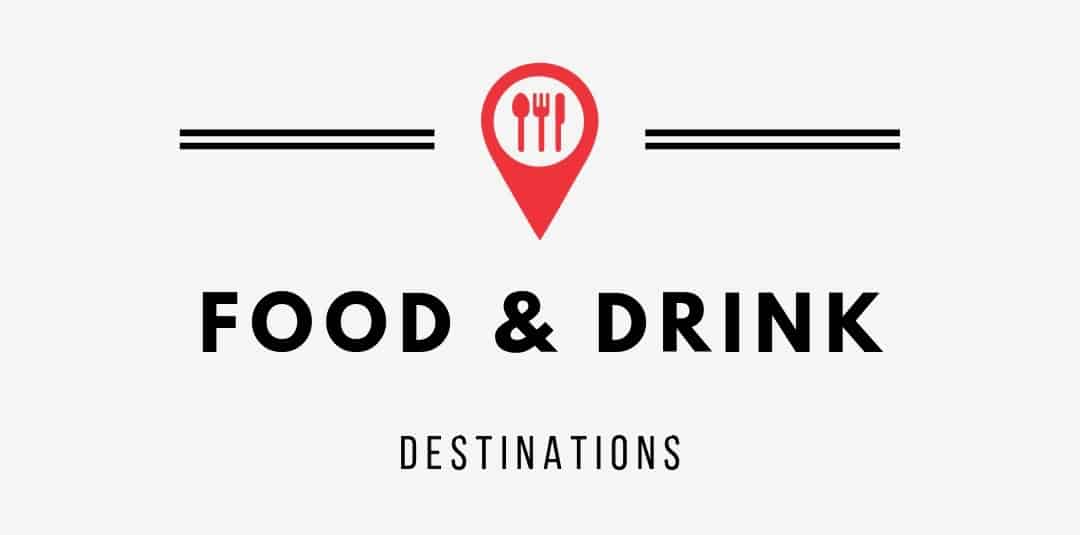
- Destinations
- Travel Guides
- For The Home
- Privacy Policy

Japan , Travel Guides
Food focused two week japan itinerary – 14 days of eating well.
We’ve taken several trips to Japan over the last decade, each time staying a bit longer and exploring a bit more than the last. I know many travelers don’t have the same flexibility in their schedules as we do. If you have the opportunity to spend two weeks in Japan, though, we want to ensure you eat well and drink well. Because Japan is one of the top culinary travel destinations in the world. In this post, I share our tips on how to plan a trip to Japan with a 14 day itinerary.
*This post contains compensated links. Find more info in my DISCLAIMER . As an Amazon Associate, I earn from qualifying purchases.
A 14 Day Trip To Japan For People Who Travel For Food
Most itineraries focus on the top Japan destinations, including Tokyo and Kyoto. There is always a focus on the “top things to see” and always includes plenty of visits to museums and temples. We include some of those activities in this guide.
But our real focus in this Japan travel blog is to focus on unique food experiences, those experiences that make Japan unique. This includes food tours , sake tastings, and plenty of recommendations on where and what to eat in Japan.
Another way this itinerary is different from others is that it goes beyond Tokyo and Kansai, which includes Kyoto and Osaka. Sure we include those cities as well. But our suggestions go a little bit beyond for a more authentic experience in Japan.
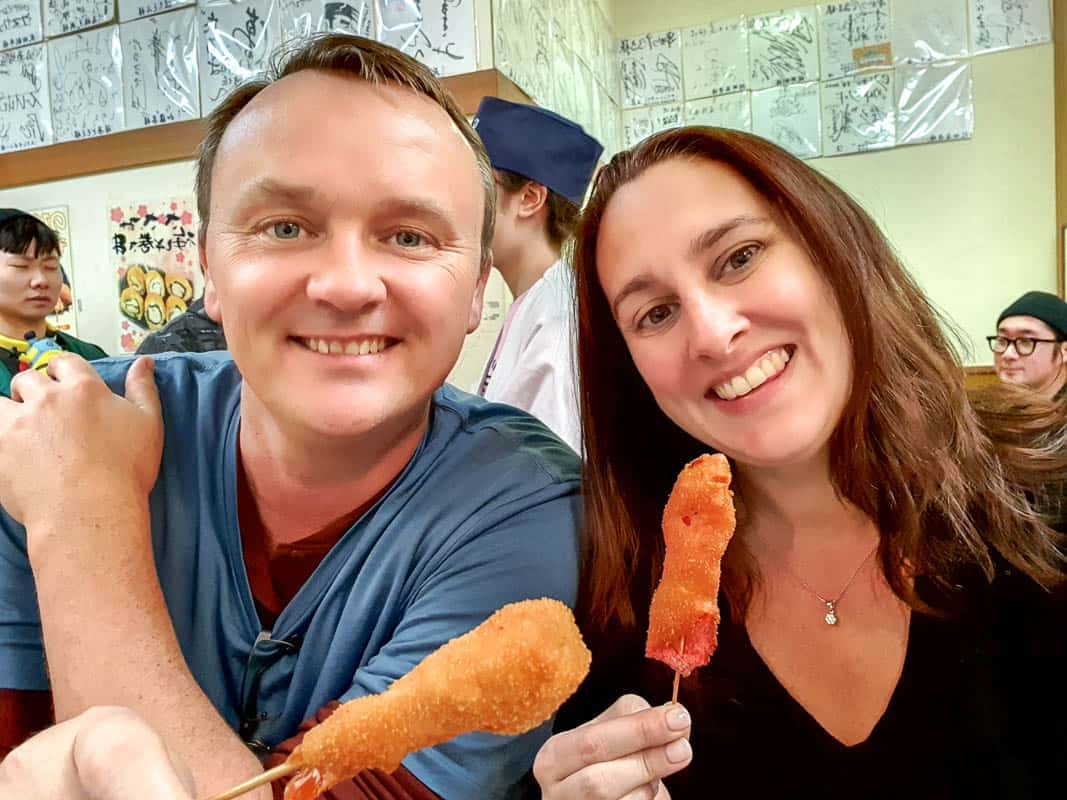
Only Have A Week In Japan? Check Out Our 7 Day Japan Itinerary
Help With Planning Your Japan Two Week Itinerary
Luggage : We used our Eagle Creek Load Warrior luggage for this trip. I always recommend packing light and if using the trains in Japan this is particularly important. Escalators and elevators are not readily available. And, most hotel rooms in Japan are pretty small. It can be hard to find space for large luggage! Even for a 2 week trip in Japan, it is possible to do laundry at least once or twice during your trip so it’s possible to pack light.
Rental cars : If you decide to rent a car in Japan, we recommend RentalCars.com . They compare prices at the top rental car companies to get you the best deal.
Rail Passes : Train travel is really efficient in Japan, particularly between our recommended cities. Check out the 14 Day Japan Rail Pass to help get you around. A rail pass must be purchased ahead of time before your arrival in Japan and is best purchased from Japan Rail Pass.
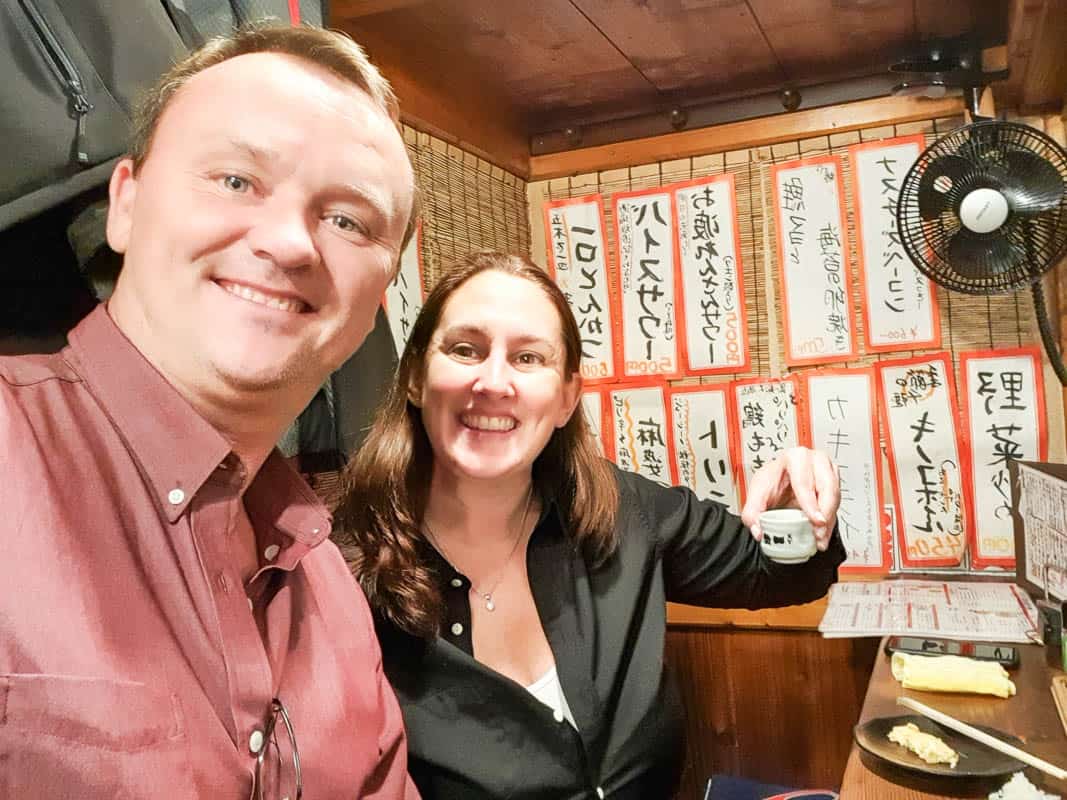
Eating at an izakaya in Kyoto
Best Japan Destinations For Food Travelers
Tokyo – Many travelers arrive or depart from Tokyo so it’s understandably on everyone’s itinerary. It’s a big city, with bright lights, and Japan to the extreme.
Osaka – The destination for food travelers in Japan. Known as Japan’s kitchen, Osaka is known for “kuidaore,” which essentially translates to eat until you drop or eat until you bankrupt yourself. This is why it’s one of our favorite cities.
Kyoto – The city of culture and temples, Kyoto is also one of the top sake producing regions in the country.
Wakayama – Just south of Osaka and Kyoto, Wakayama is often overlooked by travelers. It’s an easy addition to any Japan trip itinerary. It’s a destination with a focus on fresh fish and seafood, ramen, and Buddhist Monastery lodgings.
Kobe – The home of world-famous Kobe beef and easily visited as a day trip from Osaka or Kyoto.
Sapporo – The great white north of Japan and the city that is one of the snowiest in the world. It’s also home to its own unique cuisine unlike elsewhere in Japan.
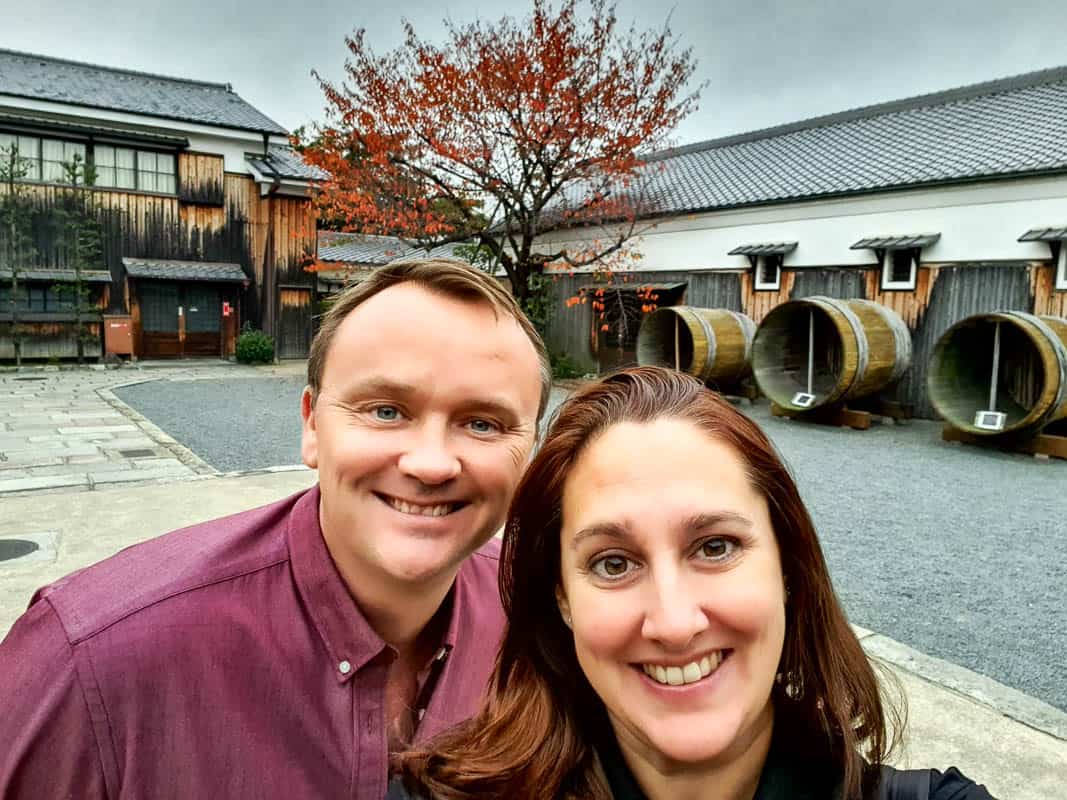
Visiting a sake brewery in Kyoto
Guided Tours Of Japan
We will provide tips on how to plan your own Japan 2 week itinerary, but I understand that Japan can be difficult to manage on your own. We have some recommendations for guided tours that included between 12 and 14 day itineraries.
Intrepid Travel offers a 12 day Real Food Adventure In Japan . It hits some of our favorite food cities in the Kansai region of Japan. That includes Osaka, Kyoto, and Kyosan in Wakayama. Along the way, travelers learn to make sushi , eat street food, and stay the night in a Buddhist monastery. These are all food experiences we’ve had in Japan and would totally recommend. We took an Intrepid Real Food Adventure in Morocco and learned a lot about the food culture. Learn more about Intrepid’s Japan tour .
As an alternative, G Adventures offers a small group tour for 14 days in Japan that departs from and returns to Tokyo. The Discover Japan Tour visits Tokyo, Kyoto, Hiroshima, and other interesting cities. There is more of a focus on culture and history than the Intrepid Tour but includes interesting food experiences. This includes visiting a sake brewery and dining in kaiseki cuisine in Kyoto. Learn more about the G Adventures Discover Japan Tour .

Eating ramen in Sapporo in Winter
Tips For Traveling to Japan For The First Time
Planning a trip to Japan for the first time can be entirely intimidating. That’s why booking a group tour can help. But, there are ways to plan an independent journey as well. We have a few key tips for first-timers to help make things easier.
Picture Menus Are Your Friend
When it comes to selecting restaurants in most touristy cities, we always recommend avoiding places with picture menus. This advice goes out the door in Japan. Many restaurants have picture menus, for both travelers and locals. The picture menus are your friend.
Almost every place we ate in Japan included picture menus with English descriptions. A few did not. Where they didn’t we relied on Google Translate to take pictures of the menu or to do an instant translation. But, this only works when you are online.
Japan Travel Guide Pro Tip
We use KeepGo for international data. It’s an international sim card that works in over 120 countries without setting up service in each country you visit. It doesn’t make a difference what kind of mobile service you have at home. You just register the sim before leaving home. It works on arrival in Japan. We had 4G access in Japan with KeepGo .
Japan Is A Cash-Based Society
Cash is still king in Japan. We were able to charge some meals, but most of the time we paid cash. This is particularly true in smaller places. We used ATMs to withdraw cash as we went. ATMs are not as easily found as in other cities. Look for them in the convenience stores like 7-11, Lawson, or Family Mart.
Don’t Try To Fit Too Much Into Your Itinerary
Imagine someone trying to see all of the US in a two week trip, impossible, right? Japan may be a smaller country, but there is so much to see and do. Even within a single city, there are loads of great activities, neighborhoods to explore, and food to eat. Don’t rush it and don’t try to cram everything into a short amount of time.
Our recommendations in this post make a great first time in Japan itinerary. In two weeks you can experience a lot of Japan, but I wouldn’t recommend visiting more than 4 cities. The movement in between, even with high speed trains, can be exhausting.
Also, consider basing yourself in a city like Osaka and taking day trips to Kyoto, Koyasan, Nara, and Kobe, to see a lot without the constant checking-in and checking-out of hotels and packing and repacking. You can access each of these cities in less than an hour from Osaka.

Visiting Temples In Wakayama
Food And Drink Experiences In Japan
There are loads of interesting and unique things to do in Japan. Some of these experiences relate to food and drink and others focus on culture and history. This is a great place to start your own Japan trip planner for how to spend 2 weeks in Japan.
- Visit a Robot Restaurant in Tokyo for one of the most unique dining experiences in the world
- Exploring traditional local markets including Kuromon in Osaka and Nishiki Market in Kyoto
- Tracking down the top street food in Dotonbori , Osaka’s food street
- Book a food tour in Osaka or a Kyoto cooking class to learn more about Japanese food culture on a half-day or full-day tour
- Eat some of the best Japanese sushi of your life, by visiting a conveyor belt sushi restaurant or a traditional sushi-ya
- Track down the best bowl of ramen in one of the official or unofficial ramen streets.
- Go Japanese craft beer bar hopping and learn about Japanese craft beer trends
- Enjoy a kaiseki meal at a traditional Japanese ryokan
- Spend the night at a Buddhist monastery and learn about shojin ryori, Buddhist vegetarian cuisine
- Eat some of the best beef in the world – Kobe beef
- Tour a Japanese sake brewery and learn how to order sake
- Spend the evening at an izakaya, a Japanese tavern, toasting over local beer and whiskey highballs
- Dine on Japanese giant crab and local seafood in the great white north of Japan
- Tour the famous Sapporo Brewery and dine on Genghis Khan

Eating sushi at a market in Osaka
How To Spend 14 Days In Japan When You Love Food
If planning your own self-guided tour of Japan, here are our recommended destinations. With a full two weeks in Japan, you can see a lot. There are two primary options here. We recommend about a half dozen cities to visit. It’s possible to visit each of them, spending approximately two nights in each.
Or, I would recommend staying in only about three cities and doing day trips. For example, you can stay in Tokyo, Osaka, and Sapporo and manage to have all of the experiences mentioned in this post over two weeks.
For each city, I recommend some of the top attractions or experiences, with a focus on food and drink. I also provide recommendations on what and where to eat and some recommended hotels. There are also links to some of our other posts for more information on some of these activities and travel tips.

Day 1-3 Tokyo
Most people start or end their trip to Japan in Tokyo. We prefer the smaller cities for more unique experiences and recommend spending more time there. At least give yourself enough time in Tokyo to beat the jet lag .
Top Attractions In Tokyo
Definitely check out the Shibuya district, one of the most iconic neighborhoods in Tokyo. If you’ve seen photos of Tokyo with loads of people crossing at a major intersection with neon lights and skyscrapers in the background – that’s Shibuya. It’s supposedly the busiest pedestrian crosswalk in the world. Stop for a katsu curry at Katsuya or hit one of the ramen or soba shops.
At night, head to the Shinjuku district, perhaps for a little karaoke and nightlife. Shinjuku is where the neon lights explode at night. There’s theater, food, bars, and plenty of people watching.
There are also two well-known bar and restaurant alleys in Shinjuku that are must-visits: Golden Gai and Memory Lane. It’s almost like stepping back in time considering much of Tokyo is covered in high-rises. Within this area is also Harajuku. This is where young people like to show off their fashion and old people like me are left to wonder why.
For a bit of culture, visit the Imperia l Palace or at least wander the gardens. Or, check out the art museums and galleries in the Roppongi neighborhood. This is also where the Tokyo Tower can provide you with a birds-eye view of the city.
Tours And Tickets For Tokyo
There are a few tours and attractions that we recommend booking ahead of time. Grab tickets for the Tokyo Robot Restaurant , one of the most popular and unique attractions in Tokyo. To make the most of your time in Tokyo, book a food tour. This Japanese Food And Drink Tour includes a tour of the world-famous Tsukiji Fish Market.
Where To Eat In Tokyo
In Golden Gai and Memory Lane sniff out late-night ramen and plenty of yakitori bars. In addition to Golden Gai and Memory Lane, there are a few other areas where you are guaranteed to eat well in Tokyo. Be sure to add a visit to Ginza for Michelin Star dining, including some of the most famous sushi restaurants in the world. Look for monjayaki in the Tsukishima district for Tokyo’s answer to okonomiyaki.
Where To Stay In Tokyo
We stayed at the Sheraton Miyako during our visit to Tokyo, but there are other options as well depending on your budget.
Park Hyatt Tokyo : One of the most luxurious hotels in the city and known for its role in the movie Lost in Translation. Check for rates here .
Pullman Tokyo Tamachi : A contemporary option in the center of Tokyo with a sun terrace. Check for rates here .
Nine Hours Shinjuku : On more of a budget, or looking for a uniquely Japanese experience, this capsule hotel is the perfect option. It’s also in the nightlife center of the city. Check for rates here .

Day 4-5 Osaka
I’m amazed to see how many sample Japan two week itineraries skip Osaka altogether. Sure, it doesn’t have the same concentration of temples and palaces as Tokyo or Kyoto, but you can only see so many temples on a trip before you get “templed out.”
Osaka is one of the best cities to visit if you love food and drink! From Tokyo, use the JR Rail Pass to hop the Shinkansen high-speed train to Osaka, Japan’s kitchen.
Top Attractions In Osaka
All of the top main attractions in Osaka are located within the city center and are accessible by train. Take a walk through the gardens of Osaka Castle or catch the view from a boat tour of the Dotonbori Canal. Explore Kuromon Market for street eats and hit Dotonbori, Osaka’s famous food street at night. At night, just wander through one of the many shopping and eating districts, including Namba, and Shinsaibashi.
Tours And Tickets For Osaka
If you want to make the most of your time in Osaka and want to experience all the main sights, pick up the Osaka Amazing Pass. It offers free admission to loads of different sites including Osaka Castle, plus offers unlimited train and bus rides as well.
Osaka is also the perfect place to take a food tour or cooking class. See our recommendations for the Best Food Tours In Osaka .
Or book tickets for Gotta. Gotta is pure Japanese-style entertainment. It’s a Japanese musical review show, which tells the story of the Dotonbori area through food and legend. Buy tickets ahead of time here . They offer three shows a day, with the last show being at 3:00 pm. The show is only 40 minutes, so it’s not a big time commitment. It’s just something quirky and unique to do in Dotonbori.
Where And What To Eat In Osaka
Between traditional Japanese dishes and Osakan specialties, there is no shortage of foods to eat in Osaka. From street food to craft beer, the city has it all. One of our favorite things to do in Osaka is to visit Daruma for kushikatsu, which is fried stuff on a stick.
Start any day eating in Dotonbori, near the canal. Then head north down the Shinsaibashi shopping street. At the top, in the Chuo Ward and near the Honmachi subway station, there are loads of great, non-touristy restaurants. On another night, head south from Dotonbori into the Namba area for plenty of standing bars and yakitori spots.
Check out these posts for more details and where and what to eat and drink in Osaka.
Osaka Food Guide – What To Eat In Osaka Japan
Dotonbori Food Guide – 15+ Must-Eat Dishes In Dotonbori Osaka
Osaka Craft Beer Guide – Drinking The Best Craft Beer In Osaka
Where To Stay In Osaka
When we visit Osaka we tend to stay a while and normally rent an Airbnb apartment. We’ve also stayed at the Sheraton Miyako . Here are some other recommended hotels in Osaka. If short on time, we recommend staying near Namba or in an adjacent neighborhood so that you are centrally located to all of the best foods.
Swissotel Nankai Osaka : Luxury, 5-star hotel, with views over the city. It’s located above the Namba station making it super convenient. Check current rates here .
Hotel Nikko Osaka : The Hotel Nikko is located in the Shinsaibashi shopping area and near the pedestrian shopping arcade that leads to Dotonbori. We’ve stayed near this neighborhood before and there are some great bars and restaurants nearby. Check current rates here .
Hotel Ichiei : For a more ryokan style experience, Hotel Ichiei is also near Namba Station and offers tatami style rooms. Check current rates here .
How Many Days In Osaka – Pro Tip
This is a question we often get. For any of our recommended Japan destinations, it’s up to you how much time you spend in each city. People often overlook Osaka, though, in favor of Kyoto. Kyoto is famous for its temples. Osaka is famous for its food and nightlife. We recommend spending more time in Osaka than in Kyoto if you love eating. Or, base yourself in Osaka for five or seven nights and visit Kyoto, Kobe, and even Nara from there. See the sites but enjoy the Osaka nightlife .
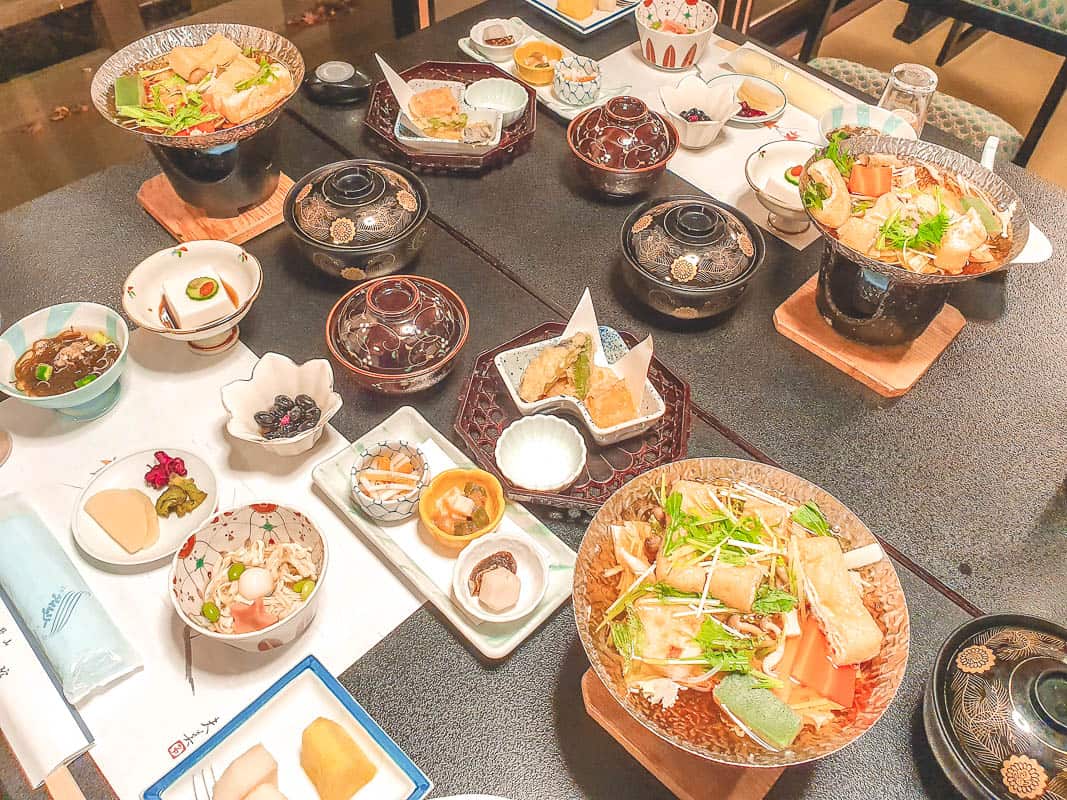
Day 6 Koyasan, Wakayama
If you can fit an overnight into your 14 day itinerary that will offer a totally unique experience, this is it. The Kii Peninsula in Kansai includes Kyoto, Osaka, and Wakayama.
Across the Peninsula are a series of Sacred Sites and Pilgrimage Routes, much like the Camino de Santiago in Spain. UNESCO recognized the region as a World Heritage Site. This makes Wakayama a perfect spot to spend the day hiking or exploring temples.
Wakayama is also a great destination for food travelers too. Koyosan is the center of Buddhism in Japan and is located within Wakayama. There are over 100 temples in Koyasan, about half of which provide temple lodging. One of the most interesting food experiences includes staying at a temple lodge in order to try their famous Buddhist Vegetarian Cuisine, known as Shojin Ryori.
Planning A Trip To Koyasan
You can train from either Osaka or Kyoto to Koyasan using the Japan Rail Pass. Once there, spend the afternoon exploring some of the famous temples. Also, take a walk through Okunoin, a famous Buddhis Cemetery. There are over 200,000 gravestones. It’s a beautiful and peaceful place to explore. (Please don’t take photos within the cemetery). There are a handful of restaurants that are known for vegetarian cuisine, which was even enough to fill Eric’s belly.
Spending The Night In Koyasan
Spending a night in the Mount Koya area is almost like an all-inclusive stay. Book at one of the temple lodgings. These are mostly simple places to stay for the night, normally with tatami-style rooms with futons on the ground. A shojin ryori vegetarian dinner is included. They do serve beer and sake, but we used it as a night to detox.
After dinner, head back to the temples to see them lit up at night. It’s quite peaceful. Then, it is time for bathing. Some of the temple lodges have private, western-style bathrooms. Others offer traditional Japanese bathing, which is sex separated, public, and nude. That alone is an experience.
It’s an early-to-bed experience. There is the option of observing a dawn ritual where the monks offer a service to practicing Buddhists. We stayed in a traditional lodge where we were the only foreigners. The entire proceeding was in a combination of Japanese and Sanskrit. As much as we didn’t understand a word, observing was fascinating.
Where To Stay In Koyasan
We recommend Jokiin , which offers all of the above experiences. They have a traditional Japanese public bath, but also offer some rooms with a private bath. All rooms are tatami-style, with futons on the floor. Book here .

Day 7-8 Kobe
Kobe City is located in the west end of central Japan. It’s a port town and hosts the 6th largest population in Japan. What most people know about Kobe is its namesake beef. It is also one of the top sake producers in the country as well. This makes it an interesting city to add to your two week itinerary.
Top Attractions In Kobe
Did you know that the Nada-Gogo, or the Five Regions of Nada, produces one-quarter of the sake in Japan. The Nada region includes Kobe, which makes Kobe the perfect place to learn about sake. They started producing sake in Nada over seven centuries ago. Try visiting the Kobe Shu-Shin-Kan Brewery, which is on the train line between Osaka and Kobe.
What To Eat In Kobe
Kobe beef is unique to Japan. The beef comes from a particular breed of cattle called Tajima-gyu. The cattle must be born and raised in the Hyogo Prefecture to be considered Kobe beef.
Eating Kobe beef in Japan is a bit of a ritual. Normally you sit at a counter and order the beef by weight and variety. The chef will often show it to you, sort of for approval, but really so that you can look and confirm the quality. The beef is cooked on a flat top grill, to rare or medium rare temperature. Organize your Kobe experience ahead of time, whether you stay in Kobe or visit as a day trip. Learn more here .
Where To Stay In Kobe
Check out the ANA Crown Plaza Kobe , which is part of the IHG hotel group. It’s close to the train station making it easy to explore the city and the surrounding area. Check rates here .

Eating Kitsune Udon In Kyoto
Day 8-10 Kyoto
One of the most popular cities for travelers to Japan, Kyoto is one of the best places to learn about Japanese culture. Kyoto means “capital city” because it once was the capital of Japan before it was moved to Tokyo. We tend to prefer the culinary scene in Osaka more, but there is still loads of good food in Kyoto.
Top Attractions In Kyoto
There are 17 UNESCO World Heritage Sites in Kyoto alone. There are hundreds of Shinto Shrines, loads of Buddhist temples, and Japanese gardens. Check out the Imperial Palace , which is free for travelers to wander through and take in all of the splendor of an ancient way of life in Japan.
Gion is one of the most popular neighborhoods to visit. It’s known for its Geiko, or geisha, culture. It’s one of the most well-preserved parts of the city with ancient houses and adorable alleyways. It is also one of the most touristy parts of the city, so be prepared.
Fushimi Inari-taisha S hrine is another popular destination and is just a short ride from Kyoto Station by train. After visiting the temples continue a little further south to the Fushimi Sake District, the sake producing area of Kyoto. There is a brewery tour and plenty of shops selling sake and offering tastings. It makes a great afternoon out of the center of Kyoto.
Tours And Tickets For Kyoto
Looking for the perfect Japanese Instagrammable moment? Book a Kimono rental for a day and then head to the temples or the narrow alleys of Gion for photos. Book a rental here .
If you love sake and want to learn more about it, check out this Sake Brewery Tour and Tasting .
Or, book an evening Food Tour in Gion and Pontchoco . See all of our recommended Kyoto Food Tours here.
What To Eat And Drink In Kyoto
Kyoto is known for its kaiseki and Buddhist vegetarian cuisine. There is also a great ramen scene. For food travelers, there’s Nishiki Market and the surrounding neighborhoods and alleyways near Shoji Jori, the main shopping street.
At night, head to Pontocho Alley, which runs along the river, west of Gion, for some of the best restaurants in the city. For someone on a budget, check out Kyoto Ramen Alley, which is actually on the 10th floor of the Kyoto train station.
Check out these related posts :
Kyoto Food Guide – What To Eat In Kyoto
How To Find The Best Ramen In Kyoto
Where To Stay In Kyoto
Like Osaka, Kyoto is also pretty easy to travel around. We stayed at the Westin Miyako Kyoto , which is lovely, with views over the mountains and the city. We’ve also stayed at a very simple guest house near the Imperial Palace. Here are some other recommended hotels in Kyoto.
Luxury Hotel Sowaka : Located at the southern edge of Gion, this is the epitome of Japanese luxury, with well-appointed rooms in a ryokan style. Check the best rates here .
Park Hyatt Kyoto : For luxury accommodations of a more western standard, Park Hyatt Kyoto is one of the top hotels in the city. Check the best rates here .
Mimaru Kyoto Horikawarokkaku : A four-star hotel in the center of some of the best eating in Kyoto and close to the Nishiki Market. Check the best rates here .
Help With Transit
If Kyoto is your last destination, then it is possible to fly out of Kansai Airport. Kansai is actually closer to Osaka, but still easy to access by train from Kyoto. Or, you can book a limousine bus from Kyoto here .
Also, consider picking up a transit pass for Kyoto. This pass can be purchased for one or two days and can be used in both Kyoto and Osaka. Learn more here .

Day Trips From Osaka (Or Kyoto)
We are not huge fans of checking in and out of hotels every couple of days. It gets exhausting. It also gets in the way of our eating. One way to be more efficient when planning a Japan travel itinerary for 14 days is to pick either Osaka or Kyoto as a home base and to see several sites and cities.
For food travelers, we definitely recommend Osaka as a home base. You can take a day trip to Kyoto to visit Gion, Fushimi Inari-taisha Shrine, and other spots all in one day. The fast train takes 14 minutes between the cities. The cheaper rapid train takes 24 minutes. Both are included in the Japan Rail Pass.
You can be back to Osaka in order to take advantage of the nightlife there. Accommodations in Osaka also tend to be less expensive.
Other Side Trips
Regardless of which city you base yourself in, you can spend four, five, or even six nights over a two week stay in Japan in either city and see a lot. Here are a few of the cities you can explore as a day trip from Osaka or Kyoto. If you don’t want to spend two nights in Kobe, it is also possible to do as a day trip from either Osaka or Kyoto.
Nara is located just between Osaka and Kyoto. There are a good number of ancient temples, but it is most known for the deer that roam the city. It’s also home to Tōdai-j, a Buddhist temple complex with one of the largest Buddha statues in Japan.
Another side trip is to Himeji Castle and then to Miyajima. Miyajima, or Itsukushima, is a famous temple located on an island in Hiroshima Bay. There is the famous Great Torii Gate, which is an orange gate surrounded by water.

Eating ramen in Sapporo in Hokkaido
Day 11-14 Sapporo
We just made our first trip to Sapporo and it was in the winter. Yes, it snowed. Even though we don’t like the cold, we loved our time in Sapporo and would definitely recommend adding to a 14 day Japan itinerary. Yes, you need to take a domestic flight there, but you can also book international flights from Sapporo to head home.
If heading to Sapporo in winter , be prepared for cold and snow. But that also means fun snow sports and skiing. The summers are warm, but not as hot as down south. The most important thing, the Hokkaido region is entirely unique within Japan and worth a visit.
Top Attractions In Sapporo
Many of the top things to do in Sapporo are located within the city center. This includes all of the best places to eat. It’s possible to walk to many of them. If heading a little further afield, the train is easily accessible. Just at the edge of the city is a town filled with onsen , the traditional Japanese hot springs. Learn more here .
Tours And Tickets For Sapporo
There are a couple of interesting activities for food travelers to Sapporo. First, check out the Sapporo Beer Factory and the Beer Garden. After a tour of the factory, enjoy a meal of the famous Genghis Khan in the garden. Learn more here . If looking to try Hokkaido’s world-famous crab, book a crab eating experience in Sapporo.
What To Eat And Drink In Sapporo
The main reason why we think Sapporo is worth a flight up north is that the food is so different and so great! Hokkaido is known for crab and other seafood. There are also a handful of dishes that are unique to the region. This includes ramen made with corn and butter, Genghis Khan, which is a lamb BBQ, and soup curry. Read more about all the great food in Sapporo here:
Sapporo Food Guide – What To Eat In Sapporo Japan
Finding The Best Ramen In Sapporo – Ramen Yokocho And More
Where To Stay In Sapporo
I recommend staying in the Susukino neighborhood of Sapporo. We stayed at the Mercure Sapporo in Susukino and couldn’t have been happier with our decision. The Mercure Sapporo is a 15-story contemporary high-rise hotel with French influences and is part of the Accor family of hotels.
The Mercure Sapporo is close to all of the best places to eat in Sapporo. It’s right in the heart of Susukino and only a few blocks away from ramen alley and Nijo Market. This was perfect for us, and really anyone who visits Sapporo. You can eat all of the best foods in Sapporo without traveling more than a few blocks from the hotel.

Hokkaido in winter
When Is The Best Time To Visit Japan
Japan is a year-round destination. Being a long country, there are a variety of climates. In the north, in Hokkaido, you have some of the top ski destinations in the winter. In the south, in Okinawa, there is a more tropical climate where it is warm in the winter.
This 14 day Japan itinerary focuses on Tokyo and the Kansai region, in the center of the country. But it also includes Hokkaido in the north. In the center of the country, expect warm summers and cold winters.
Top tourist sites in the summer can be crowded and hotels are more expensive. Winter is relatively mild, even when it snows. Tourist sites are less crowded and hotels are less expensive. The shoulder seasons of spring and fall are probably the best times to visit Japan, with one major exception. Cherry blossom season is in the spring, normally in April, and can be beautiful, but is considered the high season.
Winter In Japan
We’ve been to Japan twice when it was snowing and we don’t like the cold. But, it can be peaceful and beautiful visiting Japan in winter.
They do get some snow in the center of the country, but we’ve visited in Japan in both autumn and winter and found it warmer than expected for several days. The temperatures can change dramatically where it is warm one day and cold the next.
Hokkaido, in the north, has cooler summers but the snowiest winters in the world. If you love the cold and snow, definitely consider Hokkaido. If traveling to Japan in the winter, and you don’t like the snow, perhaps stay longer in the center of the country.
To better understand what it’s like to travel in Japan in the winter, check out these posts:
Top Things To Do In Sapporo In Winter
Getting To Japan
Many airlines fly directly to Japan. There are two airports in Tokyo. Narita is the largest but is farther from the city. Haneda is smaller, and closer to the city, but offers fewer international flights. Kansai Airport serves both Osaka and Kyoto. All of these airports are accessible by bus and train. Sapporo also has an international airport with plenty of flights.
There are two primary Japanese airlines that service these airports: ANA (All Nippon) and Japan Airlines (JAL). We’ve flown them both and they are reputable airlines. Other international airlines also service Japan.
Because train travel is so easy in Japan, it might help and it might save time, to fly into Tokyo and out of Kansai in Osaka or Sapporo in Hokkaido. This will help maximize your time on the ground, particularly if you are only limited to a two week trip.
Choosing An Airport In Japan Pro Tip
Sapporo only has one airport. Tokyo has two airports (NRT and HAN). The area around Osaka and Kyoto is also served by two airports (KIX and ITM). Just be sure to pay attention to which one you are booking. In each case, one is farther out from the city than the other. It’s most important when you are transferring back to the airport so you choose the right one. Trust us. We chose the wrong one in Osaka! Luckily we still made our flight in time.

How to Get Around in Japan
We’ve never rented a car in Japan. We’ve never found a reason to, particularly with this itinerary. There is so much to do, see, and eat within the cities or during day trips from the big cities.
Really, the best way to get around in Japan is by rail. Japan Rail offers a few different rail passes for either 7, 14, or 21 consecutive days. The rail pass is valid on all Japan Rail trains, including the high-speed trains (Shinkansen) between Tokyo, Kyoto, and Osaka.
The most important thing about the Japan Rail Pass is that you much be a resident of a country other than Japan. And you must purchase the rail pass before arriving in the country. They will actually mail you a rail pass so be sure to purchase it early.
If heading to Sapporo, it’s best to fly. Both ANA and JAL fly between Kansai near Osaka and Sapporo. It’s not all that expensive if you book ahead.
Learn more about Japanese food in our post about the Best Japanese Snacks To Try .
FAQs – PLANNING A JAPAN 14 DAY ITINERARY
This is a question we get about almost every destination. If you are American it is hard NOT to tip because it is so customary and even expected at restaurants and bars. Tipping is not customary in Japan. It can even actually be considered inconsiderate to leave a tip. It’s just better not to. In this case, it’s best to abide by the local culture and norms.
This is a hard question to answer because we understand a lot of people, particularly Americans, don’t have a lot of vacation time. Being able to spend a full two weeks in Japan gives you an opportunity to really experience the country. If you only have a week, see this post on how to make the most of your time.
It is no secret that Japan is an expensive country, but there are ways to spend money. It’s certainly possible to find accommodations is most cities for less than $100 a night. Meals can be expensive, but it is also possible to eat many meals for about $10-15 a person, even sushi! It is possible for two people to travel to Japan for between $100-150 a person and travel quite well.
Despite being a relatively small country, Japan is a highly diverse country. This makes it a year-round destination. In Winter, there’s skiing around Sapporo. Okinawa and the southern islands are great for a summer beach getaway. The Spring and Fall offer nature lovers stunning natural beauty.
Amber Hoffman
Amber Hoffman, food and travel writer behind With Husband In Tow, is a recovering attorney and professional eater, with a passion for finding new food and drink destinations. She lives with her husband, Eric, in Girona, Catalonia, Spain. Together over the last 20 years, they have traveled to over 70 countries. Amber is the author of the Food Traveler’s Guide to Emilia Romagna. She regularly lectures on social media marketing to travel professionals throughout Europe.
Leave a Reply Cancel reply
Your email address will not be published. Required fields are marked *
Save my name, email, and website in this browser for the next time I comment.
Popular Recipes
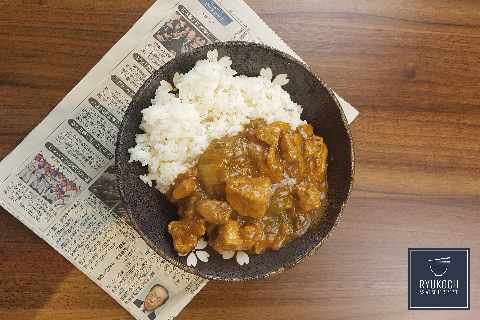
Kare Raisu Japanese Curry
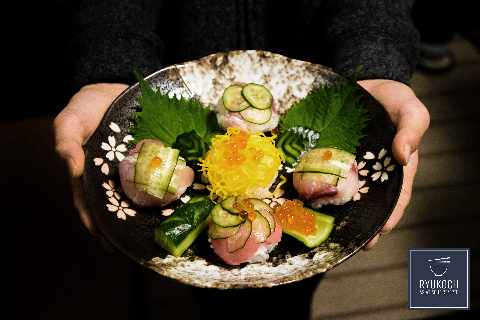
Temari Sushi Round Sushi Ball
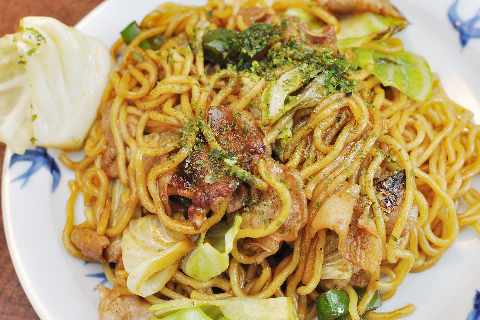
Yakisoba Stir fried noodle
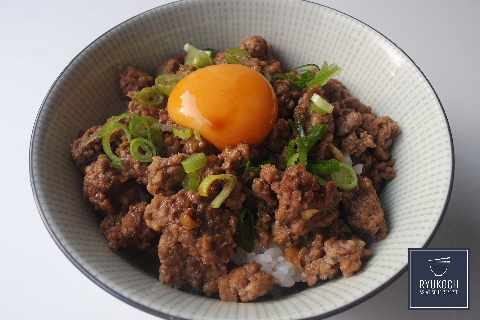
Soboro Don Japanese Rice Bowl Dish
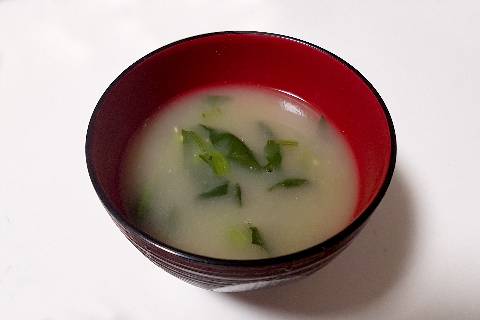
Miso Shiru japanese miso soup
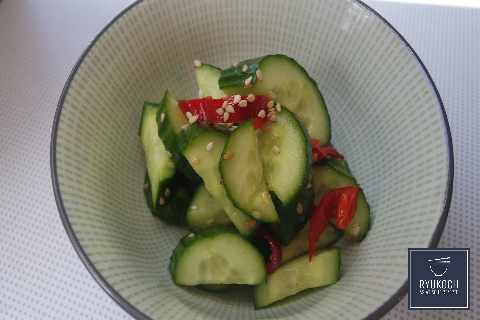
Asaduke Cucumber Salad Fresh and Tasty
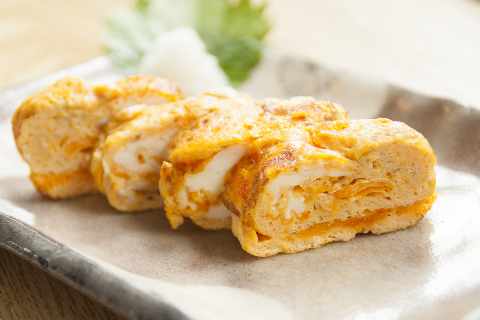
Tamagoyaki japanese Egg Roll
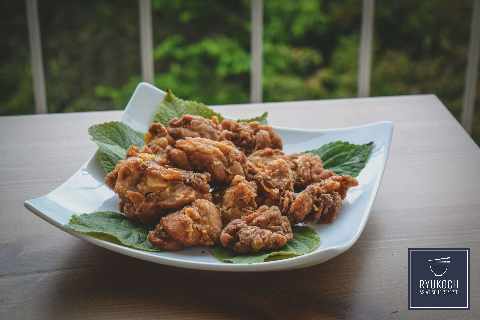
Karaage Japanese fried chicken
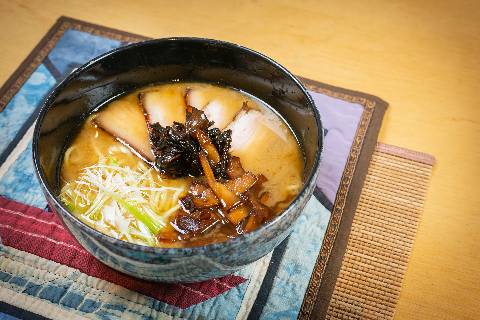
Ramen Japanese Noodle Soup
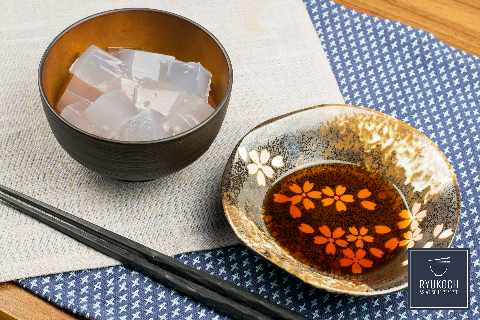
Tokoroten Cubes Japanese Low Calorie Dish
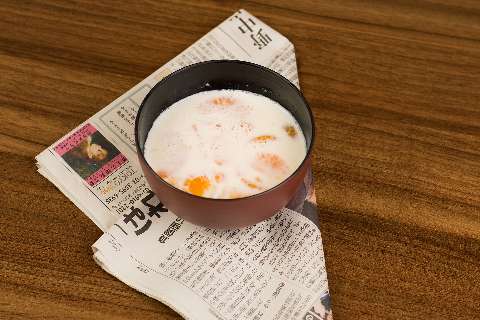
Kanten with milk and clementines Japanese Dessert
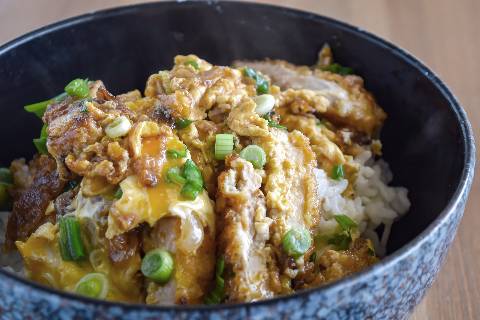
katsudon Japanese Steak Rice Bowl
New blogposts.
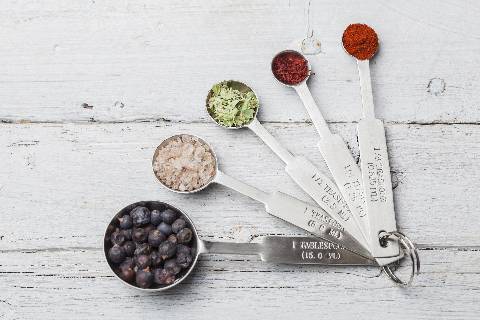
Kitchen Measurements In US and Europe System
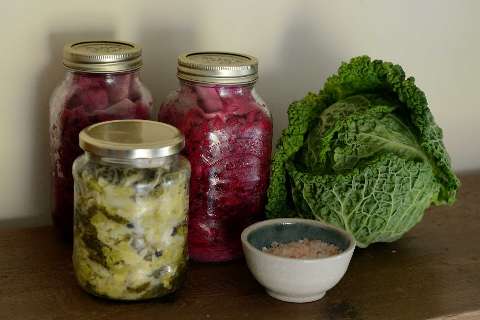
How To Ferment Your Vegetables Everything You Need To Know
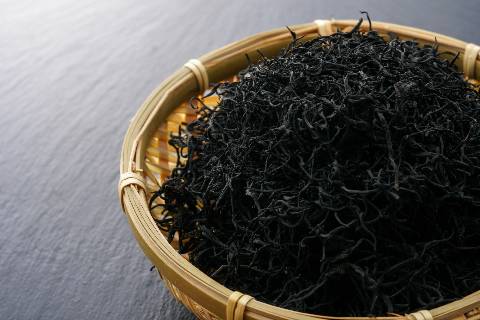
Hijiki Alga Salad
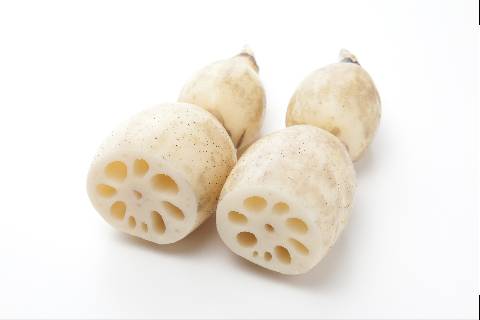
Renkon Lotus Root
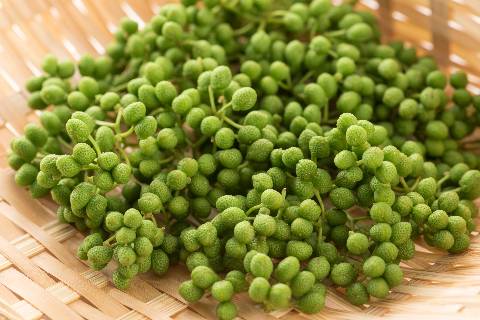
Sanshou Japanese Pepper
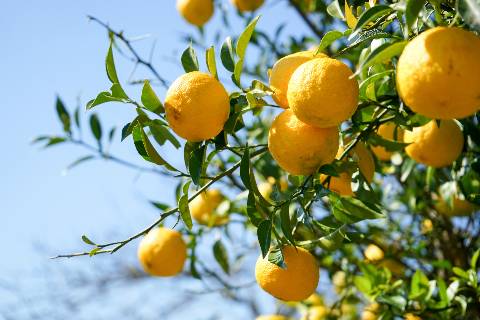
Yuzu Citrus Fruit
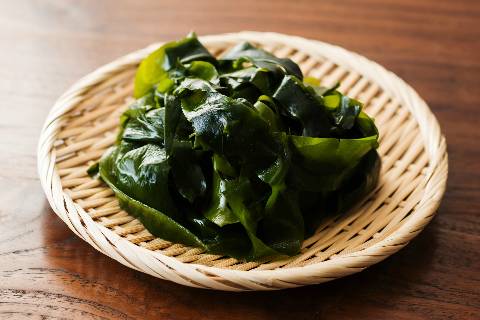
Wakame Edible Alga
Table of contents:, ryukoch japanese food and japan travel blog: your ultimate guide to japanese culinary and travel tips.
Welcome to my RyuKoch Japanese food and Japan travel blog ! Here it's all about the fascinating world of Japanese culinary and travel tips for unforgettable experiences in Japan. Get inspired by traditional and trendy Japanese recipes as well as valuable tips for your next stay in the land of the rising sun.
Japanese cuisine: recipes, spices and kitchen helpers
Japanese cuisine is known for its diversity, its healthy ingredients and the special harmony of the four flavors. In my blog you will learn everything you need to know to prepare delicious Japanese dishes yourself. I'll show you helpful tips and tricks for cooking, introduce you to the basics of Japanese cuisine and present you my favorite recipes.
But that's not all: dive into the world of Japanese spices that make up the distinctive flavor of this fascinating cuisine. Get to know the Japanese kitchen helpers that make it easier for you to prepare authentic dishes. Discover the diverse flavors and let yourself be enchanted by the Japanese art of cooking.
Travel in Japan: tips and recommendations for unforgettable experiences
Japan is a country full of history, culture and breathtaking landscapes. For many tourists it is a dream destination that offers unforgettable experiences. But traveling to a foreign country can also be challenging, especially if you don't know your way around. Therefore, it is my concern to give you helpful tips and recommendations für your Japan trip to the hand.
In my travel blog you will find information about the best sights, cultural highlights and scenic beauty of Japan. No matter if you are interested in temples, shrines, gates, modern architecture or the vibrant city life – here you will find what you are looking for. In addition, I will give you valuable advice on accommodation, transportation and other aspects that are important for a successful stay in Japan.
Let my RyuKoch Japanese Food and Japan Travel Blog inspire you and plan your next trip to the fascinating land of the rising sun. Discover the secrets of Japanese cuisine and dive into the world of Japanese culture and tradition. Have fun exploring and enjoying!
Miau, do i have your attention? I feel hungry, because Ryu is not feeding me. Please give me some delicious rating onigiris, if you like this page. ~Akina
Leave a Comment
Yummy recipes.
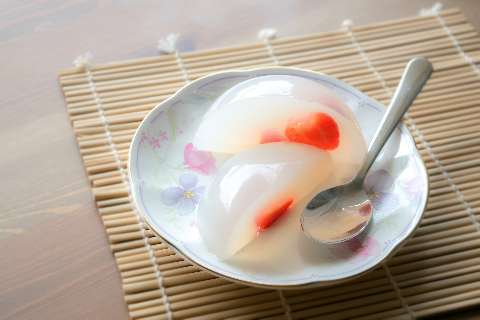
Kanten with strawberries Cute japanese Dessert
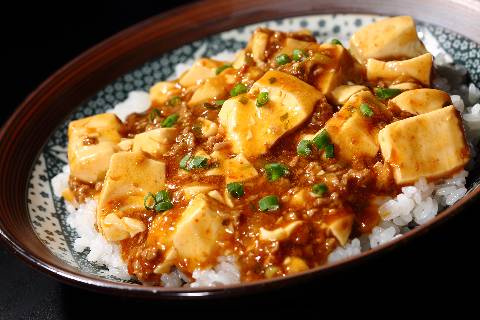
Mapo Tofu Japanese Version
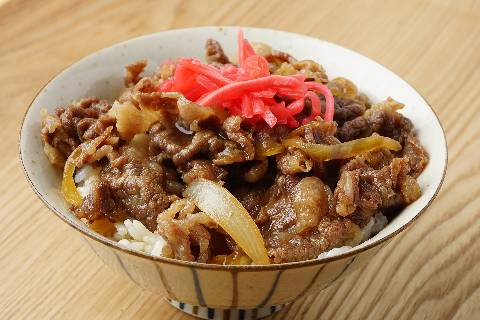
Gyudon Japanese beef doner
Interesting blog posts.
40 Must Try Foods in Japan
Conveniently listed in alphabetical order, here are the top 40 foods in Japan you need to try on your next trip to Japan!
- Japanese Curry
- Kaiseki Ryori
- Okonomiyaki
- Shabu Shabu
- Shojin Ryori
To kickstart your tastebuds with Japanese cuisine, the humble bento box is a great place to begin if you enjoy trying different delicious morsels of food. Bento boxes are lunch boxes in Japan that are generally divided up into different compartments, each with different bits and pieces to eat. Perfect for on-the-go scenarios, generally a bento will include some protein and rice, plus a range of side dishes like pickles and salads. You can easily purchase them at convenience stores, larger train stations, or department store food courts.
Try making your own bento in one of byFood's Bento Cooking Classes !
Donburi is the overarching word in Japanese for “rice bowl.” You can order a range of donburi rice bowls with different toppings, depending on your preference. “Katsu donburi” or simply “katsudon” is one of my favorite donburi bowls in Japan, featuring rice covered with a slab of panko-crumbed and deep-fried pork cutlet surrounded by a soft, soy sauce-flavored omelet with sauteed onions. Oyakodon is a popular variant simmered with chicken and eggs, meaning "mother and child". It’s a delicious and easy lunch when you’re out for a day being a tourist.
Fugu is the Japanese word for pufferfish ! If you’re game enough to step up to the plate, Japan is one of the best places in the world to enjoy this deadly but delicious fish. Many specialty restaurants in Japan have qualified chefs who can prepare the fugu in various ways such as deep-fried or freshly sliced and served as sashimi.
Originally introduced to Japan from China, gyoza is the word for dumplings in Japanese. Typically filled with a mix of meat or veggies and the right seasonings, these bite-sized dumplings are crunchy on the outside and juicy on the inside. Cooked to perfection on a sizzling hot plate, gyoza goes perfectly with a cold glass of Japanese beer or a steaming bowl of ramen.
Learn how to make gyoza yourself in a Gyoza Cooking Class !
Translating to mean “beef bowl,” gyudon is a rice bowl topped with juicy strips of thinly sliced beef and onions simmered in a sweet soy sauce flavor. With scallions, pink pickled ginger and an oozy onsen-style soft-boiled egg on top, it’s a hearty, homey and affordable meal in Japan you can find sold at many Japanese fast food chain stores. Just order from a vending machine and sit down alongside salarymen having a quick bite to eat after a long day at the office.
Join this Japanese Beef Bowl Experience to create your perfect gyudon.
6. Japanese Curry
The concept of curry was introduced to Japan in the Meiji era. Since then, Japanese curry has evolved into its own special dish with a local twist. With a gently spiced flavor and gravy-like texture, Japanese curry consists of a fluffy bed of rice doused in a generous serving of deep brown Japanese curry roux. Sometimes served with potatoes, carrots, and meat in the curry, it pairs well with a side of pickled ginger to cut through the rich curry flavor.
You can buy instant Japanese curry roux and easily make it yourself at home, too.
7. Kaiseki Ryori
Kaiseki Ryori or kaiseki cuisine is an opulent banquet-style meal in Japan. If you’ve got some cash to splash, it’s a wonderful experience featuring a series of individual Japanese dishes served up throughout the meal. Served with beauty and an essence of tranquility, each dish focuses on a different cooking technique such as frying, simmering, raw and more. Often set in a tatami room or a luxury restaurant venue, menus are carefully designed by the chef and the ingredients of a kaiseki meal are usually influenced by seasonal and local ingredients.
8. Kaisendon
With “kaisen” meaning “seafood” and “don” referring to “bowl”, a kaisendon is a rice bowl in Japan that’s topped with fresh, raw seafood. Best enjoyed at bustling seafood markets, these rice bowls can have a mix of seafood sashimi slices placed delicately on top of the bowl, or you can order ones that focus more on one ingredient such as salmon or fatty tuna.
Karaage is Japan’s fried chicken! With a moreish seasoned batter to encase the succulent chicken, it crisps up perfectly in a deep fryer while keeping the chicken inside moist and juicy. A delicious snack at any time of day or night to munch on (best with a frothy Japanese beer), karaage is an accessible and tantalizing food for everyone!
Matcha is Japanese green tea, typically founded in tea houses and whisked up to be served during a Japanese tea ceremony. While being a cultural drink, you’ll also find many matcha-flavored sweets throughout Japan such as mochi, ice creams, cookies, and more! No longer bitter when balanced with sugar, it can be divisive or delicious, depending on the tendency of your tastebuds.
The best way to enjoy match is by attending a Japanese Tea Ceremony .
11. Miso Soup
Made using fermented soybeans, warm miso soup is a common accompaniment to most meals in Japan. Somewhere between a clear and cloudy broth, miso soup will sometimes also have pieces of tofu, scallions or other additions floating around in it. Some ramen dishes will feature a miso-heavy soup broth as well, and red miso is particularly famous in the city of Nagoya with their rich slathering of miso on all sorts of dishes.
With both sweet and savory types you can try, mochi is the blanket word for “Japanese pounded rice cakes.” There are many types of such sweets including plump, sweet red bean-filled daifuku mochi pieces, triangular yatsuhashi style mochi from Kyoto, or kinako mochi sprinkled with pale brown powdered soybean dust.
Unsweetened mochi can be eaten with soy sauce and nori seaweed, or softened in miso soup. It’s a versatile but essential Japanese food you should try if you like its stretchy and chewy texture.
Make your own squishy treats in a Mochi Making Class .
13. Monjayaki
Monjayaki is the more liquidy cousin to okonomiyaki, the traditional savory cabbage pancakes that hail from the Osaka-Kansai region. With a similar but runnier batter, monjayaki is a mix of cabbage, meat and other finely cut ingredients sizzled on a teppanyaki hotplate. These savory pancakes have a different, finer texture to regular okonomiyaki slabs.
“Nabe” is a simmering Japanese hotpot . It’s a fun group activity where a communal hotpot stands in the middle of the table, bubbling with a rich broth brimming with your favorite ingredients. The broth becomes richer over time as more ingredients get added, and you can continue to top up the simmering ingredients as you go. Soy sauce, miso and other milky style broth flavors make nabe different every time.
Not for the faint of heart, natto is a healthy and nutritious Japanese food that can be divisive for its sticky, stretchy texture. Almost nutty in essence, natto is actually made from soybeans fermented with a special bacteria which gives its signature stringy characteristic. Natto is commonly eaten for breakfast in Japan with rice and sometimes a raw egg. Its taste and smell is certainly acquired, but certainly something unique and full of protein to start your day in Japan.
Simmered in a light soy sauce broth, oden is a seasonal Japanese dish that consists of a range of fish cakes and meatballs. Eaten as a light, umami-rich broth with your favorite type of fish cakes, it’s warming yet bright. You will often find oden available at festivals or convenience stores in a sort of Japanese bain marie, with all the different items warming in their soup. You can choose what you like, pour yourself some soup, and pay per piece.
17. Okonomiyaki
One of the most important dishes from Osaka, okonomiyaki are Japanese savory pancakes. Incredibly moreish and fun to sizzle on a hotplate at a cook-it-yourself restaurant, okonomiyaki is generally made from a batter of eggs, cabbage, bamboo shoots, tempura pieces, scallions, pickled ginger, and your choice of protein.
Mixed with flour and grilled in large circles, you can cut them like pizza slices once they’re flipped and cooked through. Best topped with mayonnaise, okonomiyaki sauce, more scallions and katsuobushi bonito flakes, okonomiyaki are a must-eat in Japan.
Okonomiyaki is an easy recipe perfect for beginners to Japanese cooking. Learn how to make one yourself in an Okinomiyaki Cooking Class .
18. Omurice
Omurice is a warming meal that appeals to all ages. Meaning “omelet rice,” omurice is a bed of tomato-sauce-based fried rice wrapped in a soft, eggy omelet. Add more tomato sauce or a drizzle of demi-glace over the top and voila! It’s ready to be enjoyed by the whole family, and normally eaten with a spoon.
19. Onigiri
A perfect snack for travelers on-the-go, onigiri are rice balls wrapped in nori seaweed. Easily bought individually apiece from a specialty onigiri shopfront or at a 7-Eleven convenience store, you can unwrap one neatly parcelled piece and enjoy the rice filled with all kinds of fillings like salmon, konbu seaweed, tuna mayo, teriyaki chicken and more.
Originally hailing from China, ramen is now a signature and favored dish in Japan for its versatility and ample ingredients, ramen is ideal to feed a hungry salaryman or weary traveler. The broader term for noodle soup, "ramen" usually consists of a broth, noodles and carefully designed toppings. The main topping ingredients can change as well as the broth to complement each other, often depending on the restaurant’s specialty.
Typical flavors include soy sauce, miso, or tonkotsu (pork bone broth), and a sliver of rich chashu barbeque pork never goes astray. Whether its in a tiny 5 seater restaurant or a cup noodle, ramen is a must-eat in Japan anywhere you go!
The best way to try a variety of ramen is on a Ramen Tour !
21. Sashimi
Japan is known for serving up some of the best raw fish in the world, so you have to try sashimi if you’re a keen seafood eater! Sashimi is the word for raw fish, covering many types from salmon and tuna to mackerel and kingfish. Freshly sliced, sashimi in Japan is always prepared to a high standard and just melts in the mouth. Perfect when enjoyed as juicy slices on their own or enhanced with a lick of soy sauce or a dab of wasabi.
22. Shabu Shabu
Named after the onomatopoeic phrase in Japanese for the swooshing sound of liquids splashing, “shabu shabu” is a special type of Japanese hotpot. It’s a fun group activity, where a hotpot stands in the middle of the table over a burner filled with a delicious broth. Using chopsticks to dip their ingredients, diners add different thinly sliced meats and vegetables to the broth and cook as they go. The soup gets richer as more ingredients are added, and best of all, you can pick and choose to eat what you like!
23. Shojin Ryori
Fully vegan, “shojin ryori” is Buddhist cuisine eaten by Buddhist monks in Japan. Best enjoyed as part of a humbling temple experience, Shojin Ryori is often served as a set banquet with many small dishes to try. Including different pickles, vegetables and other plant-based ingredients, shojin ryori is textural, spiritual and seasonal.
Soba is a type of Japanese noodles made from buckwheat. With a dense texture and a gray-ish color, soba noodles are delicious either when they're served up in a rich, warm broth at winter time or cold and dipped in soy sauce in summer. They’re especially satisfying when made freshly and quickly cooked. Note that soba are also full of antioxidants and health benefits.
Try making these healthy noodles from scratch in a Soba Cooking Class .
25. Sukiyaki
Boiled in a signature broth that's rich and sweetened, sukiyaki is a special type of hotpot with thin strips of meat and vegetables. Even better when made with high-quality wagyu beef, the strips are simmered in the broth till lightly cooked, then dipped in beaten raw egg before being eaten! The coating of tamago (egg) gives a rich texture.
Available in many delicious formats, sushi is one of Japan’s signature foods! From rolled maki sushi to hand-pressed nigiri sushi, these are just some types of sushi you'll find made from freshly sliced fish and seafood, served beautifully in bite-sized pieces with rice. Whether they're skilfully sliced before your eyes by a personal chef during a sushi omakase dining experience , or picked up plate by plate at a 100 yen sushi train, you have to try sushi in Japan, especially if you love fish and seafood.
For those who don’t eat seafood, there are lots of vegetarian or non-seafood meat sushi options like egg, cucumber, avocado, or beef options.
27. Takoyaki
Famous street food from the Osaka and Kansai region, takoyaki is a must-eat in Japan for anyone with an adventurous palette! They’re individual balls made from a rich batter that's sizzled over special rounded griddles. Each is filled with tempura pieces, scallions, pickled ginger and pieces of tako, which is the Japanese word for octopus! Oily, morish, and molten on the inside, takoyaki balls are best enjoyed with a generous squirt of mayonnaise and a rich brown sauce made from soy sauce and worcestershire. Not to forget the wiggling katsuobushi dried bonito flakes sprinkled over the top, dancing in the heat!
28. Teishoku
A “teishoku” is a classic set meal in Japan, usually including a main protein and several side dishes served together on one tray. It’s based on the traditional meal of “ichiju-sansai” meaning “one soup, three sides,” which includes rice, miso soup, and three sides (such as various pickles). Nowaways, teishoku is a convenient meal set served at restaurants and cafeterias around Japan.
29. Tempura
A treat for the whole family, tempura is Japan’s answer to all things deep-fried. Tempura batter in Japan is famous for being somehow so light yet perfectly crispy, and can encase all of your favorite ingredients from meat to seafood to veggies. Iconic tempura pieces include pumpkin and prawns, best enjoyed both at upscale restaurants and casual lunch joints as part of set menus or single tempura rice bowls.
Try a variety of tempura in a premium dining experience .
You’ll find tofu everywhere in Japan. Characteristically textural and made from fermented soybeans, tofu is made into all shapes and forms. Firm or silken tofu are common in many dishes, and used in both savory and sweet dishes from tofu doughnuts to little pieces swirling in your miso soup. Other tofu focused dishes include fried tofu made into pockets to form inari sushi, or deep-fried pieces simmered in a soy sauce broth with scallions, which is called agedashidofu.
31. Tonkatsu
Breaded with light panko crumbs and fried till golden perfection, tonkatsu is the word for deep-fried pork cutlet. You can enjoy slices of freshly fried tonkatsu dipped in rich tonkatsu sauce accompanied by a pile of finely slice cabbage and pink pickled ginger, or have it simmered with sumptuous chicken pieces in a delicious eggy broth over rice in an “katsudodon” rice bowl.
32. Tsukemen
Tsukemen are plain noodles that you dip into a separate dipping sauce, and all sorts of Japanese noodles can be used in this dish. Often enjoyed cold, tsukemen makes for a filling meal in summer. Dipped in a special side broth with scallions and ginger or wasabi, it can be fresh or spicy, depending on the soup.
33. Tsukemono
Tsukemono is the Japanese word for condiments, referring to pickles and other additions to a meal that are served on the side. Common tsukemono you might receive with a Japanese meal includes pickled cabbage, kimchi, or daikon radish. Sometimes with bright colors and crunchy textures, tsukemono always make for a nice accompaniment to any meal by adding a freshness and cleansing element.
Typically thick and slippery, udon noodles are iconic in Japan. They’re versatile too, enjoyed in a light soy sauce broth with fried tofu slices in kitsune udon, or replacing rice in Japanese curry to create Curry Udon. Udon noodles are popular and accessible, served in many fast food chains or sometimes as a filling side dish to a main meal. Different regions throughout Japan specialize in different thicknesses of udon, as well.
Udon is a fun noodle to make (often involving stepping on the bag of dough to knead it) and Udon Cooking Classes are great for families.
As you may know from the hit TV show Friends, unagi is the Japanese word for “eel,” and if you’re game enough to try it, unagi is truly delicious! Either in perfectly cooked slivers over a piece of nigiri sushi or simmered in a sweet soy sauce served over rice, unagi has a rich flavor that’s done well in Japan.
36. Wagashi
Japan has a lot of traditions, and sweets are one certainly of them. Wagashi are traditional Japanese-style sweets that are usually made using plant-based ingredients, meaning they’re ideal for vegans and vegetarians. In beautiful colors plus seasonal shapes and flavors, there are many types to try such as soft mochi pieces and dry candied higashi, as well as as other regional specialties.
An edible work of art, Wagashi Making Classes are a creative way to enjoy these traditional Japanese sweets.
Want to know what to eat in Japan if you don’t like fish? Available in different grades of incredible quality, wagyu is top-shelf Japanese beef. Including Matsusaka and Kobe beef, there are a few prefectures in Japan that are known for their high-quality wagyu or regional Japanese beef that you should try if you’re a serious meat eater. If you love juicy meat, it's definitely worth the price tag when perfectly seared on a teppanyaki grill.
Enjoy mouthwatering Japanese beef in a Wagyu Premium Dining experience.
38. Yakiniku
Meaning “grilled meat,” yakiniku is a kind of blanket term for Japanese barbeque. Either sizzled on a teppanyaki hotplate or on a grill over hot coals, this is a great activity meal, especially for groups. You can cook and chat while you grill away, alternating meat and vegetables to have a lot of variety throughout the meal, eating as you go.
39. Yakisoba
Grilled on a teppanyaki hotplate, yakisoba means “grilled noodles.” They’re usually mixed with a generous splash of brown yakisoba sauce and thinly sliced meat like pork or chicken plus veggies such as carrot, bean sprouts and cabbage. This flavoring is rich and savory, where its sweet soy sauce and worcestershire sauce deeply caramelizes on the grill. Great at festival street food stalls or teppanyaki restaurants.
40. Yakitori
Can you guess the food from the name? Literally translating to “grilled chicken,” yakitori are Japan’s famous grilled chicken skewers. Best enjoyed at an izakaya bar or as a snack while wandering through a festival, you can enjoy a range of different meats perfectly cooked over a charcoal grill. Classic flavor options include shio (salt) or tare (sauce).
Enjoy a large variety of yakitori on a Yakitori Food Tour for the full izakaya experience!
Regional Specialties
Not just what to eat in Japan in general, what about local specialties? The 47 different prefectures and regions of Japan pride themselves on making high-quality local ingredients, products and dishes due to the diverse and bountiful landscape of each areas throughout the country. From regional noodles, sweets, rice, sake and more, each city and prefecture has some famous local cuisine you should try. For a snapshot of local cuisine , here are a few dishes you should look for.
Ever bustling and brightly lit with neon, Tokyo is Japan’s mega-metropolis with every type of food imaginable available almost on-tap. For what to eat in Japan’s capital city, you can try some street food at the outdoor market in Ueno’s Ameya Yokocho, taste a range of colorful sweets in the modern Harajuku district, or sample some of the best fish you’ll ever eat at Toyosu Market.
If you’ve got some cash to splash, go all-in on an omakase dining experience or book in for night at a Michelin-starred restaurant . You could also try and bring home some of the famous Tokyo Banana as a souvenir omiyage sweet for your friends or family.
The cultural capital of Japan, Kyoto is full of tradition and regional flavors throughout its local cuisine, among which locally made soba and mackerel sushi are highly prized. The phrase Kyo-Ryori refers to the 5 styles of traditional cuisine, including kaiseki ryori (banquet style cuisine), shojin ryori (Buddhist cuisine) and Obanzai (Kyoto-style home cooking).
At a local tea house or nearby one of the many temples and shrines, taste local matcha sweets and Yatsuhashi cinnamon-flavored mochi. You should try yuba (tofu skin) and tsukemono (pickled vegetables) are famous products in Kyoto.
Check out our blog on What to Eat in Kyoto for more information.
The lively “kitchen of Japan,” Osaka is a bustling foodie hub where all-you-can-eat restaurants and late night bars burst with delicious local cuisine day and night. Other than the famous Kansai region cuisine of okonomiyaki and takoyaki, Osaka is also famous for its kushikatsu. These are different morsels of meat and veggies skewered, crumbed and deep-fried. Order individual skewers by the piece and enjoy with a glass of sake , or instead grill up some tastier than it sounds offal pieces in some Horumon barbeque.
Don't miss any of the best eats in Osaka, use our What to Eat in Osaka blog as your guide!
The northernmost island of Hokkaido is famous for its high-quality produce of meat, fish, dairy and fruit . Some famous dishes include Jinguisukan mutton barbeque, richly flavored Soup Curry, and miso butter Hokkaido Ramen as local specialites. There are also a number of famous sweet shops in Hokkaido as well that make delicate sweets from local, seasonal ingredients and high-quality milk products. For something different, the cuisine of the Indigenous Ainu people of Hokkaido is a warming soup for the cold winters up north.
Don't miss any of the best foods in Hokkaido; read our Top 10 Food's to Try in Hokkaido for more information.
With a mix of yatai street food stalls and Michelin-starred restaurants, there are a lot of delicious local food options in Fukuoka . As a large port city to the southwest of Japan, the region is famous for its zingy mentaiko (cod roe) and juicy saba (mackerel). Local dishes you should try include the famously creamy tonkotsu based Hakata Ramen, Mizutaki hotpot with its milky broth, or an over-filled pork offal Motsunabe hotpot.
Explore beyond the yatai with the What to Eat in Fukuoka blog post.
The southernmost island of Japan, Okinawa is a tropical paradise with its own climate and plenty of local specialties. To name a few, taste the locals' take on ramen, Okinawa soba, best topped with juicy chunks of rafute, which are deliciously braised pork belly cubes. For something a bit fresher, try goya champuru, which is a bitter melon stir-fried with other veggies, or the fusion dish of taco Rice, a dish influenced by the US.
Be sure to check our What to Eat in Okinawa post before island hopping!
Local food in the industrial hub of Nagoya is called “Nagoya-meshi” and it always packs a punch. Citizens of Nagoya are mad about miso, and put it in everything from their local Miso Nikomi Udon dishes to their deep-fried katsu pieces. Also with influence from other cultures as a historical trade center, you should try the spicy Taiwan Ramen and Chinese-influenced Ankake Spaghetti, or the local specialty of Kishimen flat udon noodles.
Passing through Nagoya? Then don't miss any of the local speciality- check our What to Eat in Nagoya guide for more info.
The capital city of Miyagi, Sendai is famous for its spectacular Tanabata festival. In the culinary sense, Sendai is best known for its local seafood, roasted beef tongue and green mashed edamame soybeans. You should also try the local kamaboko fish cakes and the oysters from Matsushima Bay.
Make sure to try all the food on the What to Eat in Miyagi blog!
Now a thriving region, Hiroshima is the home to high-quality local oysters, lemons and water eels. If you’re visiting the area, taste the local style okonomiyaki which is better known as Hiroshima-yaki, or grab a bowl of spicy tsukemen. Make sure to eat Onomichi Ramen if you’re visiting the local seaside town of its namesake, or snack on traditional Momiji Manju sweets in the shape of autumn leaves on Miyajima Island.
Try all the local specialties listed on the What to Eat in Hiroshima post.
Located in the southern prefecture of Kyushu, Miyazaki is famous for it’s local Miyazaki beef. It’s also known for growing juicy “hyuganatsu” citrus fruits and deliciously fleshy mangos in its tropical climate. You should try the local favorite dish of fried chicken and mustardy mayonnaise “Chicken Nanban” or the local “Kamaage udon” noodles, which are characteristically thick.
Read our What to Eat in Miyazaki post for more details.
The wintery prefecture famous for skiing is also known for its comfort food cuisine! Ramen made with warming miso, steamed oyaki buns, and raw horse meat sashimi are local favorites. Nagano also has a decent amount of craft beer, and thanks to its large population of tourist-frequenting ski resorts, a good selection of western cuisine as well.
Make sure to grab a hot oyaki bun and the other local treats listed in our What to Eat in Nagano post.
Lucy's Favorite Japanese Food
I’d have to say my favorite type of Japanese food is Japanese street food , or delicious morsels designed to share. Whether it be some local shop fronts selling sweets in an unassuming backstreet or shotengai (shopping street), a bustling local produce or seafood market with lots of fishy taste testers and condiments, or heaving street food stalls doing a roaring trade at a festival, I love it all!
My favorite Japanese street food is takoyaki. They’re fun to watch getting made, and they are always worth the wait. Crunchy on the outside but oozing with molten batter on the inside, these octopus balls are one of the most unique foods in the country. I’d recommend them as a top dish to try for adventurous eaters wondering what to eat in Japan on their next trip! You should also give sake a try, especially as different regions sell local brews which can be really special.
Make food one of the key parts of your next trip to Japan and try all of these traditional and region dishes with tips from our comprehensive list! From delicate pieces of sushi to all types of noodle dishes, sizzling grilled snacks, and desserts, there are so many delicious Japanese foods to try. Packed full of flavor, you’ll certainly find your favorite food in the land of the rising sun, from savory to sweet!
Beginners Guide to Food in Japan for first time visitors
Japan’s unique and diverse cuisine can be intimidating for first time visitors. Unadventurous eaters might experience a little anxiety when thinking about ordering Japanese food in Tokyo for the very first time. If you find yourself in this category, we’ve got you covered with this beginners guide to food in Japan.
We would argue that food is the reason to visit Japan.
However, for those unfamiliar with Japanese food culture, the idea of eating at restaurants in Japan might feel daunting. What do you order? How do you order? Do you tip in Japan? I remember feeling quite confused on our first trip to Japan; not being able to read Japanese characters didn’t help.
Thankfully, it didn’t take long before we started to feel comfortable.
We quickly turned our anxiety into curiousity. Sure, we sampled a few items that we will likely not order again (I’m talking to you, horumonyaki ), but we also discovered new foods and flavours that have forever changed our palate.
Most restaurants in high traffic areas will have food photos on the menu, plastic replicas in the windows, and/or English menus; so you’ll be fine even if you can’t read, speak or understand Japanese.
Skip ahead using the Table of Contents
Table of Contents
In this blog post, we provide an overview of the variety of Japanese food that you can expect as a first time visitor to Japan.
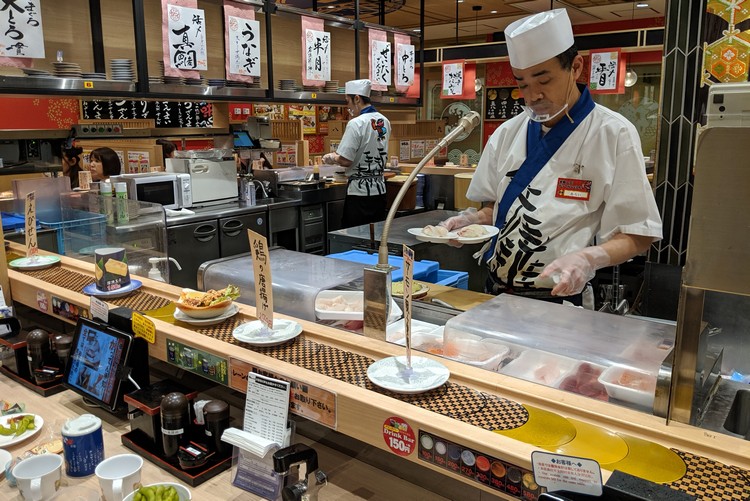
Read more posts from Japan
- 25 Japan travel tips for first timers
- 50 Photos of Kyoto that will inspire you to visit
- The perfect 3 day Tokyo itinerary for first time visitors
- 100 Photos of Tokyo Disneyland, Japan
- 15 things to do in Kobe, Japan
Let’s start with the most popular food in Japan for tourists
Given that this post is written with the first time visitor in mind, let’s start with the most popular Japanese cuisine for tourists. Below is a detailed list of Japanese food you should try in Japan.
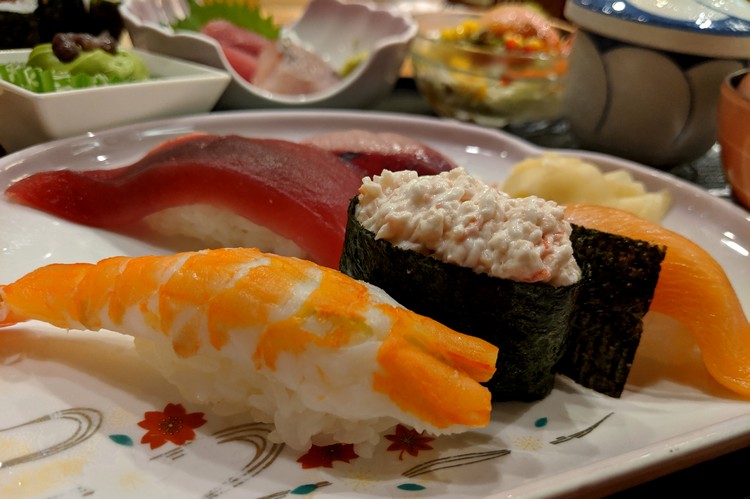
1. Sushi
Sushi is arguably the most famous food in japan. at least, it is for tourists. .
Without question, sushi is a big part of Japanese cuisine. You will find a variety of sushi shops in Japan, so you will have plenty of options.
If you’re not familiar with sushi, the thought of eating raw fish wrapped in thin sheets of seaweed might feel completely foreign and unsettling. You might even think that eating sushi is a big stretch for you. That’s okay, you’re not alone.
I think most people remember the first time they tried raw fish.
I know I do. It was a tuna sushi roll (tekka maki) at a small Japanese restaurant in North Vancouver. I had a mental block that prevented me from embracing the concept of raw fish. I wasn’t a fan of the texture or flavour, but it wasn’t as bad as I had built it up in my mind.
Now, years later, I can’t get enough sushi. I’m pretty sure we eat sushi at least once per week.
As one might expect, sushi tastes better in Japan. The fish is fresh and tasty and the sushi is prepared with a meticulous precision.
Travel tip – visit a Japanese restaurant in your hometown before you travel to Japan. Familiarize yourself with the menu and sample a few items. Let your curiousity run wild. This way, you have the advantage of reading the menu in English. Once you’ve seen and tried a few items, you’ll be much more comfortable with the food in Japan.
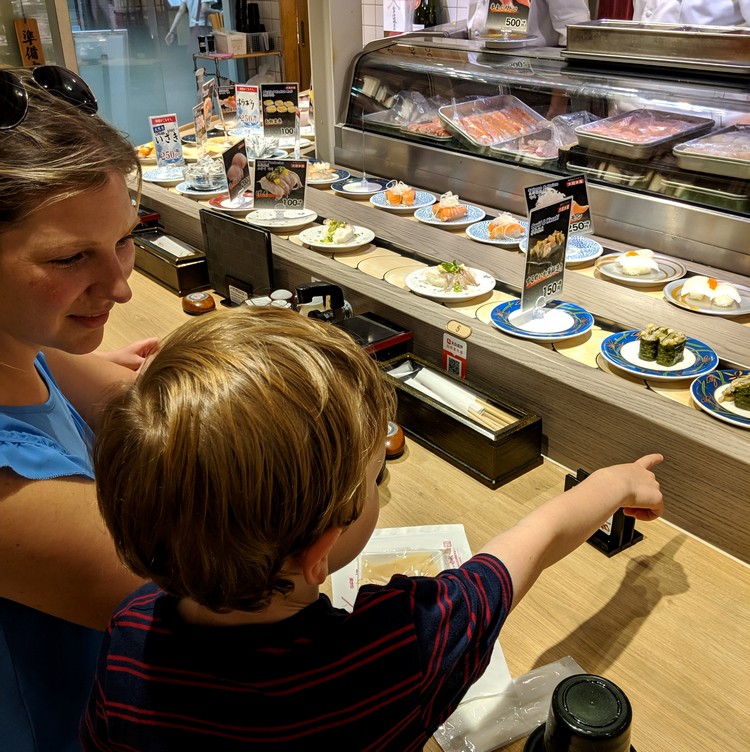
What sushi should you try first?
Sushi refers to any dish made with Japanese rice that’s seasoned with rice vinegar.
Sushi rolls are called maki or makizushi. Fresh fish and/or vegetables are wrapped with Japanese rice and a dried seaweed sheet (nori). The most common sushi rolls in Japan are salmon rolls, tuna rolls (tekka maki), unagi (freshwater eel), cucumber (kappa maki), f ermented soybean (Natto Maki) and f utomaki sushi rolls.
Here is list of useful sushi terms you should know before your visit to Japan.
Nigiri sushi are bite-sized mounds of sushi rice topped with slices of raw fish. The most popular nigiri sushi are sliced tuna, salmon, freshwater eel, squid and prawn. However, there are endless types of nigiri sushi available at Japanese sushi restaurants.
If you’re unsure about sushi and you want to ease in slowly, we recommend trying a non-fish sushi roll first, like cucumber, avocado, mushroom or egg (tamagoyaki).
Fun fact – California rolls and Dynamite Rolls are popular in North America, but not in Japan. Some Japanese restaurants in touristy areas will have these Westernized rolls on the menu, but most will not. These “safer” rolls are a good introduction to sushi because they do not have raw fish, but don’t expect to find these sushi rolls in Japan.
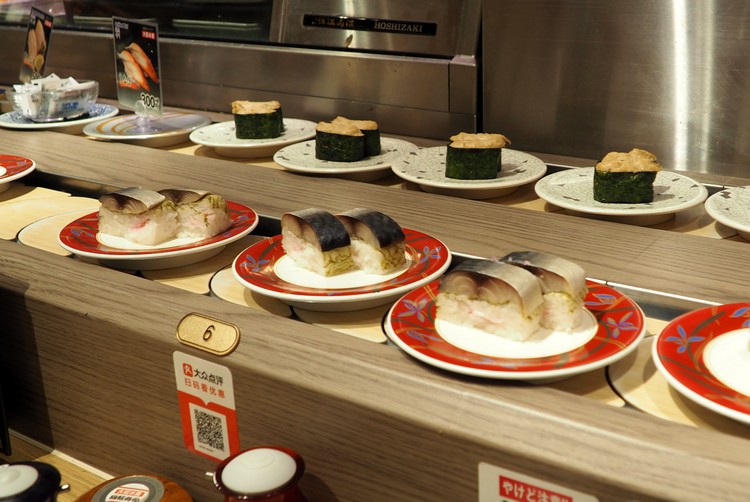
Conveyor belt sushi in Japan – Kaiten Sushi
A fun way to sample a variety of sushi is visiting a conveyor belt sushi restaurant, also called rotation sushi, sushi train and kaiten sushi . You may have seen or read about these innovative sushi restaurants during your research about Japanese food.
Basically, a conveyor belt transports small plates of various sushi around the restaurant. Typically, the conveyor belt passes beside tables or booths, or in front of a sushi bar, like the one pictured above.
Each item has a different price, which is identified by the colour or pattern on the plate. For example, the red plates might be 200 Yen each. If you see something you like, pick it up from the conveyor belt and enjoy. At the end of your meal, you add up the plates and pay for what you took from the conveyor belt.
We visited a few kaiten-zushi restaurants in Tokyo and Kyoto. They’re great. Not only does the sushi come out quickly, you can actually see the items as they pass your table. This is ideal for first timers who are nervous about trying raw fish for the first time.
And, you don’t need to worry about over-ordering, or under-ordering. The small bites allow you to pace yourself and try some items you might not have it you were to order from a menu.
Here’s an updated list of Conveyor Belt Sushi Restaurants in Tokyo.
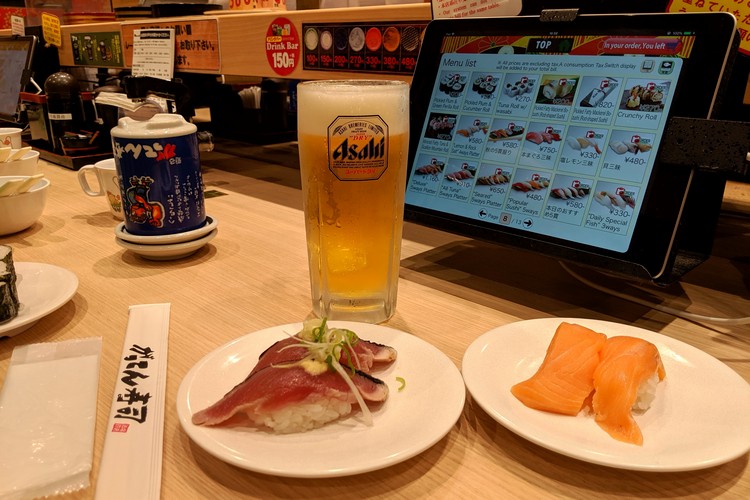
Most conveyor belt sushi restaurants in Japan have tablets at the table (see above photo). If you don’t see items you like on the conveyor belt, or you would like to order hot food items, you simply click the photos and place your order on the tablet.
Most tablet menus have an English option. This is helpful if you have specific items in mind.
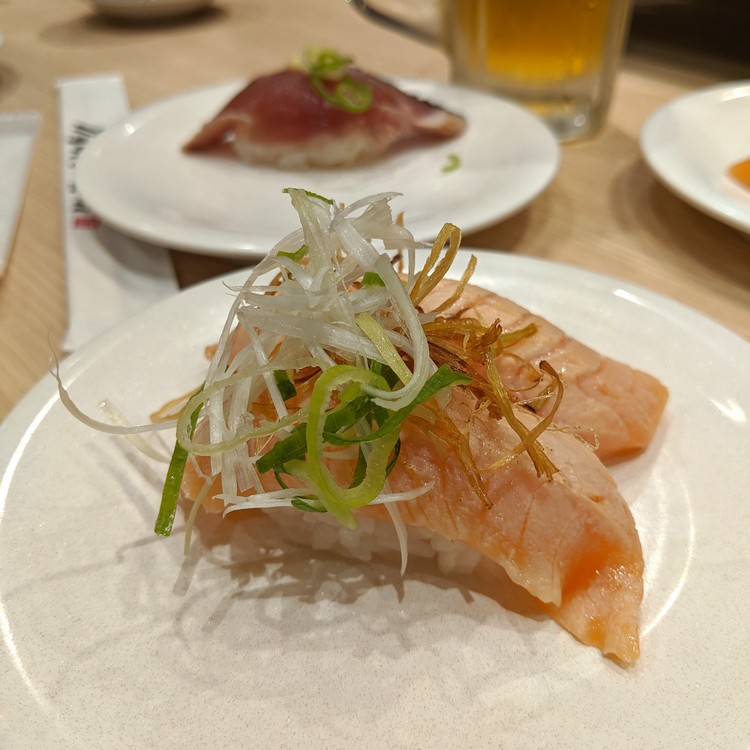
Above – a small plate of nigiri sushi at a kaiten sushi restaurant in Tokyo Japan.
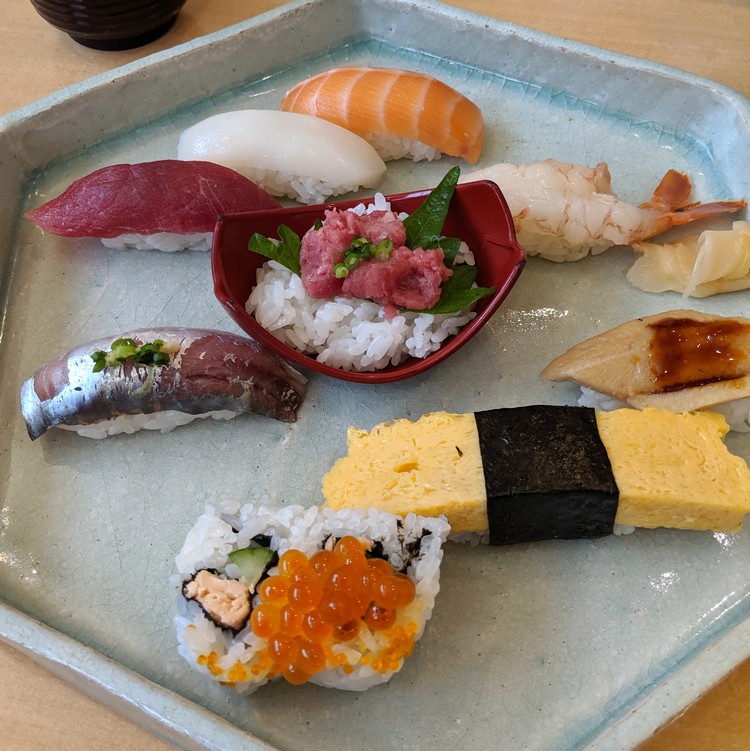
The above photo is a platter of various nigiri sushi.
Each piece of nigiri sushi a work of edible art. In the middle of the platter is chopped raw tuna belly served on rice. The big yellow sushi is tamago nigiri, which is a sweet folded omelet wrapped with seaweed.
Related post – Japan travel tips for first time visitors.
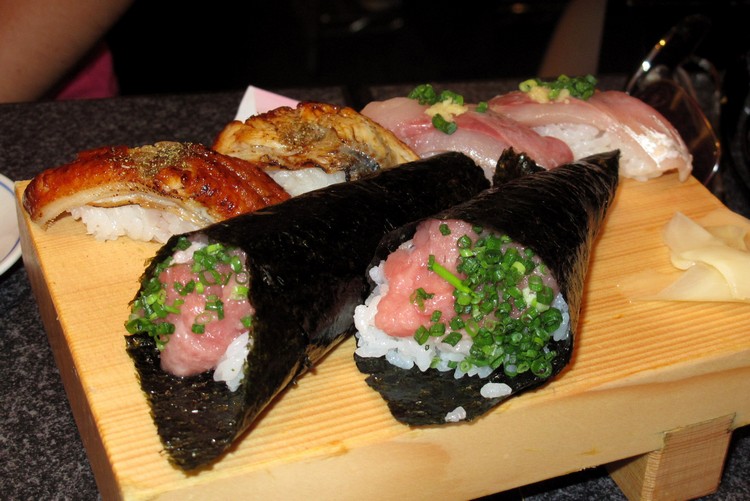
You can also order sushi cones, like in the above photo. These can get messy if you’re not careful. However, it’s one of our favourite food in Japan.
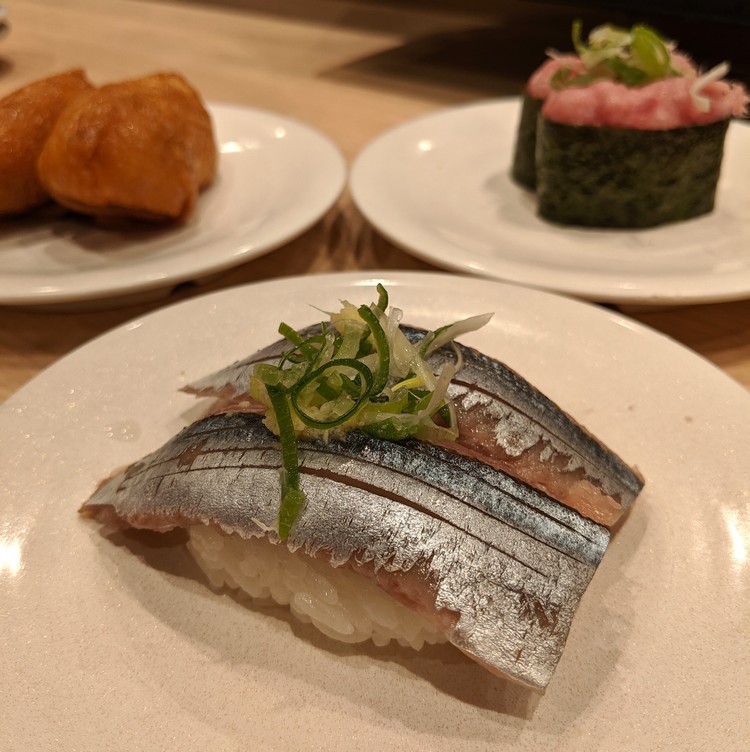
How to eat Sushi in Japan
We eat sushi often in Vancouver . At least once per week. We thought we knew the correct way to eat sushi, but we were wrong. How did we not know this before travelling to Japan?
Here’s an etiquette guide for how to eat sushi the correct way .
Apparently, the golden rules of eating sushi in Japan are:
- do not stick your chopsticks upright in the rice
- do not cut a piece of sushi in half with your chopsticks
- don’t mix wasabi in your soy sauce
There are a lot of things to know when it comes to Japanese culture. Most people will forgive foreigners for not knowing or understanding proper Japanese etiquette and customs, provided you’re respectful, quiet and polite. So, if you want to mix up your wasabi and soy sauce, do it subtly and don’t be surprised if the sushi chef rolls his eyes at you.
Related – Japan travel tips you should know before you go
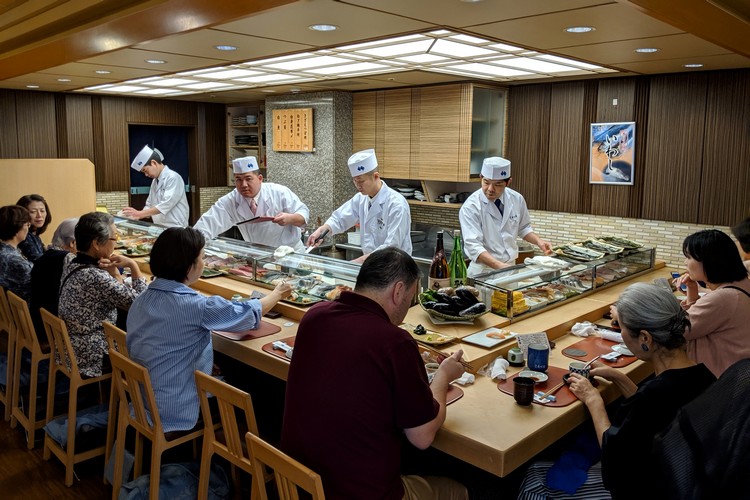
What is your favourite Japanese cuisine? Leave a comment below.
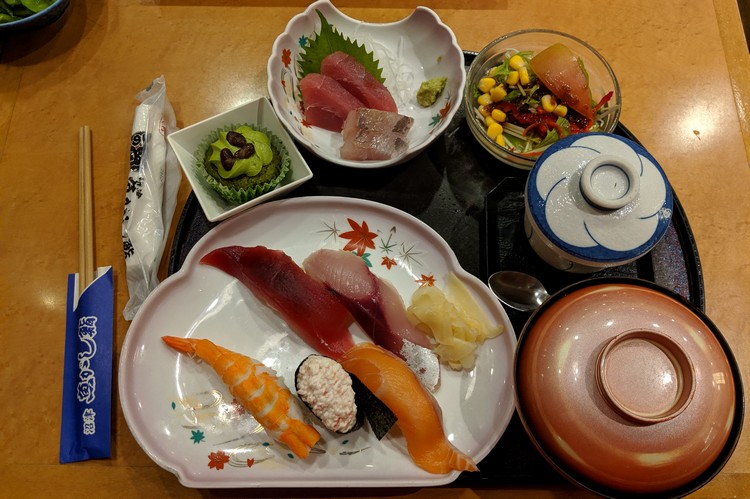
Sashimi is a Japanese delicacy that consists of thinly sliced raw fish, typically salmon, fatty tuna, yellowtail, mackerel, scallop and squid. You will also find sashimi-style meat, like chicken and beef.
Typically, sashimi is served plain and you dip the raw fish slices in soy sauce. However, some types of sashimi are served with a spicy sauce on top (example = spicy tuna sashimi).
What is the difference between sushi and sashimi?
There are a lot of similarities between sushi and sashimi. Some nigiri sushi, like the ones pictured above, have a strip of raw fish resting on a mound of Japanese rice. Same goes for some sushi rolls, like tekka maki (tuna), where the sushi roll is filled with slices of raw fish, which is basically sashimi.
In the above photo, the sashimi is located in the top dish. You can see the similarities between sashimi and nigiri sushi – the slices of fish on the nigiri sushi are so big that you actually can’t see the rice underneath.
Kaisendon traditional set menu
Kaisendon is a Japanese dish that consists of white rice and raw sashimi, such as prawns, octopus, squid, salmon, white fish, crab meat, egg, and sea urchin roes. It is often served with a traditional set menu (above photo).
In the covered brown bowl is miso soup, which is commonly served at Japanese restaurants.
The white bowl on the top right of the plate is chawanmushi , a steamed egg custard filled with meats and vegetables (including chicken, mushrooms, gingko nuts, kamaboko fish cakes, and carrots).
Other items typically found in a Japanese set menu are steamed vegetables, pickled vegetables, tempura (see below), salad, sushi rolls and/or a sweet desert like matcha cupcakes.
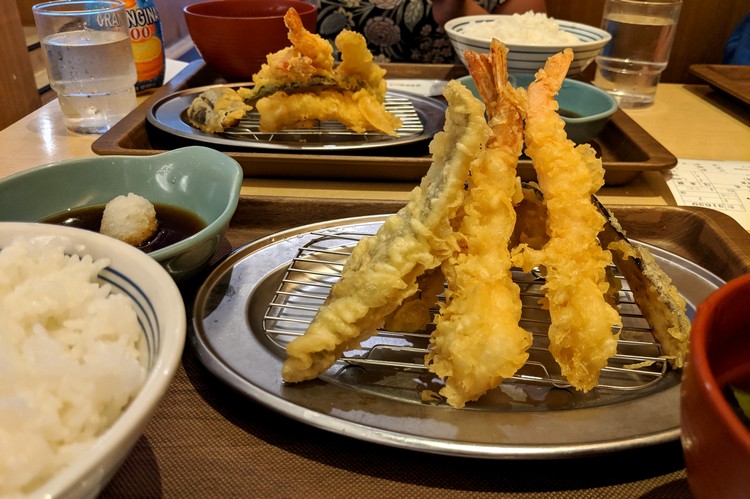
3. Tempura
Tempura is one of the most popular Japanese dishes in Japan. It’s a simple dish that consists of battered and deep fried seafood, meat and/or vegetables, served with a special dipping sauce called Tentsuyu.
Tempura is an easy introduction to Japanese food for tourists.
If you like crispy fish and chips, you’ll love tempura. Tempura batter is lighter than the batter that’s commonly used for fried fish and chicken.
Tempura can be served as an appetizer, side dish or as a stand-alone entrée. It’s typically made with prawns and/or vegetables, like yams, sweet potato, butternut squash, eggplant and green beans.
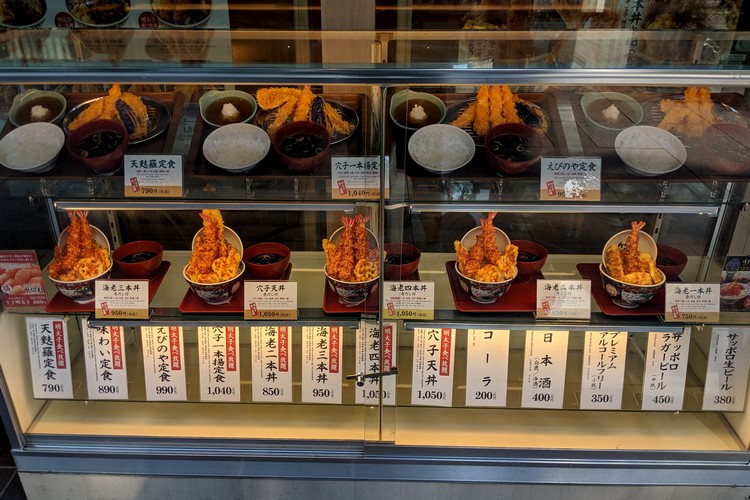
Many Japanese restaurants have plastic replicas of the dishes on display at the front or entrance to the restaurant. This makes it easy to visualize the menu and decide what you want to order before sitting down at a table. It’s very convenient when traveling with kids.
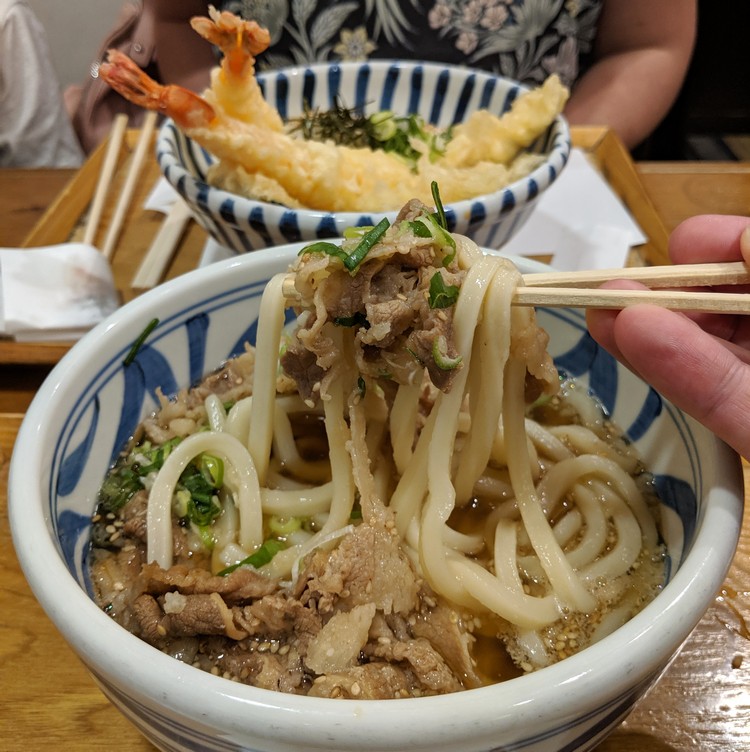
Udon is a popular Japanese dish that’s an easy introduction to Japanese food for tourists. It can be served a number of different ways, with a variety of ingredients, but it is most commonly served in noodle soups.
Pictured above is a delicious beef udon noodle soup that we enjoyed in Kyoto, Japan .
I like the simplicity of udon noodle soup. The flavourful savoury bowls are loaded with soft thick noodles, sliced chicken or beef, fresh vegetables and a variety of garnishes like green onion, sesame seeds, roasted seaweed slices, nora and dried garlic.
The most common udon noodle soups are Kitsune Udon, Tempura Udon (pictured above, in the backdrop) and Chikara Udon (topped with grilled mochi rice cakes).
You will also find udon noodles served in a stir fry dish, called Yaki Udon , mixed with meat, vegetables and a soy based sauce. It’s similar to yakisoba, but the noodles are different.
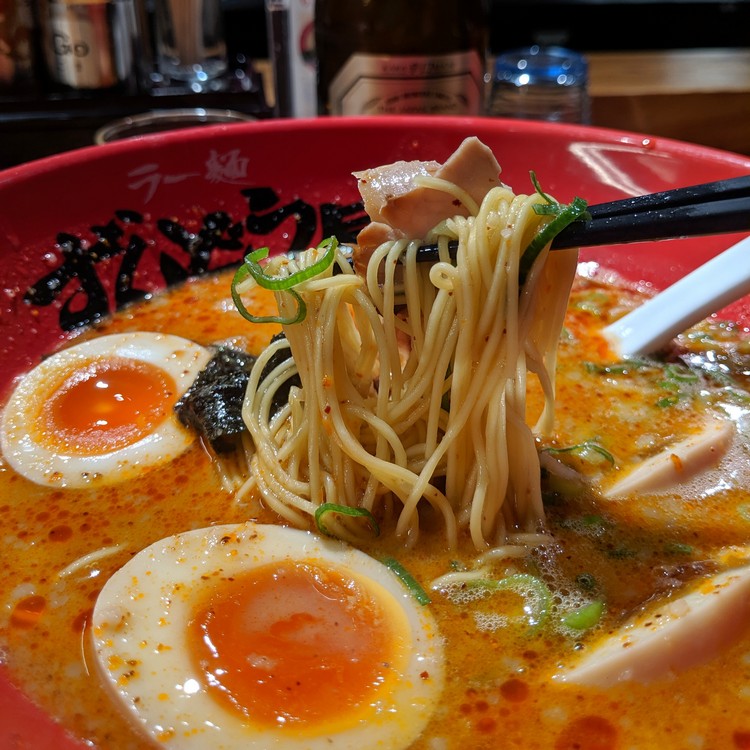
Ramen is probably the most popular Japanese cuisine for tourists.
Similar to udon, ramen is a noodle dish consisting of thinly sliced wheat noodles, protein, vegetables and is typically served in a rich savory broth. Ramen is the perfect Japanese food for beginners.
There are many types of broths, ingredients and garnishes that will completely change the flavour and texture of the ramen noodle soup. The four main ramen broth bases are soy, miso, salt and tonkotsu.
My favourite is miso ramen, but tonkotsu is a close second. Who and I kidding, I love them all!
You can also add items to your ramen. Typical ramen garnishes include chashu pork, menma (bamboo shoots), narutomaki (fish cake), scallion, shiraga negi (Japanese long green onion) and a marinated soft boiled egg ( Ajitsuke Tamago ). I love adding an extra soft boiled egg – they are heavenly when prepared properly.
Ramen is an inexpensive and popular dish that can be found almost anywhere in Japan. You won’t have a problem finding ramen restaurants in Tokyo or Kyoto.
That said, like most restaurants, some are better than others. If you’re only in Tokyo for a few days, research online reviews to find the best ramen restaurants in Japan. Make it count!
Related post – How to spend 3 days in Tokyo
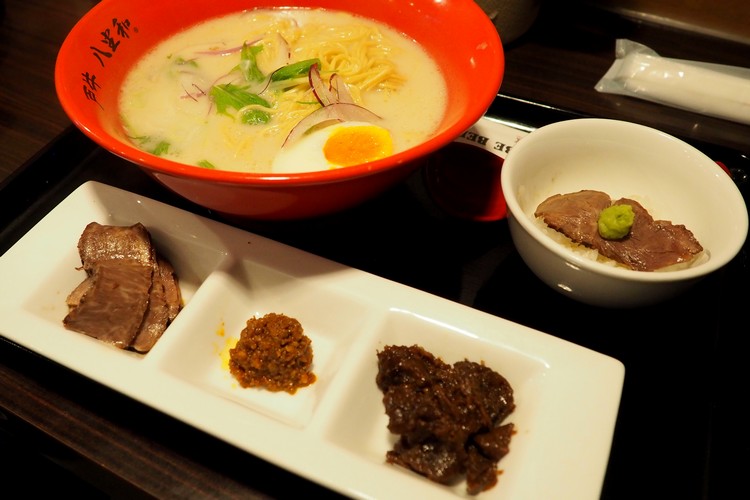
The above photo was captured at a small ramen restaurant in Kobe that was recommended to us. This particular miso ramen dish is served with a variety of Kobe beef.
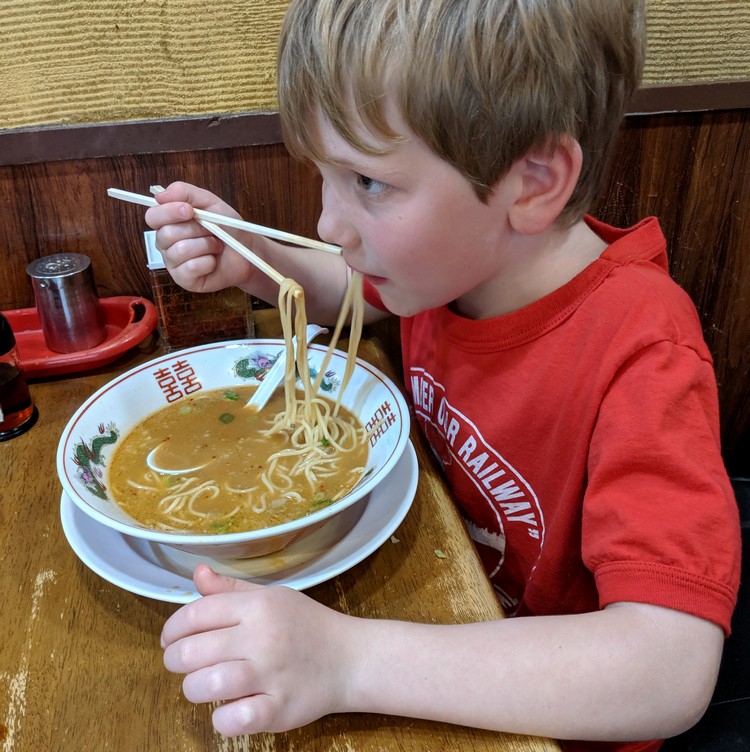
Ramen is an easy introduction to Japanese food for kids. Our 8 year old son loves miso ramen.
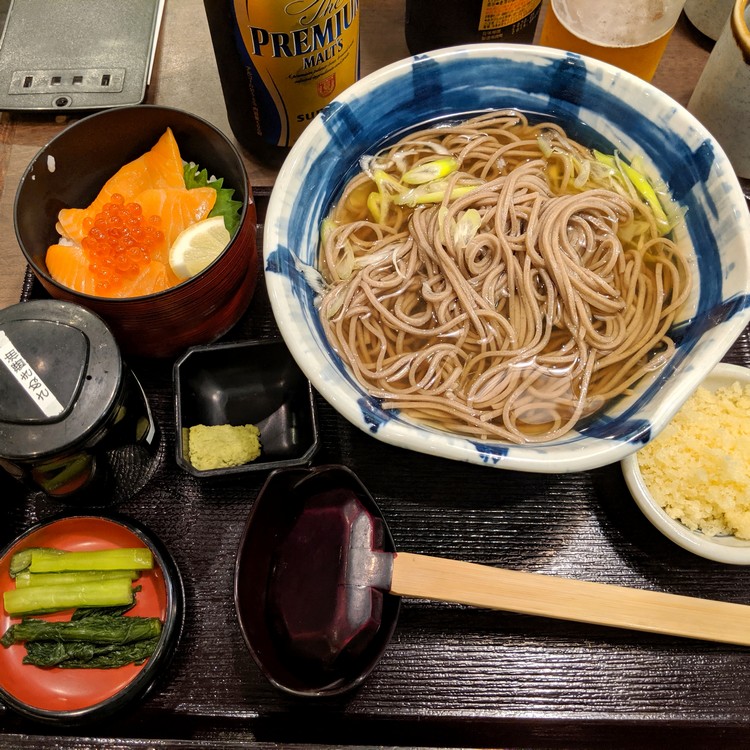
Soba is the Japanese name for thin noodles made from buckwheat flour, or a combination of buckwheat and wheat flours. Similar to udon and ramen, soba noodles are often found in savory soup broth. However, soba noodles are also served cold with a dipping sauce or as a hot stir fry dish.
There are many soba noodle recipes and dishes to taste, from spicy peanut soba noodle salad (served cold) to beef and vegetable stir fry soba noodles (yakisoba).
Many restaurants in Japan offer a set menu with soba noodle soup as the main dish, accompanied by a variety of side dishes, like tuna sushi, salmon sashimi, grilled vegetables, steamed spinach with peanut sauce (Goma-ae), crispy tempura batter and chawanmushi (traditional savory egg custard).
Related – 50 Photos of Kyoto that will inspire you to visit
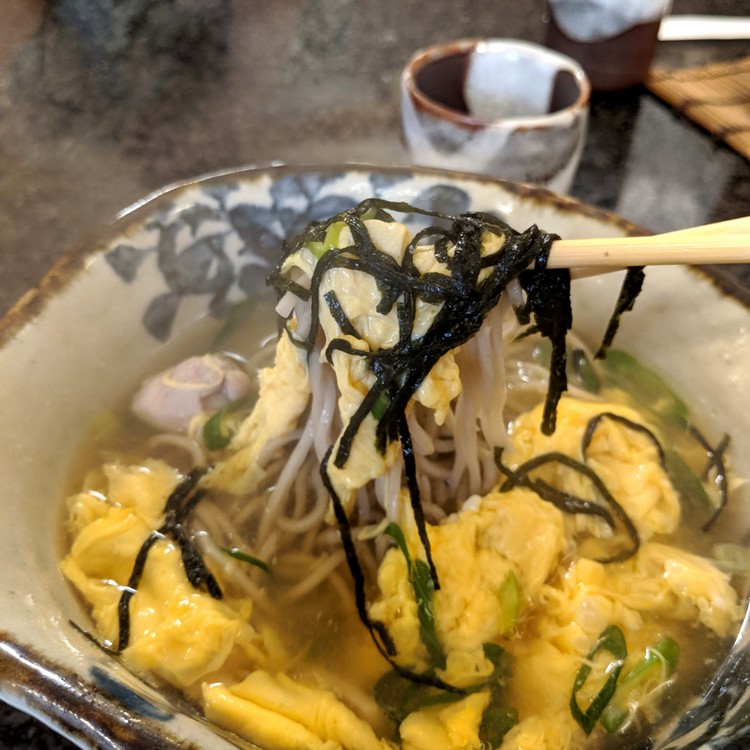
Above is a soba noodle soup with egg, chicken and sliced nori (dried seaweed).
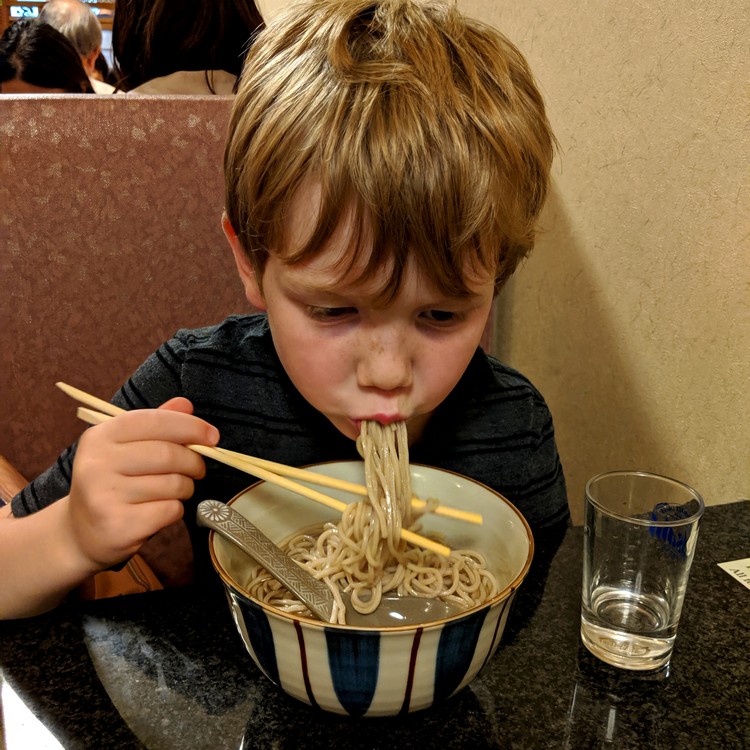
Another day, another bowl of noodles for this little guy.
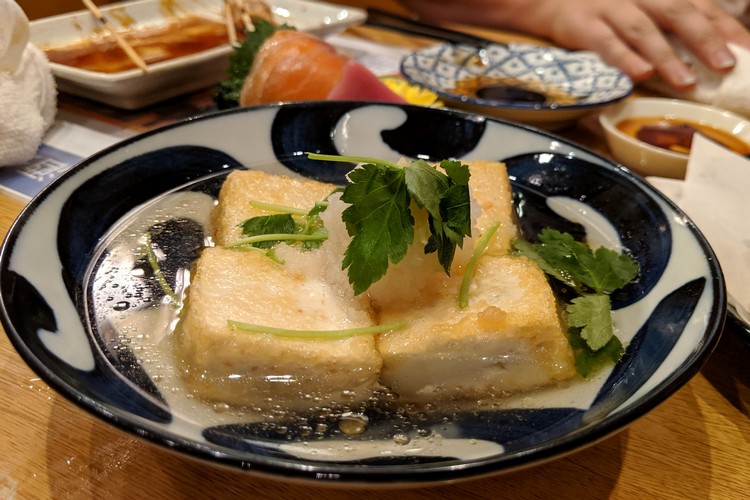
7. Agedashi Tofu
Agedashi tofu is cubes of soft or silken tofu coated with potato starch and deep fried so that the outer shell is crispy. It’s typically served as an appetizer or side dish, but can also be the main item in a bento box or served as an entrée.
If you’re vegetarian or don’t like to eat meat or fish, agedashi tofu is a great alternative.
Agedashi tofu is typically served with a flavourful tsuyu sauce for dipping. It is sometimes served with grated radish, green onion, and bonito flakes as garnishes.
Be careful. Agedashi tofu is deep fried and it comes out hot, hot, hot! We’ve burnt the roof of our mouths several times because we were too eager to dive in. The trick is to stab the middle of each piece of tofu with your chopstick so the steam releases and the tofu cools down. Consider yourself warned.
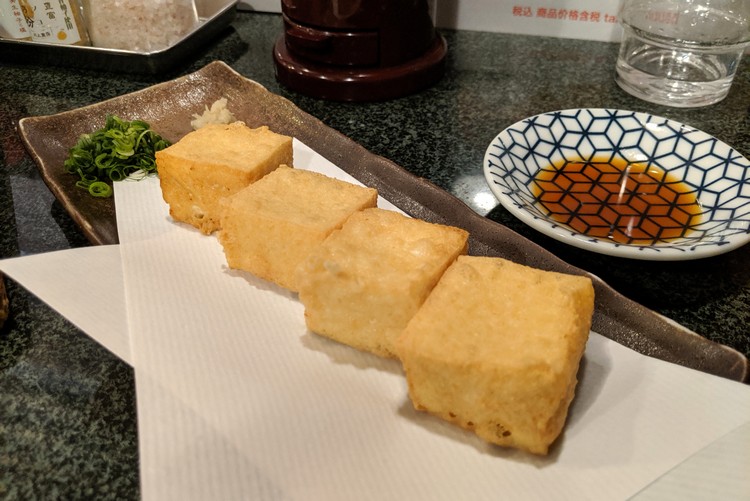
Above is a plate of large cubed agedashi tofu at a restaurant in Arima Onsen , an ancient hot spring town located near the city of Kobe.
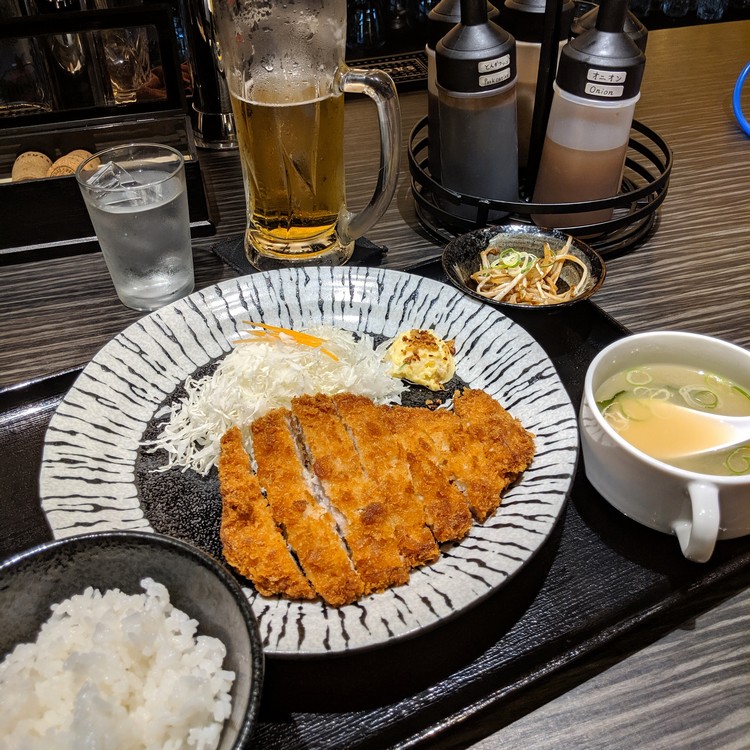
8. Tonkatsu (deep fried pork cutlet)
Tonkatsu is a breaded, deep-fried/tempura pork cutlet that is traditionally served with rice and sliced cabbage. It is a popular Japanese food for beginners because, well, who doesn’t like deep fried <insert anything and everything>?
Tonkatsu is similar to German schnitzel. However, the bread crumbs used for tonkatsu is called panko, which is different from the breadcrumbs used in Western cuisine.
You will find variations of tonkatsu in Japan, including katsudon , which consists of tonkatsu served on a bowl of rice, and katsu sando , which is a sandwich with tonkatsu between two slices of plain white bread.
Katsukare is another Japanese cuisine that consists of sliced tonkatsu pork cutlet served with Japanese curry rice and curry.

9. Yakitori
Yakitori is the japanese version of chicken skewers..
There are many variations of yakitori , however, typically the skewers are made with bamboo skewers and seasoned with tare sauce and/or salt and spice.
Yakitori comes in many forms, including white chicken skewers, chicken and spring onion, chicken meatballs, chicken small intestines, gizzard and chicken heart, to name a few. Some restaurants and specialty shops also have deep fried options available.
Yakitori a popular Japanese street food that is commonly found at outdoor markets, food courts, sporting events and Yakitori-ya, which are small shops that specialize in yakitori. It’s widely available at izakayas, informal Japanese bars that serve alcoholic drinks and snacks. Here’s a list of best izakaya alleys in Tokyo.
Related – The best things to do in Tokyo for first time visitors
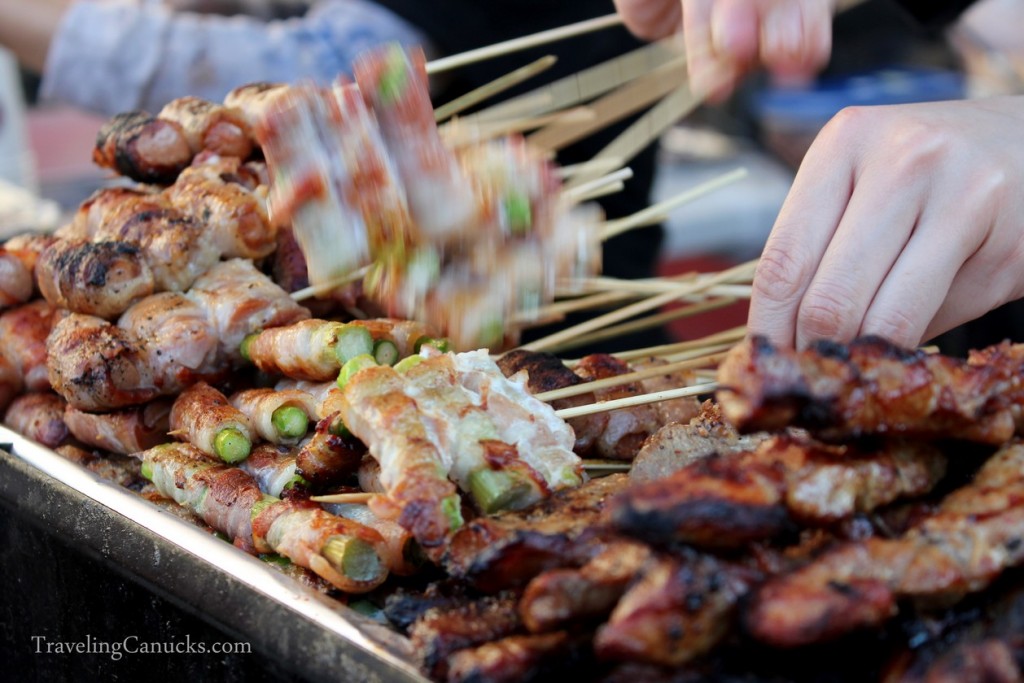
Freshly grilled yakitori at a market in Japan.
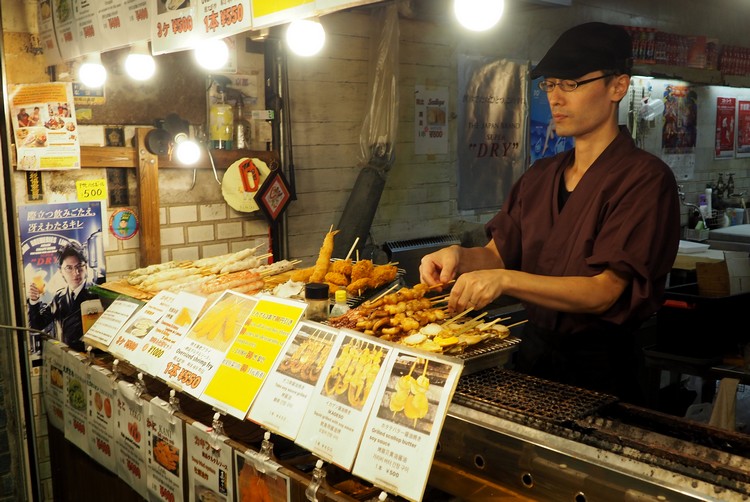
Yakitori and deep fried skewers at a stall in Nishiki Market in Kyoto.
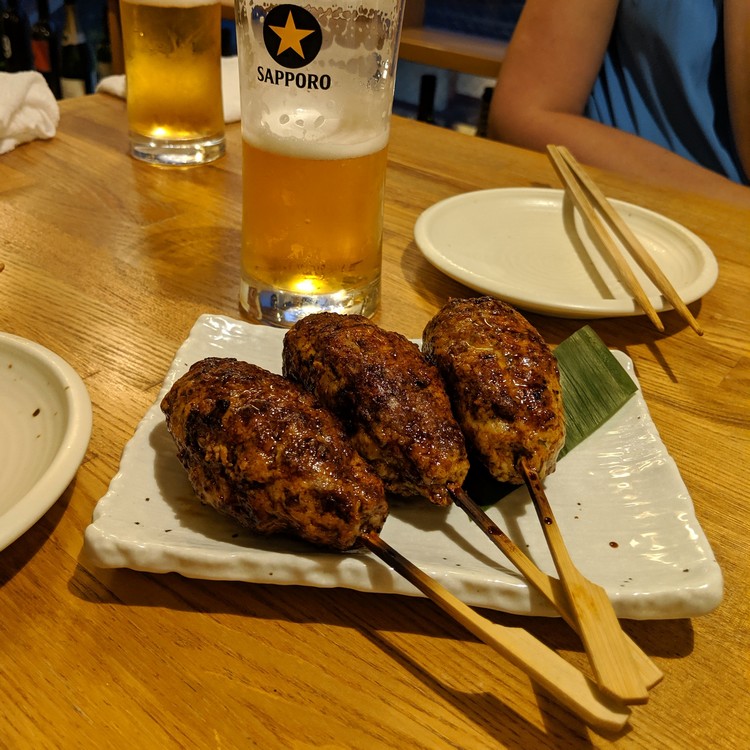
Chicken meatball yakitori served at a restaurant in Kyoto.
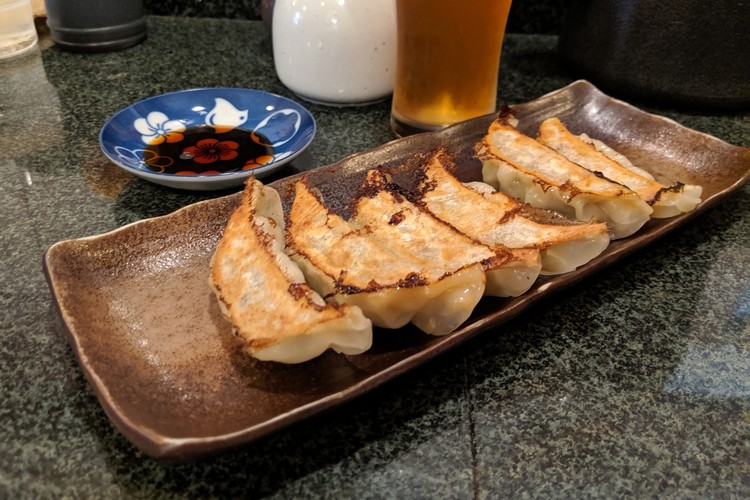
Gyoza is another popular Japanese dish that is a must try food in Japan. It’s commonly served as an appetizer or side dish at sushi restaurants.
Gyoza is Japan’s version of the dumpling. It’s most similar to Chinese potstickers or jiaozi dumplings. These tasty Japanese dumplings are typically filled with minced pork, cabbage, scallions, garlic, and ginger. Vegetarian options are typically available, too.
Gyozas are typically fried in sesame oil on one side, until they have a crispy bottom. The top of the gyoza is steamed, giving it a soft texture. They’re served with a dipping sauce of rice vinegar, soy sauce and chilli oil.
Gyozas are an easy introduction to Japanese food for unadventurous eaters.
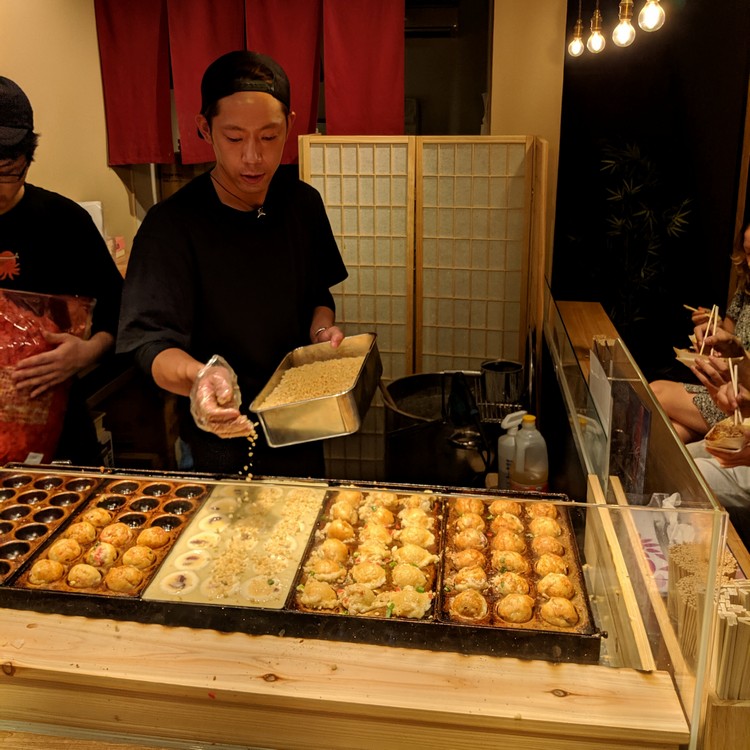
11. Takoyaki
Takoyaki, also known as octopus balls , is a delicious doughy ball filled with minced or diced octopus, tempura scraps, pickled ginger and green onion..
They are commonly eaten as a snack or appetizer and are served with takoyaki sauce (similar to Worcestershire sauce) and mayonnaise, and garnished with shavings of dried seaweed and fish flakes.
You will find small shops and street food vendors serving takoyaki throughout Japan.
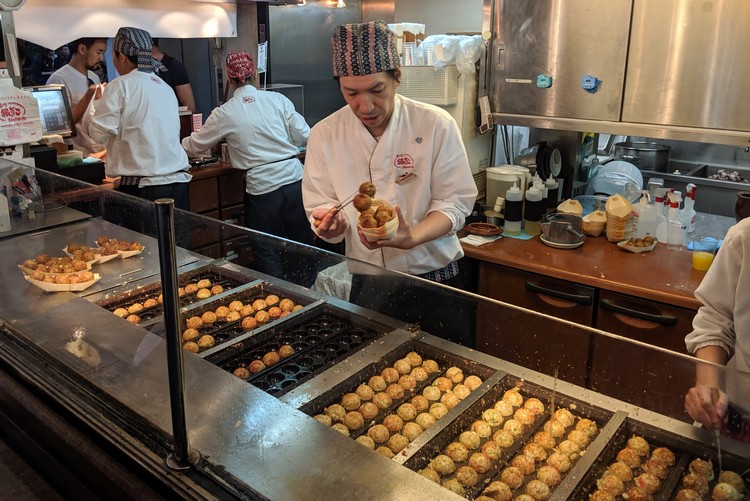
Gindaco Takoyaki is the famous takoyaki restaurant near Harajuku train station in Tokyo.
We highly recommend you visit this location. They serve the best takoyaki in Tokyo, in our opinion.
Be prepared to wait your turn, as this location is very popular. It’s worth wait. Do it.
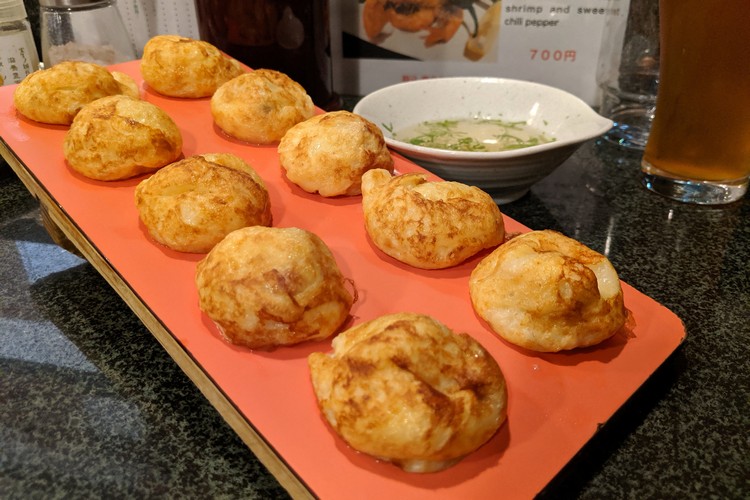
This takoyaki platter is served plain with a light vinegar dipping sauce on the side.
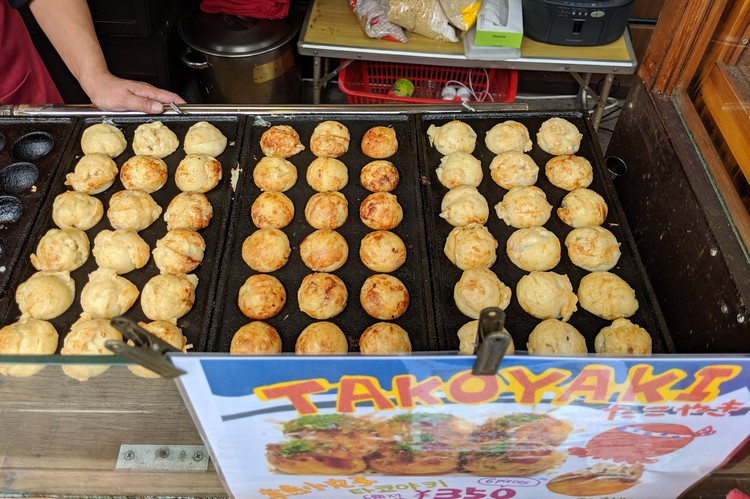
Takoyaki street food vendor near Fushimi Inari temple in Kyoto.
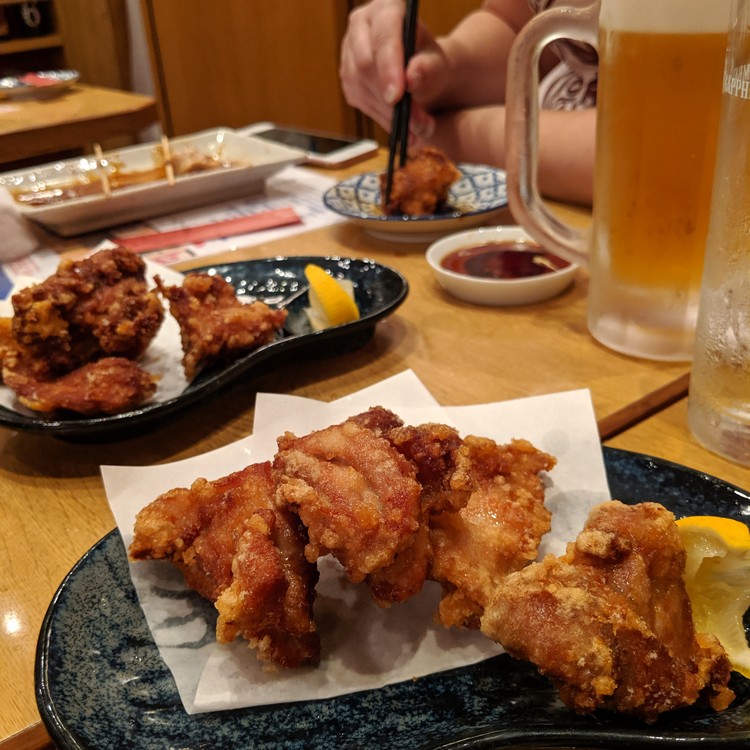
12. Chicken Karaage
Karaage is Japan’s version of fried chicken. The chicken is battered and deep fried until crispy on the outside. The chicken is often marinated prior to being coated with batter.
Karaage is served alone or with rice and shredded cabbage. It’s often served as an appetizer but it can also be a stand alone dish. You will find karaage served at most Japanese restaurants, as well as street food vendors at outdoor and indoor markets.
Our boys love chicken nuggets, so this tasty Japanese cuisine is one of their favourites.
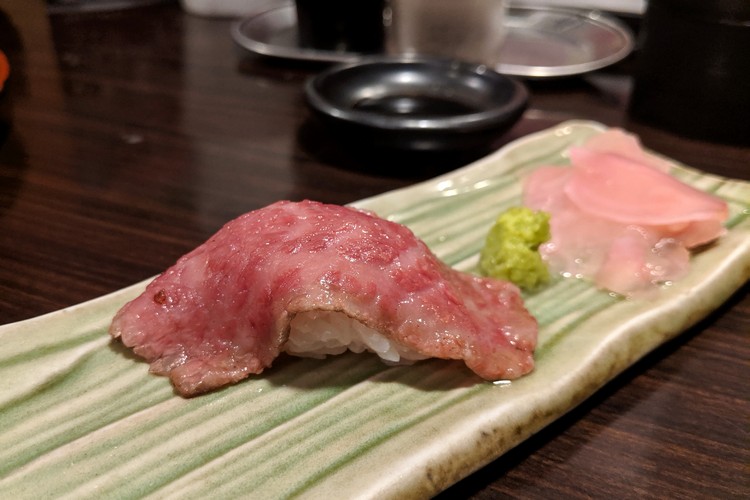
13. Kobe beef in Kobe Japan
For all you steak lovers out there, you must try kobe beef in kobe..
Kobe is famous for its Wagyu beef , arguably the finest cut of beef in the world, which comes from the Tajima strain of Japanese Black cattle.
Kobe beef is a Japanese delicacy , valued for its flavour, tenderness, and fatty, well-marbled texture. Foodies flock to Kobe to sample it’s famous namesake.
First time visitors to Kobe will have no trouble finding a restaurant serving Kobe beef. It’s heavily advertised from the moment you get off the train at the Kobe train station.
There are a number of ways to sample this popular Japanese style of beef, from Kobe beef teppanyaki to Kobe beef hamburgers to Kobe beef sushi (pictured above).
Kobe beef is an expensive cut of meat , so your budget may dictate the best way to experience this celebrated Japanese cuisine. High-end steakhouses offer multi-course meals that serve a variety of cuts and styles of wagyu beef.
Or, you can enjoy Kobe beef on the cheap by sampling kobe beef sushi from a variety of restaurants or street food vendors. That’s what we did, because only one of us likes beef (hint – it’s not Nicole or the boys).
Now, if Kobe City is not on your original Japan travel itinerary, you can easily add it by taking a day trip to Kobe from Kyoto, Tokyo or Osaka. Or, you can simply get off the train in Kobe and have lunch or dinner, then get back on the train and continue to your next destination.
You will find wagyu beef throughout Japan, so don’t worry if you aren’t able to make it to Kobe. There are dozens of restaurants in Tokyo that serve wagyu beef, including Kobe beef, Omi beef and Matsusaka beef.
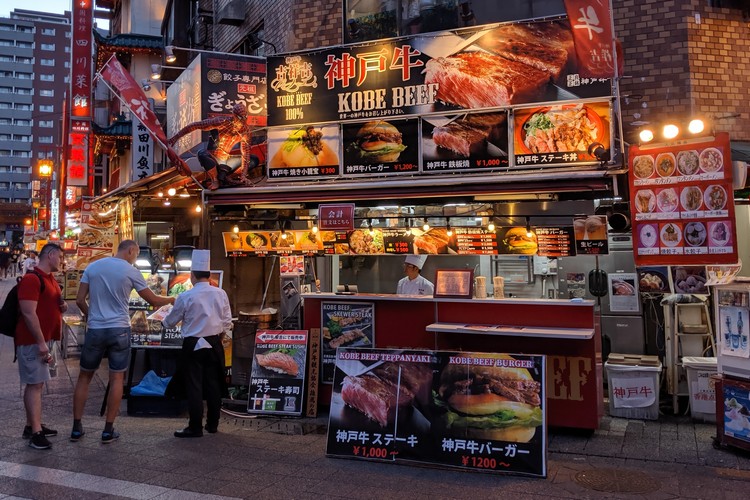
Street food vendors in Kobe Chinatown serve a variety of Kobe beef to hungry visitors.
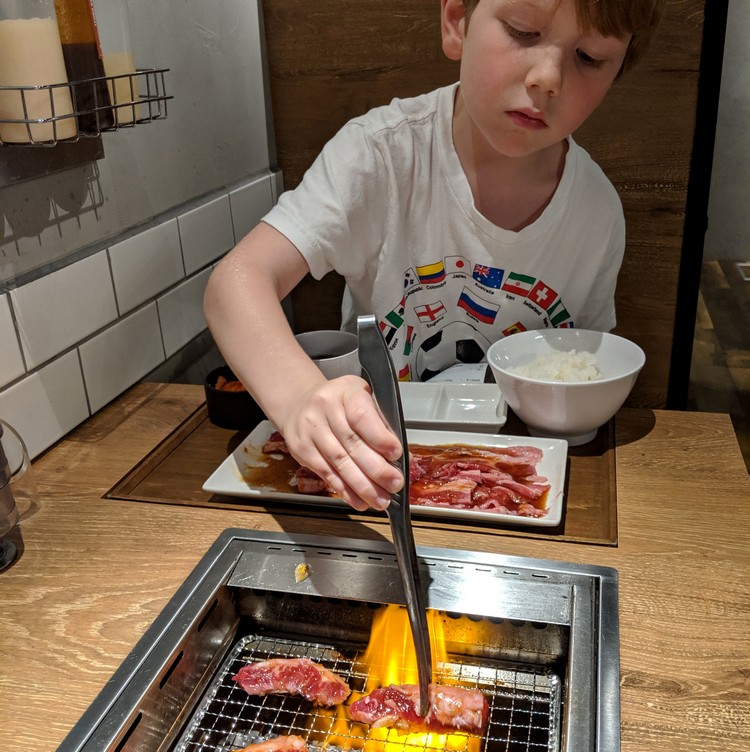
14. Yakiniku
Yakiniku is a Japanese term that refers to grilled meat. Basically, you grill your meat on an open flame at your table. It’s a fun Japanese dining experience that you should try on your Japan vacation.
We stumbled upon a great yakiniku restaurant, Yakiniku LIKE , while exploring the Akihabara district in Tokyo. There are tablets at each table with an English menu and photos of each dish, so it’s an easy process with limited ‘lost in translation’ moments.
We ordered a variety of pork and beef to grill at our table. The raw meat is marinated and sliced, so you just add to the flame and cook it as much, or as little, as you like. Meals are served with rice and there are several condiments at your table.
Our boys loved grilling meat on the table. This was there first time and it remains a highlight for them when we talk about our family trip to Japan.

Related – The top things to do in Tokyo for tourists
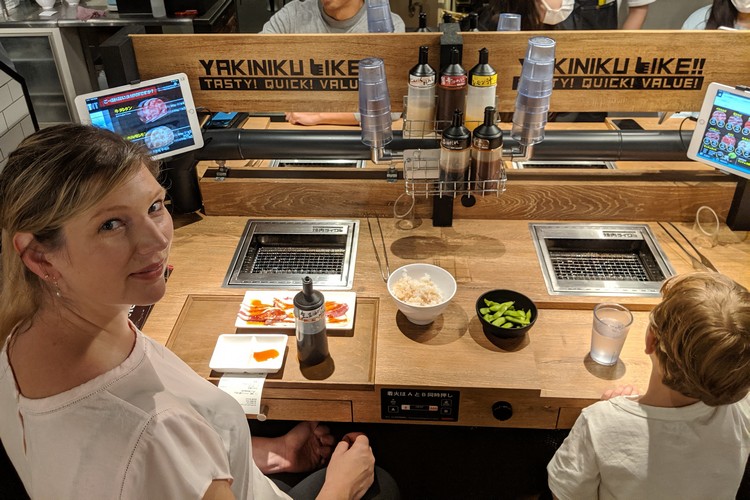
Follow us on Facebook for the latest travel updates.
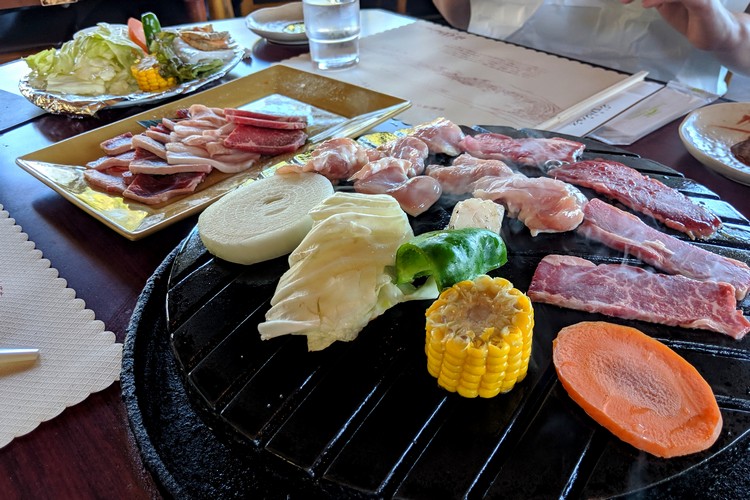
Japanese BBQ at your table
We enjoyed a fun lunch at Rokkosan Genghis Khan Palace on Mount Rokkō in Kobe City. Rather than being grilled on an open flame, like yakiniku, this Japanese barbecue grill is on a hot iron plate.
We ordered a variety of vegetables and meat, including Kobe beef, chicken and marinated pork, and grilled the food at our table. Our boys enjoyed using the tongs to flip the meat and listen to it sizzle on the iron plate. It’s a fun Japanese dining experience for tourists.
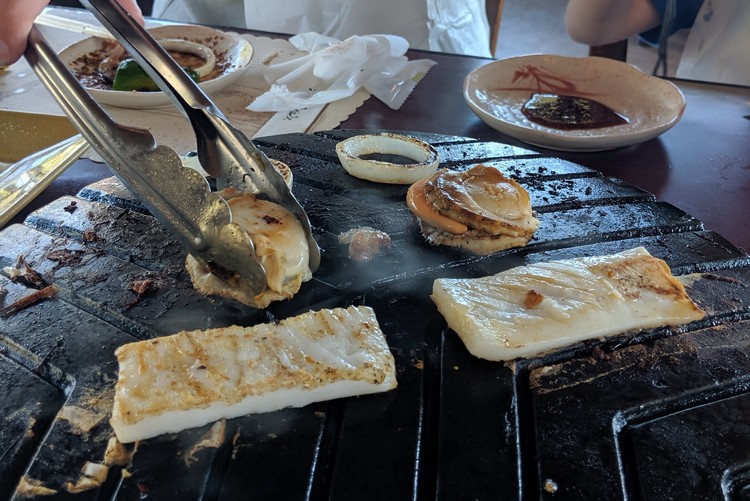
Grilling squid and giant mussels on an iron plate at our table .
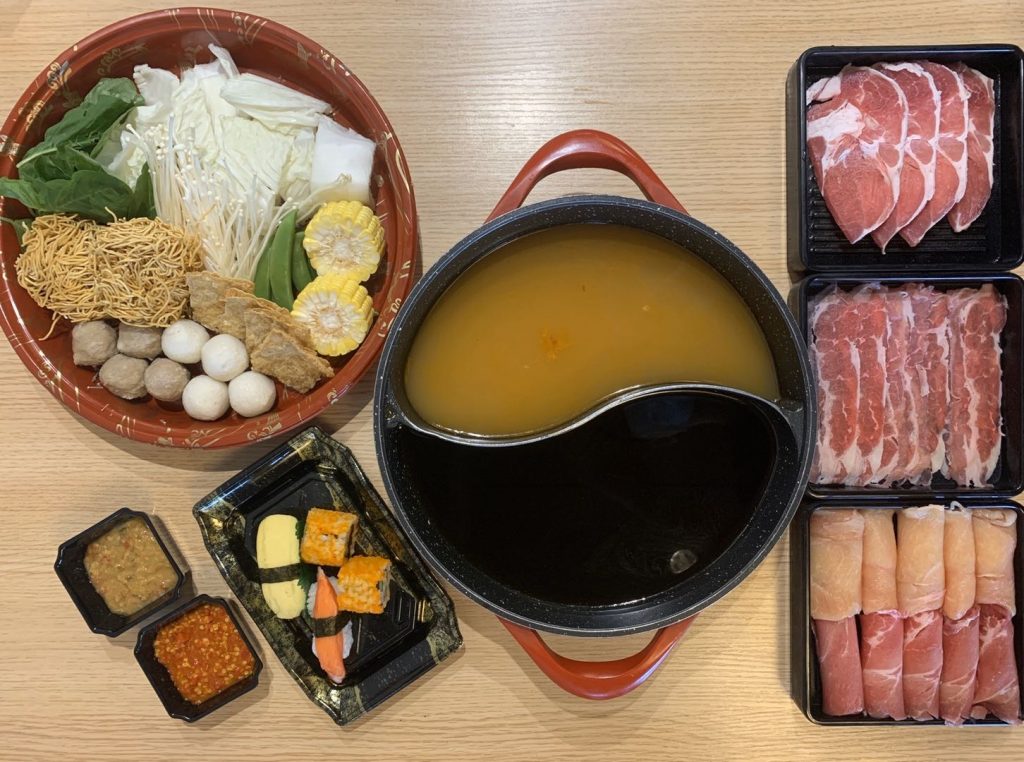
15. Shabu-shabu
Shabu-shabu is a hotpot dish that’s a big part of japanese food culture..
Basically, you cook your food at the table in a large heated pot with boiling water or broth. Some hotpots are split in half, like in the above photo, with each side having a different broth.
Most platters come with a variety of vegetables, seafood and thinly sliced meat, as well as dipping sauces, spices and garnishes so you can play with the flavours and heat.
Shabu-shabu is a fun Japanese dining experience to enjoy with friends and family. The idea is that you take your time and socialize around this bubbling hotpot. You dip your meat or vegetable as needed, rather than all at once. It’s a must try Japanese cultural experience for your Japan holiday.
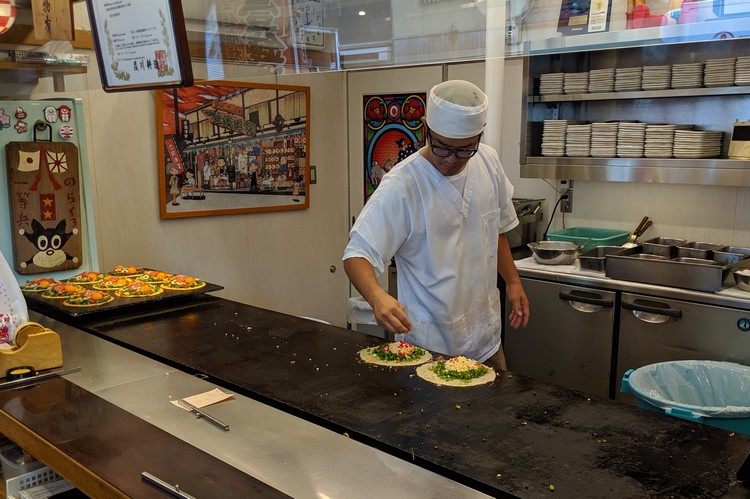
16. Okonomiyaki
Okonomiyaki is a japanese savory pancake with a variety of ingredients..
It’s a popular food in Japan for tourists because it’s a uniquely Japanese. There are different types of okonomiyaki throughout Japan, with toppings and batters varying depending on the region.
Okonomiyaki is mainly associated with the Kansai or Hiroshima areas of Japan, though it’s said to have originated in Osaka. It is sometimes compared to an omelette and may be referred to as a Japanese pizza or Osaka soul food .
The Kansai style okonomiyaki is the most common version found throughout Japan and typically contains meat (thinly cut pork belly or bacon), octopus, squid, shrimp, vegetables, green onion, and/or cheese. We prefer the Hiroshima style okonomiyaki because we like the ingredients to be layered, rather than mixed.
There’s also a semi-liquid okonomiyaki found in Tokyo called monjayaki. The ingredients in monjayaki are finely chopped and mixed into the batter before frying.
Here’s a list of the best Okonomiyaki in Kyoto.
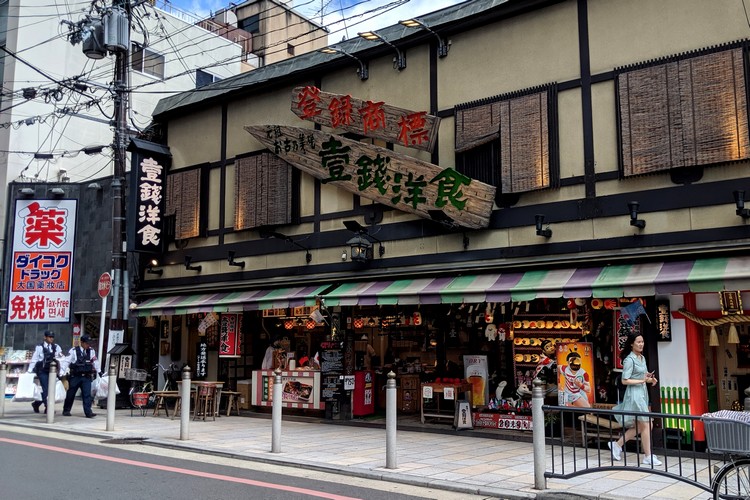
Issen Yoshoku is a famous okonomiyaki restaurant in Gion, Kyoto.
While the savoury pancakes are delicious, this okonomiyaki restaurant in Kyoto might be more famous for its statue at the front entrance. See photo below.
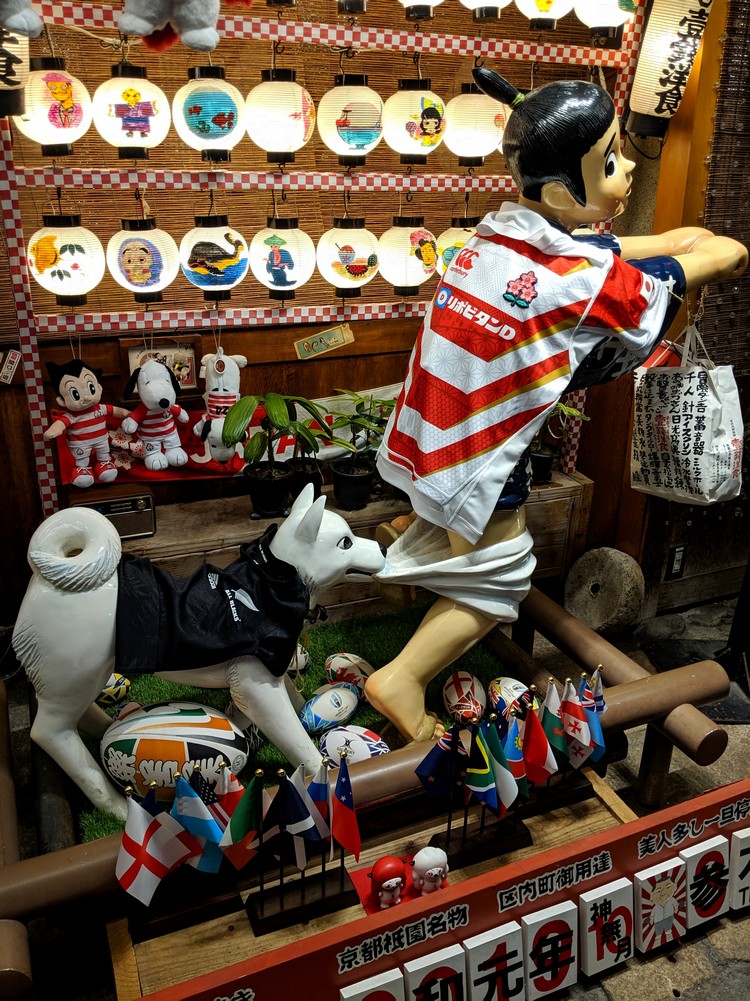
When we visited Kyoto a decade ago, we stumbled upon this funny statue of a boy getting bitten by a dog with his pants down in front of a restaurant. We thought it was an odd statue, so we took a photo.
When we returned last year, we stumbled upon it once again, by pure chance. Of course, we had to take another photo to capture the memory. This time, the boy is wearing a Japan rugby jersey because we visited for the Japan Rugby World Cup .
While thousands of people may have a photo of this strange statue, few will have a photo of it decorated for the Japan Rugby World Cup.
Related – Our experience at the Rugby World Cup in Japan
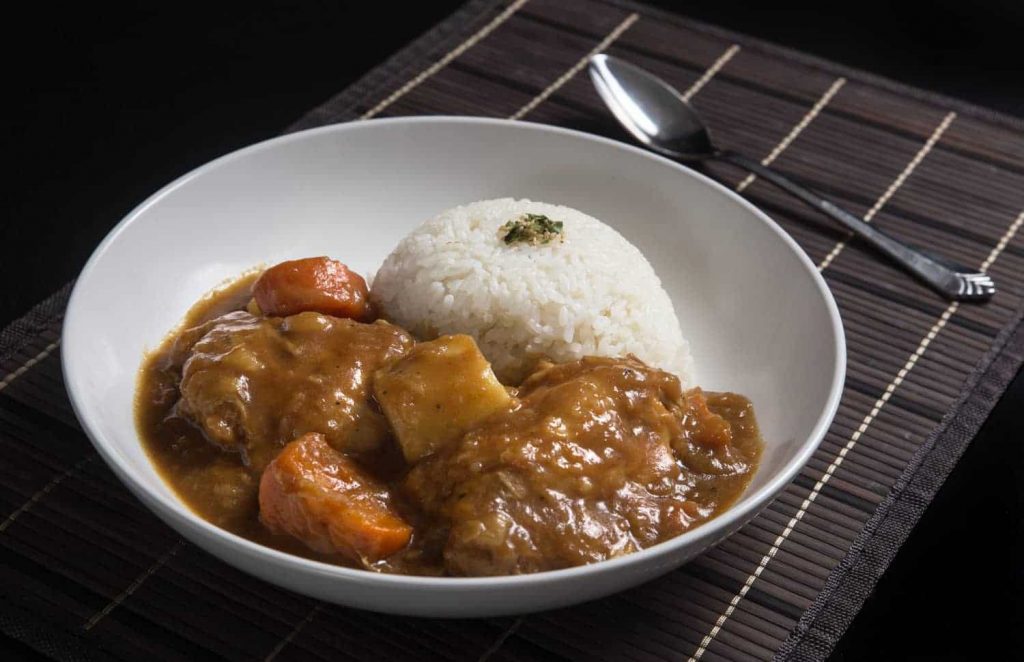
17. Kare Raisu (Japanese Curry Rice)
When we think of Japanese food, rarely does curry come to mind. That’s why we were surprised to see how popular kare raisu is throughout Japan.
Japanese curry rice tastes different from the curry you find in India or Southeast Asia. The main ingredients for Japanese curry are a variety of meats (chicken, pork or beef), vegetables (onions, carrots and sweet potatoes/yams) and spices. We found Japanese curry to taste more like a thick gravy with a curry flavour.
We’re told that kare raisu is a good example of yoshoku , which takes dishes from Western culture and adapts them to meet Japanese tastes and preferences (fusion cuisine). Japanese curry rice is an inexpensive Japanese dish that can easily be found throughout Japan.
We enjoyed Japanese curry rice for lunch when we visited Tokyo Disneyland .
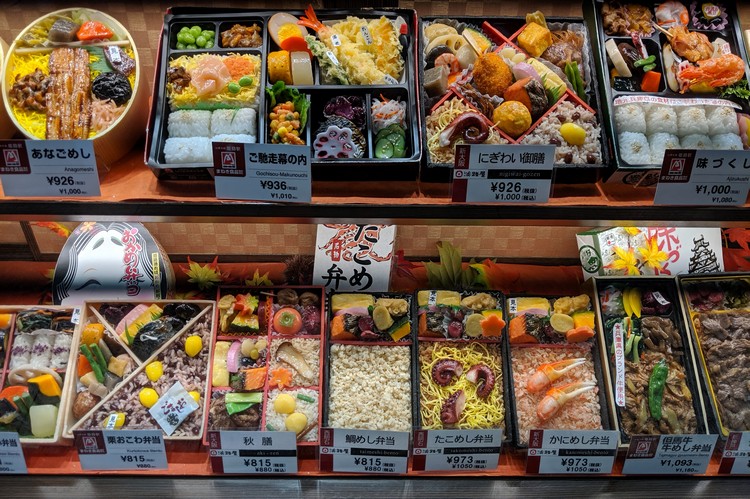
18. Bento Box
If you have not tried a japanese bento box, you are missing out. .
There are literally hundreds of varieties of bento boxes in Japan. A bento box is typically a single portion takeout or prepackaged meal, however you can also order bento boxes at restaurants. A typical bento box has a balance of dishes, most often including rice, meat or fish, and pickled vegetables.
We often order bento boxes for lunch at sushi restaurants because they offer a variety of items to sample.
During our travels in Japan, we would pick up bento boxes and bring them back to our hotel room or apartment rental. They are convenient, inexpensive and mostly healthy. Bento boxes are also a great way to sample a variety of side dishes that you might not have ordered otherwise.
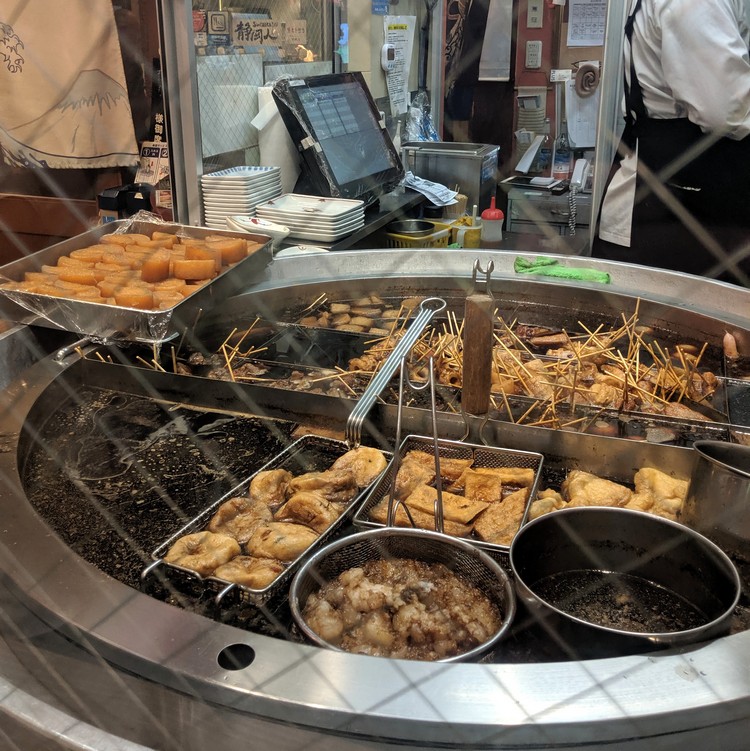
19. Oden (Japanese one-pot dishes)
Oden is an interesting part to Japanese food culture. It’s a common food in Japan that gets mixed reactions from tourists and first time visitors.
Basically, oden is a type of hotpot with an assortment of vegetables and proteins, including sausages, processed fish cakes, mochi rice cakes, daikon radish, konjac yam, tofu, and boiled eggs, to name a few. These items are stewed in a light broth and served to order. Ingredients vary according to region.
As a tourist, we had a hard time deciphering each item. In the photo above, this restaurant has a variety of items soaking in a hot broth. Guests walk up to the window and order items to take home.
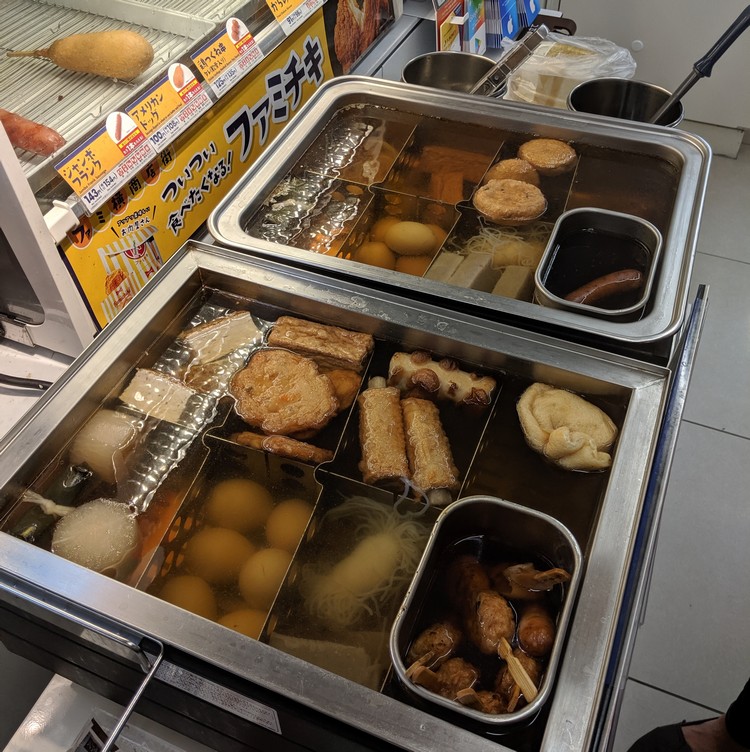
Oden at Convenience Stores in Japan
Most convenience stores in Japan will have oden during the winter months. You typically find this food at the front of the store, near the cashier. The most common convenience stores in Japan are Seven Eleven, Lawson and Family Mart.
You will find at least one of these convenience stores on virtually every block in the city. Purchasing premade food items at convenience stores is an easy way to travel cheap in Japan.
In some stores, an employee will serve you. In other stores, you help yourself. You simply take a bowl and add the specific items you would like. It’s common to add broth to the bowl to keep your items hot.
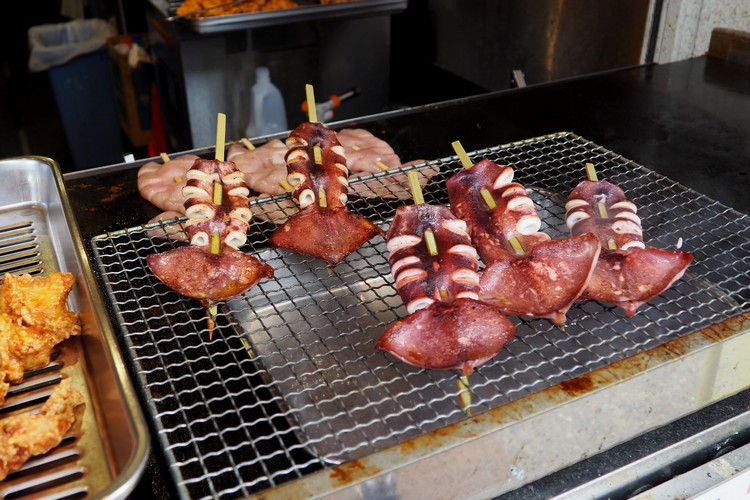
20. Street food at Japanese markets
There’s no shortage of interesting japanese cuisine at food markets in japan..
We like visiting markets when we travel because they provide insight into the food culture of a country. They typically have several vendors selling a wide variety of food items, so they’re a great place to let your curiousity run wild.
Some of the popular temples in Kyoto have rows of vendors selling grilled meats and traditional Japanese quick eats, like yakitori, grilled squid (above photo), takoyaki, hanami dango (sweet rice balls) and deep fried pastries.
If you’re looking for food to try in Tokyo, check out this list of the best food markets in Tokyo.
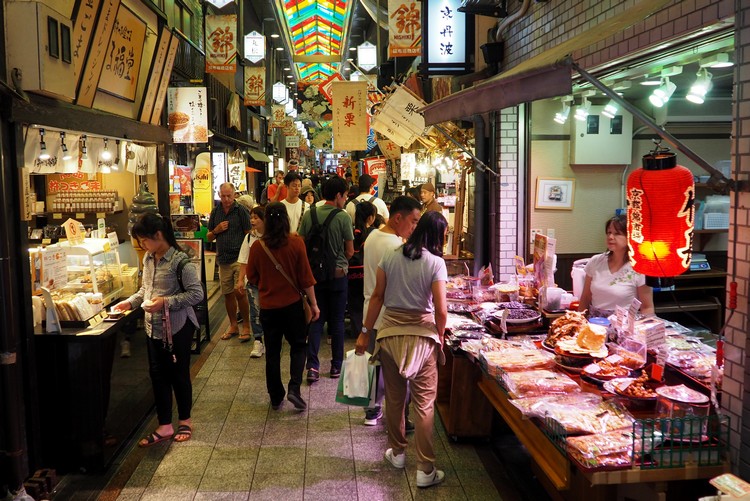
Nishiki Market in Kyoto
Known as Kyoto’s Kitchen , Nishiki Market is a great place to sample food in Japan. It’s a narrow, five block long shopping street that specializes food related items, like fresh seafood, grilled meats, produce, pickled food, dried foods and sushi.
If you’re unsure of what to try in Kyoto, Nishiki Market is a great place to start.
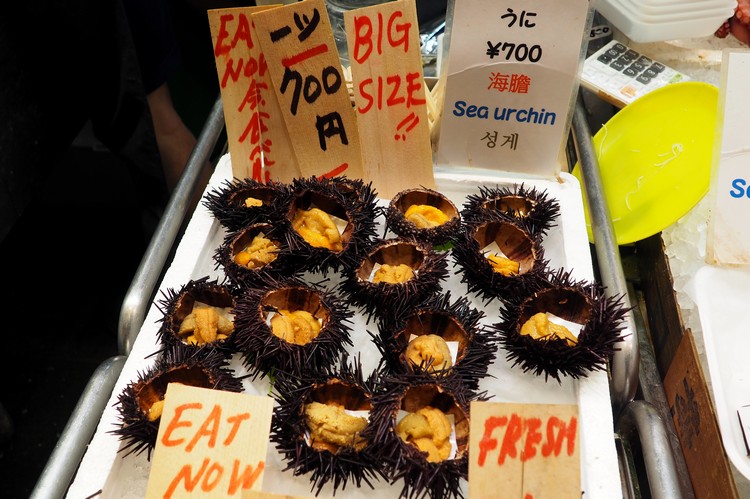
Ready to eat sea urchin at Nishiki Market.
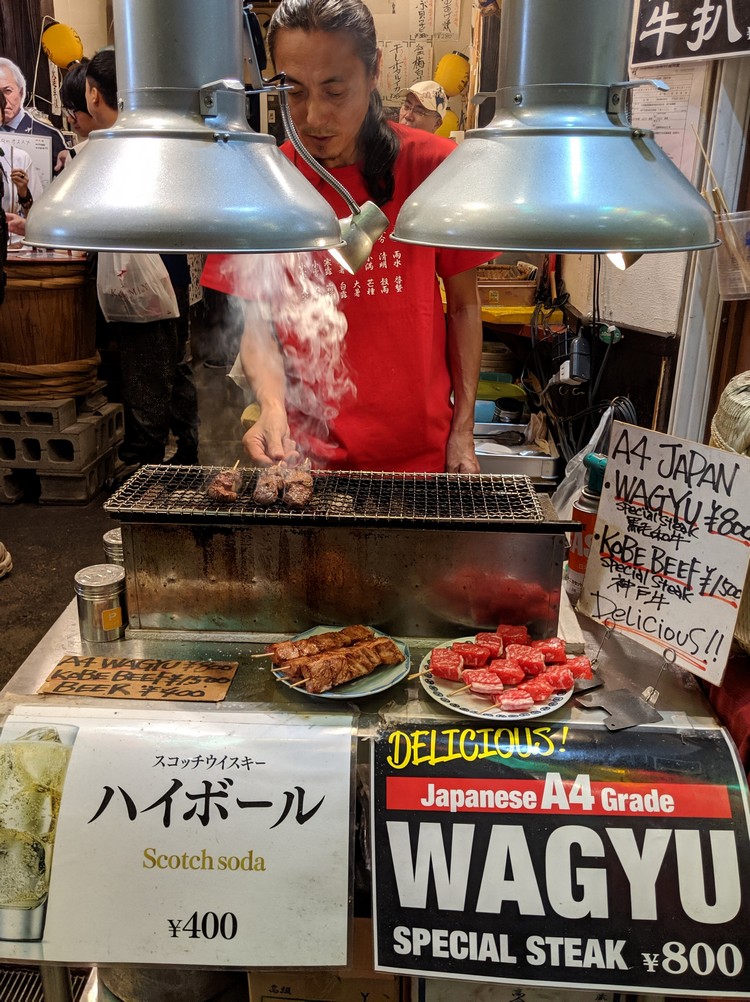
Grilled wagyu beef on a skewer at Nishiki Market in Kyoto.
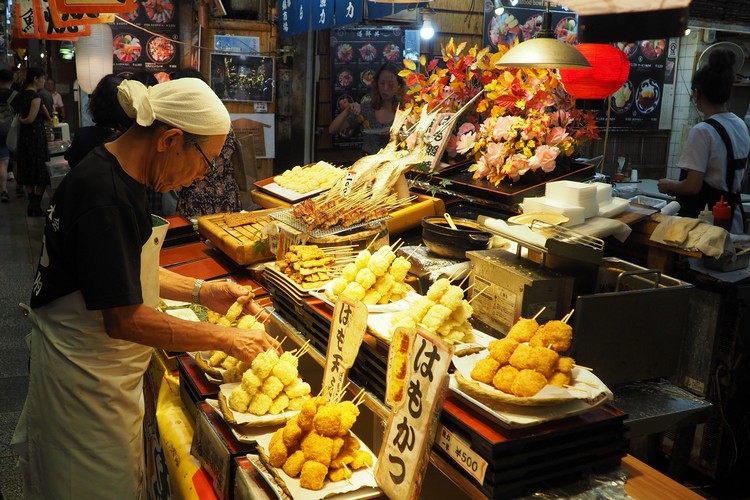
This vendor is selling a variety of steamed and fried food on a stick.
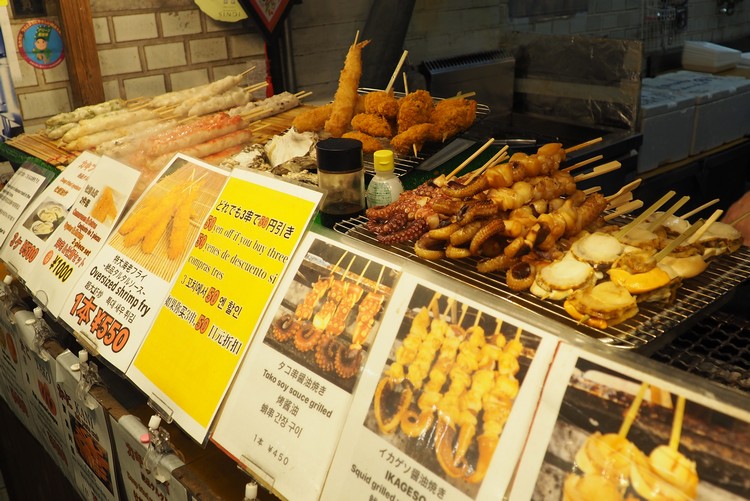
We like visiting small food vendors that sell a wide range of bite size items. It’s quick and easy way to try several different items.
Most vendors at Nishiki Market have English menus, which makes it easy for tourists to understand what they’re ordering. Each item costs between 400-800 yen, which is about $5.00 to $10.00 CAD.
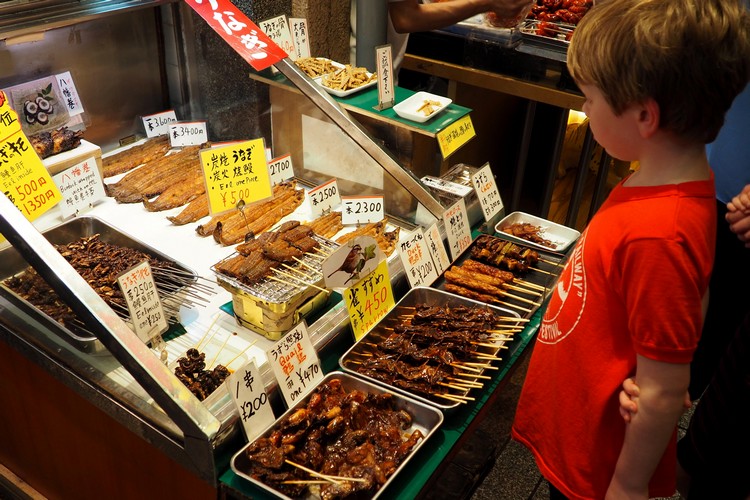
He’s not sure about these interesting food items on display at the market.
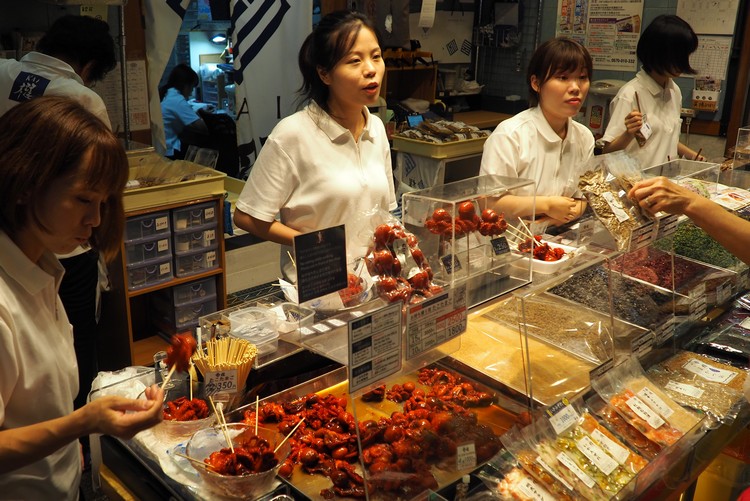
Sweet baby octopus with an egg brain?
One of the most popular and eccentric street food snacks found at Nishiki Market is Tako Tamago, which is a little red octopus on a stick.
The glazed baby octopus have a quail egg stuffed into the head, which makes for a unique flavour combo. The baby octopus has a sweet, candy-like flavour and the egg has a mushy, hard boiled egg texture. It’s quite rubbery and chewy. Not my favourite, but not too bad, either.
It’s certainly one of the more unique foods to eat in Japan, though I’m pretty sure most tourists purchase these little red octopus on a stick for the novelty. Because, let’s be honest, it’s not every day you get to eat an entire octopus on a stick, am I right?
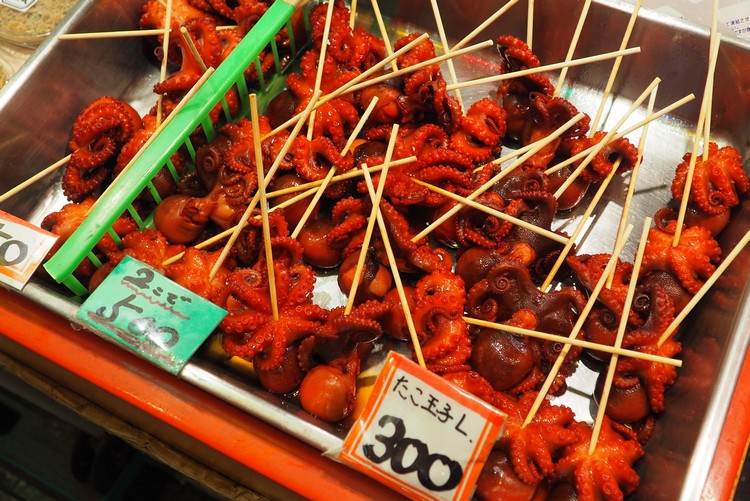
Dozens of vendors sell the popular red octopus on a stick at the popular Kyoto market.
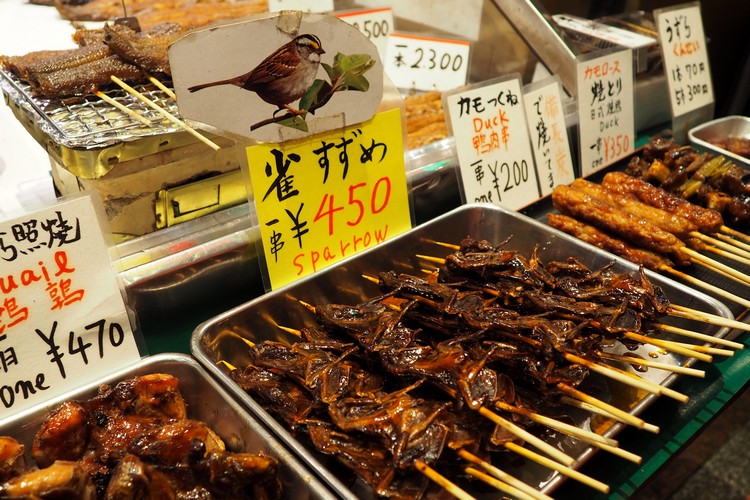
Another strange food in Kyoto is the grilled sparrow bird on a stick.
We’re told that grilled sparrow is a Japanese delicacy, but we couldn’t stomach eating this bat-like bird on a stick.
Have you tried grilled sparrow on a stick? Did you like it? Leave us a comment below.
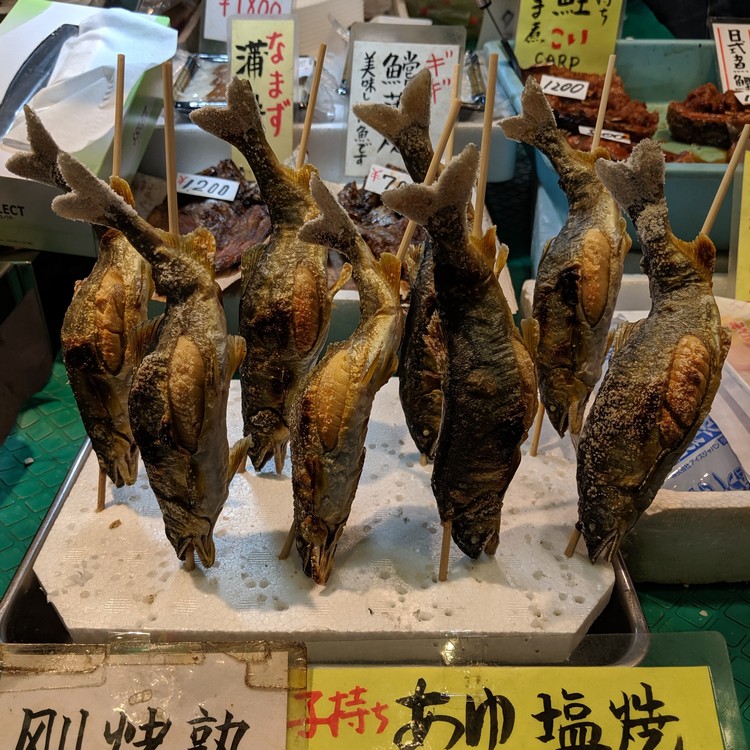
Salted fish on stick? This particular item stood out to us because we don’t often consider eating an entire fish, including the skin, tails, eyes, gills, bones, etc. I’m sure there’s a graceful way to tackle this fish without consuming everything, although I’m not sure this fish stick is for me.
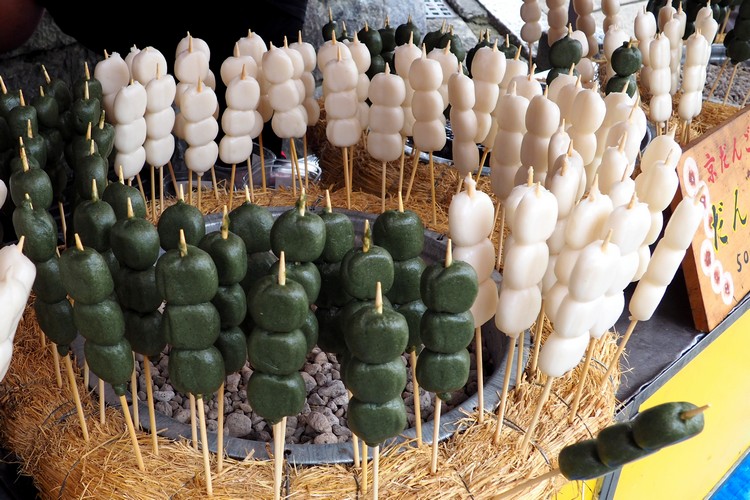
Dango is a popular Japanese sweet dumpling, similar to mochi. It’s typically served on a skewer with 3 balls per skewer. We sampled these green dango skewers near the entrance to Fushimi Inari Shrine in Kyoto.
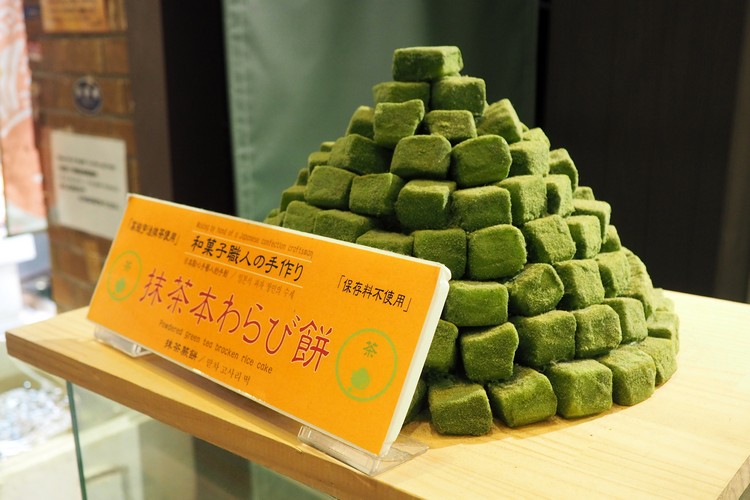
Matcha sweet rice cake on display at Nishiki Market. Matcha green tea is a big part of Japanese cuisine. You will find matcha flavoured everything in Japan, from chocolate bars to potato chips to ice cream.
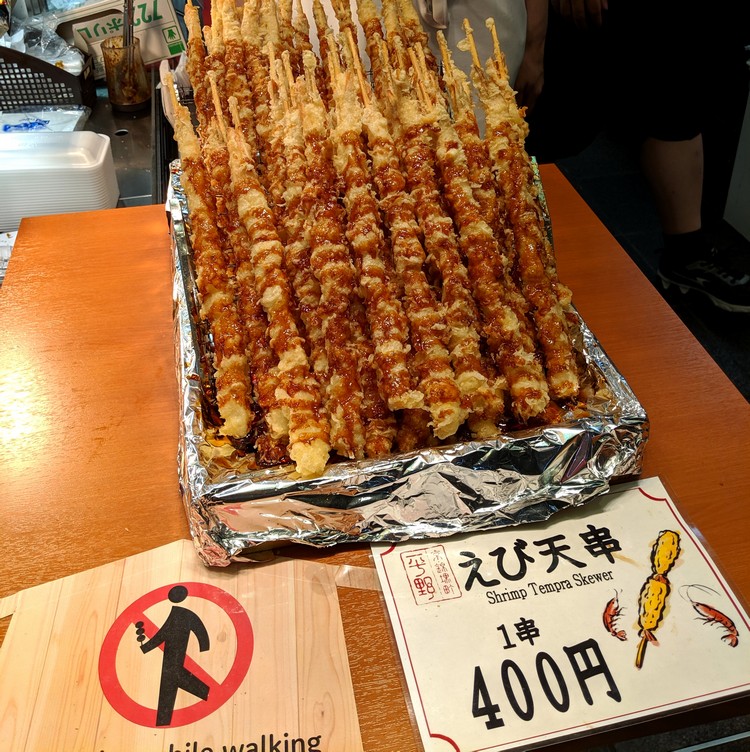
Is it okay to walk and eat in Japan?
Unlike north america, it is considered rude to walk and eat at the same time..
First time visitors to Japan will quickly learn that walking and eating in Japan is frowned upon. If you purchase food from a market or street vendor, the expectation is that you will NOT walk down the street or market while eating your food.
This applies to food purchased at convenient stores, like 7 Eleven and Family Mart. It is acceptable to eat at the place of purchase or close to the store. There’s usually a designated area for eating. If not, you will need to find an acceptable place to eat your food or bring it back to your hotel and eat it there.
Park benches in public spaces are generally okay, but avoid eating messy or strong smelling foods. It is also acceptable to drink while standing beside a vending machine.
Eating and drinking on local trains and public transportation is frowned upon. However, eating food on long distance express trains, like the Shinkansen, is acceptable.
Learn about the Do’s and Don’ts of Japan travel .
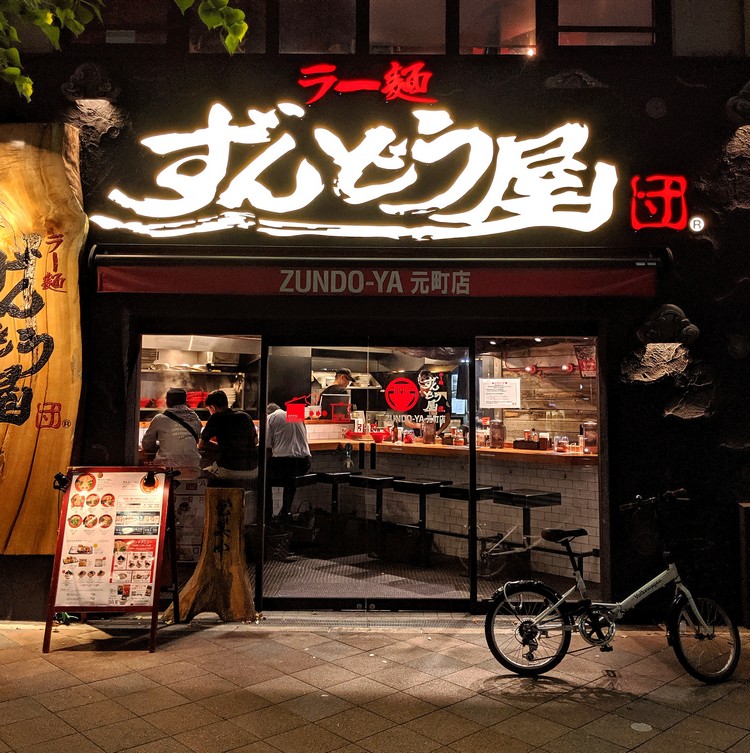
Do NOT tip at restaurants
One of the most common questions for first time visitors is – do you need to tip in Japan?
Tipping is not expected in Japan. In some cases, it’s actually considered to be rude.
This is one of the best Japan travel tips we can give – you do NOT tip in Japan.
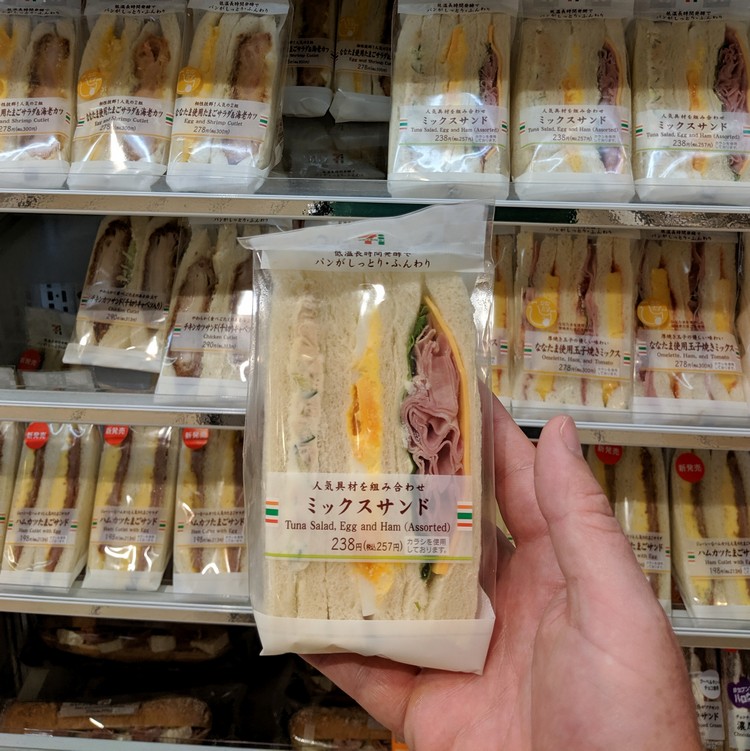
Food from convenience stores in Japan
We rarely eat at convenience stores in Canada, unless we’re on a road trip or there aren’t other food options available. In Japan, eating at convenience stores is quite common.
Japanese convenience stores have a good selection of prepared food, from sandwiches to bento boxes to baked goods. We often grabbed prepackaged sandwiches (picture above) and pastries for breakfast each morning.
One of the most popular snacks to eat in Japan is Onigiri . Onigiri are rice balls formed into triangular or round shapes and wrapped in seaweed (nori). Some are filled with fish (tuna, salmon, mackerel, shrimp, etc), chicken, pork, vegetables, egg and fried food, like tempura and tonkatsu. Onigiri is a cheap Japanese food that’s is easy and widely available at almost every convenience store in Japan.
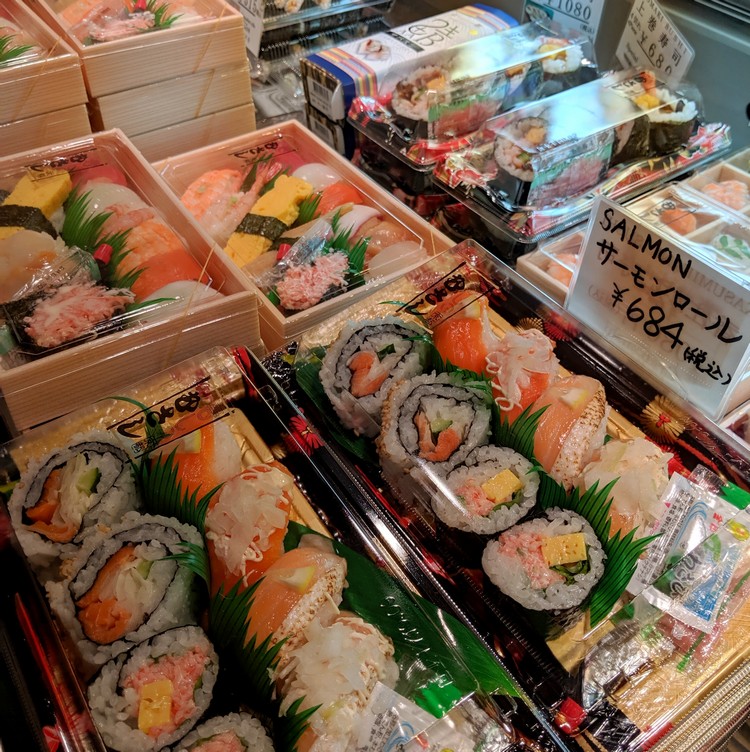
Variety of prepackaged sushi rolls and nigiri combos at the Kyoto train station.
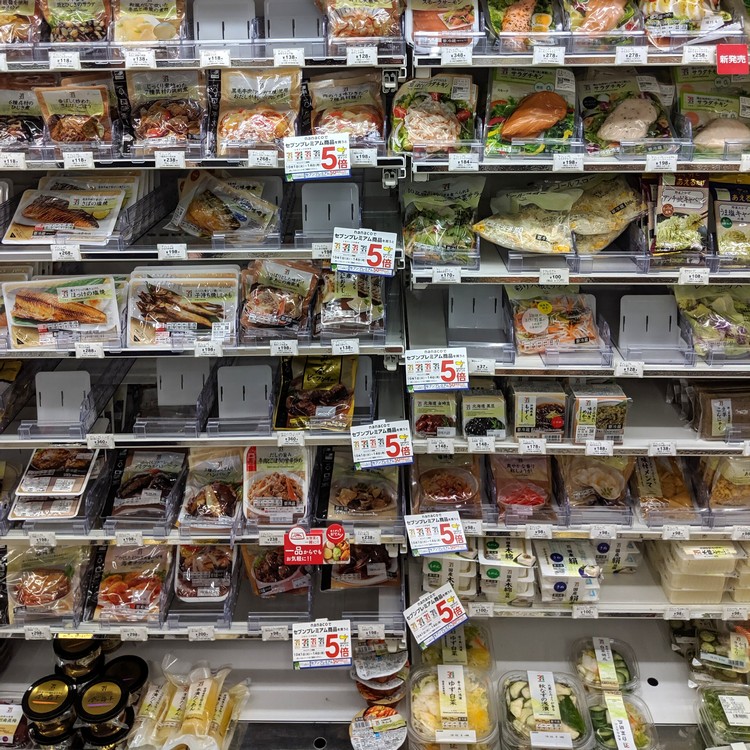
Convenience stores in Japan have plenty of prepackaged meals available for takeaway.
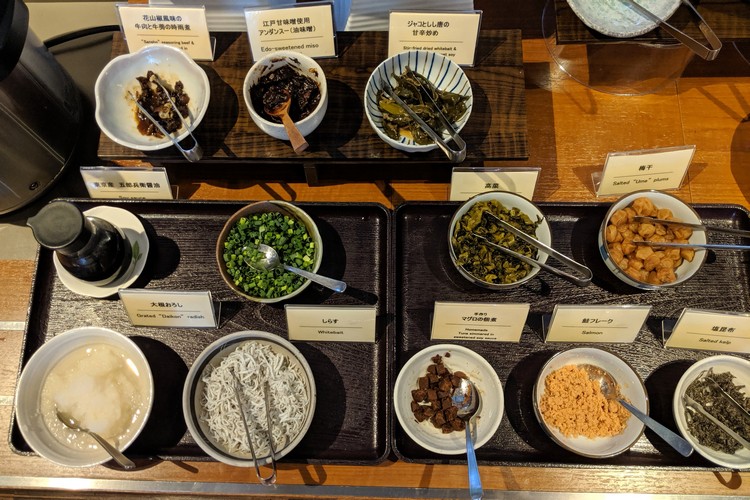
Japanese Breakfast at Hotels
I though it worth mentioning the hotel breakfast situation in Japan, given that many European travellers expect breakfast to be included with the hotel price.
Depending on your hotel, breakfast may be available. But don’t expect breakfast to be included in the hotel room price. Some budget hotels will not have breakfast available at all.
Japanese breakfast is quite different from North American and European breakfast.
Typically, a traditional Japanese breakfast consists of steamed rice, miso soup, grilled fish and a variety of side dishes. You will find a lot of pickled vegetables, garnishes, dried food and other items that you might not associate with breakfast.
This is a great way to sample new flavours and items you might not order at a restaurant. Ask questions and give the Japanese breakfast items a try. You never know, you might just like fermented soy beans (natto) and dried horse mackerel for breakfast?
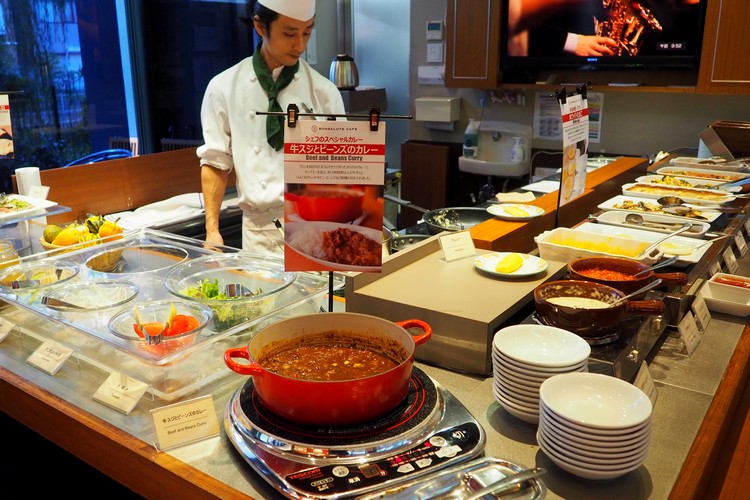
The breakfast buffet at the Hotel Gracery Tamachi in Tokyo.
Order your food from a Vending Machine
One of the things we love about Japan is that everything is efficient and convenient. A perfect example of this efficiency is the electronic vending machines located outside many Japanese restaurants.
The touch screen machines often have photos of each dish, which is convenient and avoids the potential language barrier that may arise if you had to order from a server who does not speak English.
The process is simple. You select the food you want from the touch screen machines, pay with cash or credit card, grab your receipt and head inside. The food is then delivered to your table or your number is called and you pick it up from the counter.
Once you are finished eating your meal, you simply get up and leave. No need to wait for a server to bring the bill or wait to pay. It’s a very efficient system that removes service breakdown.
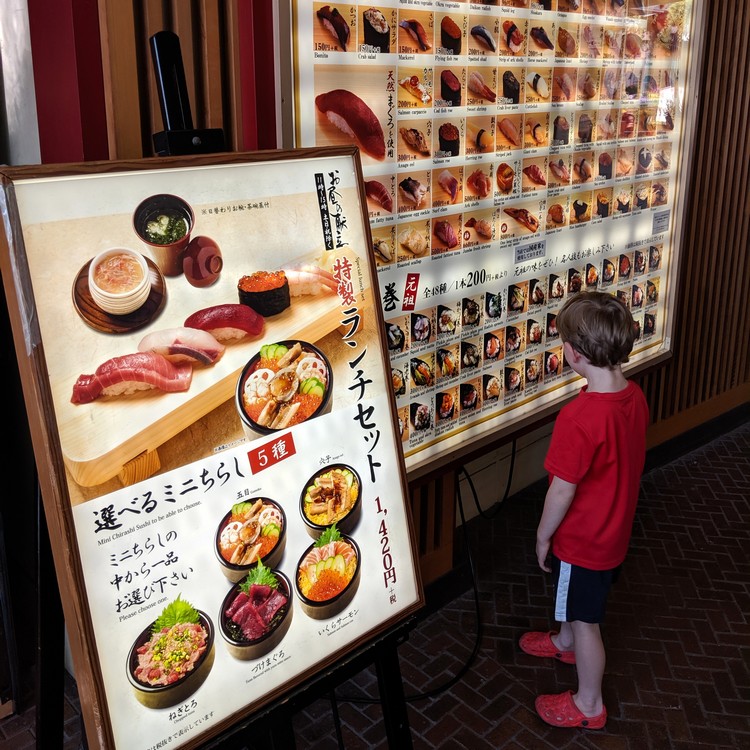
Food in Japan for kids
If you’re travelling to Japan with kids, you’re liking concerned about whether your kids will enjoy the food in Japan. There’s nothing worse than constantly battling your kids to eat.
Our boys like Japanese food, so we knew they would like eating at Japanese restaurants. However, our concern was that after a few days they would get bored and start complaining.
Fortunately, Japanese food is quite diverse and, as you’ve seen in this beginner’s guide to food in Japan, there are plenty of options to choose from.
Travel tips for eating in Japan with kids
- Shop at convenience stores. Pick up prepackaged food, snacks, pastries and drinks from convenience stores and bring them back to your hotel room. You don’t have to dine out for every meal. Give yourself a break if your kids are burnt out.
- Vending machines are everywhere in Japan. Keep some change in your pocket because you’ll find these vending machines do the trick when your kids are thirsty.
- Look at the plastic dishes in the window. Most Japanese restaurants have plastic replicas on display. Let your kids see the available options and pick a dish that interests them before you enter the restaurant. That way there’s no confusion over what to order when you sit down.
- Download Google translate. When you have a Lost in Translation moment, ask the Google for help.
- Eat breakfast in your hotel room. We purchased a bag of Frosted Flakes from a Family Mart and our boys had cereal for breakfast each morning. It saved us time and money.
- Bring snacks from home. Pack your luggage with your kid’s favourite snacks, treats and cereal. Sometimes a familiar treat is all it takes to get your kids feeling normal again.
- There are lots of fast food restaurants in Japan. Sometimes chicken nuggets from McDonald’s is the answer. We get it. Don’t worry, Japan has most of the big names in fast food. It’s okay to give yourself some comfort food from home when you’re travelling.
Read these helpful Japan travel tips for first timers .
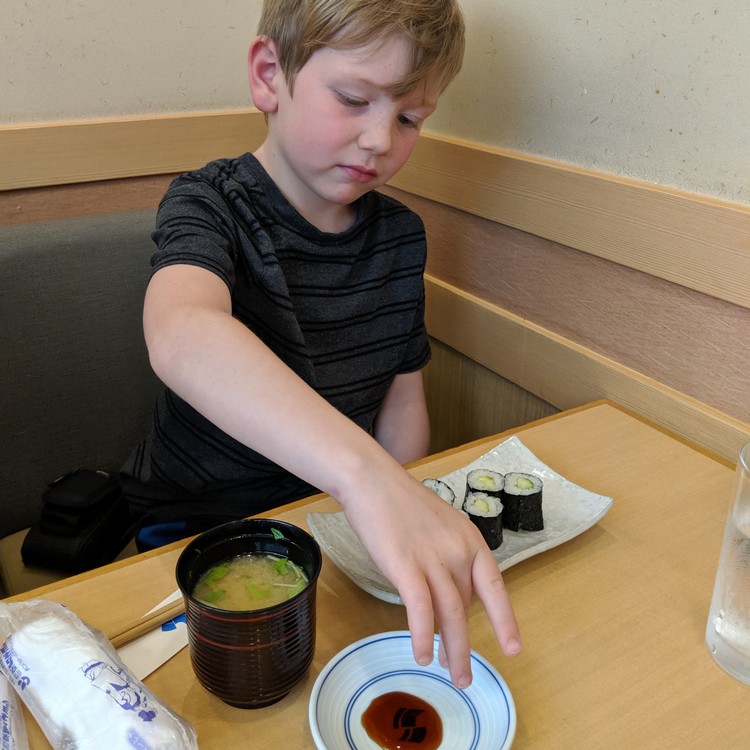
For an easy introduction to sushi, order your kids the cucumber roll (kappa maki) with a miso soup. Let them play with the chopsticks and experiment. If they don’t like the sushi roll, no big deal. These are typically the cheapest items on the menu.
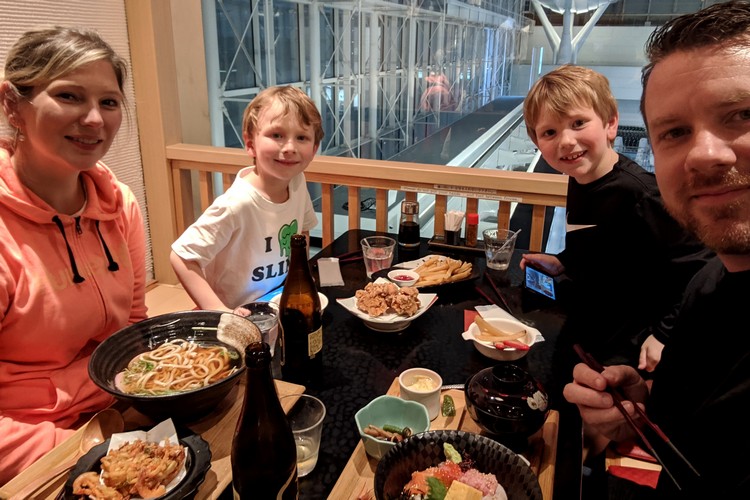
Most Japanese restaurants that serve chicken karaage will also have French fries on the menu. We told our boys that we ordered them chicken nuggets and fries. They rarely noticed the difference.
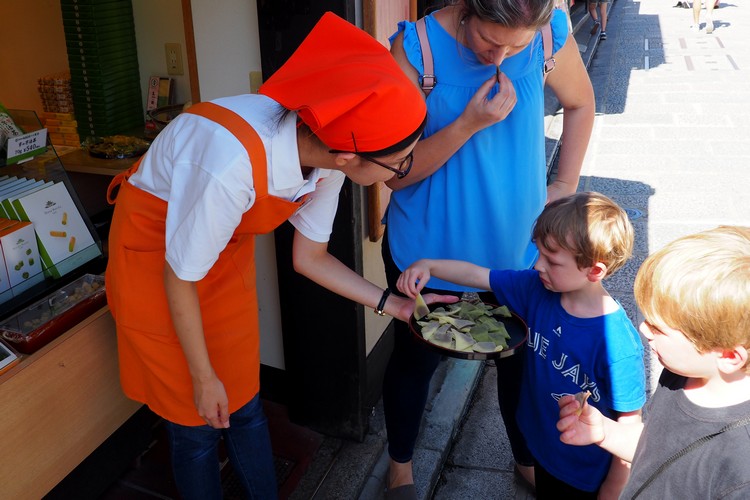
Our boys did pretty good at trying new food. Like most kids, their natural default is to resist food that is different or foreign. However, the more Japanese food they tried, the more comfortable they got.
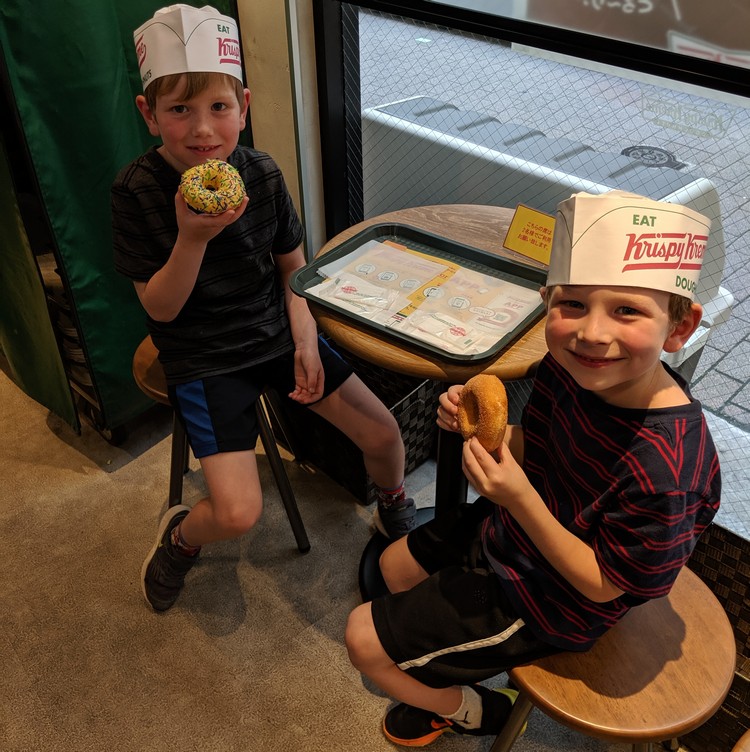
Don’t worry, if your kids don’t like the food in Japan, there’s always donuts!
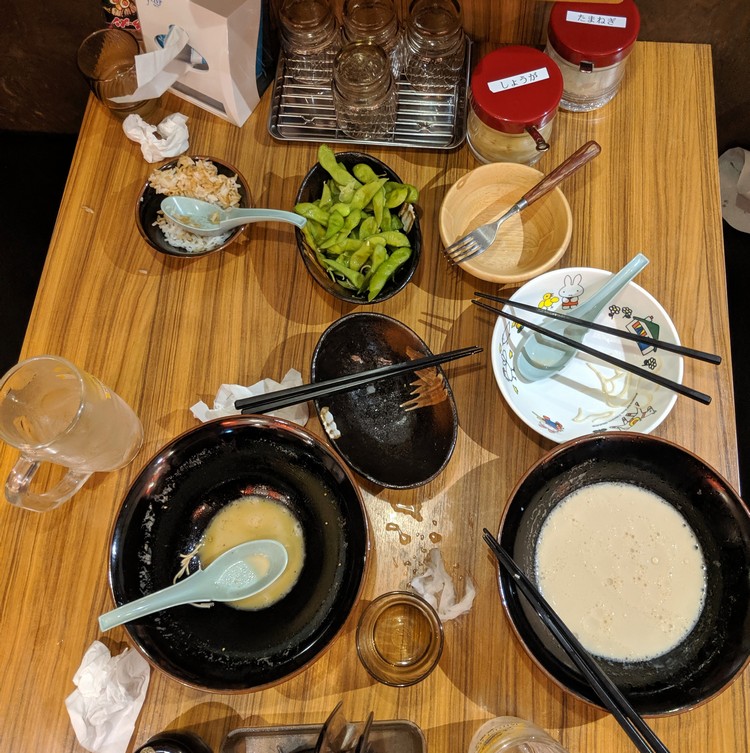
And that’s a wrap! We hope you enjoyed this tasty beginner’s guide to food in Japan.
More blog posts from our trip to Japan:
- How to spend 3 days in Tokyo: Travel guide for first time visitors
- Staying at Tokyo Disney Resort – what you need to know
- 15 Things to do in Kobe Japan
Have you visited Japan? What is your favourite food in Japan?
Leave a comment below. Our readers thank you!
Related posts:
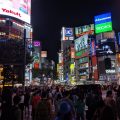
10/20/2020 at 3:33 pm
Very good presentation of food in Japan! Having family in Tokyo we have been traveling around Japan the last 8 years, so I find this post the best about your experience in Japan! It is a pleasure to follow you ,thank you for sharing your travel experiences! You inspired us to go to some places in BC! And it was worth it…We can’t wait to take our grandchildren living in Tokyo to some places where you have been traveled with yours! Wonderful travel blog!
12/21/2020 at 7:14 pm
This is a great intro to Japanese food! Japan is obviously one of the great places to try new things!! And it looks like you and your family tried a lot!! Thanks for sharing and happy #TravelBlogTuesday 🙂
02/19/2021 at 3:31 pm
What a great source and extensive knowledge of food from here. A great read and will certainly be using the post in the future
07/19/2021 at 5:53 am
What a fabulous post about food in Japan! Should be required reading for first-time travellers to Japan. Happy travels.
Leave a Reply Cancel reply
Your email address will not be published. Required fields are marked *
Yes - Subscribe me to your monthly newsletter!
This site uses Akismet to reduce spam. Learn how your comment data is processed .
- Food & Drinks
50 Japanese Foods to Try While You Are in Japan

- tetuya.asakura
In many countries, Japanese food typically meant sushi, sukiyaki and tempura, but now Japanese gourmet foods are making a name for themselves all around the world! No matter your tastes, you'll love eating your way through Japan. Here, we would like to introduce some of the most delicious Japanese dishes and foods to try during your stay in Japan.

This post may contain affiliate links. If you buy through them, we may earn a commission at no additional cost to you.
Sushi is a traditional Japanese food made by combining vinegar rice and seafood (although sometimes other ingredients are also used). There is a type of fermented sushi, known as nare-zushi, but the most typical types of sushi are nigiri-zushi and temaki-zushi.
There are plenty of other ingredients available for those who do not like raw fish, including boiled prawns and grilled conger eel. You can find sushi all around Japan, but the sushi from restaurants in high class areas like Ginza or close to fishing ports is especially delicious. If you are looking to eat cheaply, you can visit a kaitenzushi, or conveyor belt sushi restaurant , where you can enjoy sushi for 100 yen a plate.
Being the land of sushi, all the available options may be overwhelming. If you're looking for a delicious sushi restaurant in Tokyo, why not consider Ginza Saisho , where you can savor delicious, fresh seafood sushi. Meanwhile, Osaka is home to Amano , which is run by a chef with a stellar history when it comes to working with fish.
Don't miss our Ultimate Sushi Guide for important manners and tips you'll need to know when eating sushi in Japan!
Tempura is a Japanese dish made from seafood, fresh vegetables and other ingredients dipped in a flour and egg batter and fried in oil. While you can enjoy tempura at all sorts of restaurants, if you want to try it at its best, we recommend going to a specialist tempura restaurant, where each dish will be brought to your table as soon as it is ready, even if you order a lot!
If trying tempura at a specialty restaurant peaks your fancy, both Tempura Ono in Tokyo and Tenyu in Kyoto offer scrumptious tempura prepared with fantastically fresh ingredients.
3. Sukiyaki
Sukiyaki is a Japanese dish in which meat and vegetables are stewed in an iron pot. The sauce, known as warishita, is made from soy sauce and sugar. There is a lot of variation in the ingredients and way of eating the dish depending on the region, with some areas mixing beaten egg into the sauce to create a milder flavor. If you are looking to enjoy a lot of great beef, this is the dish for you!

Ramen is a noodle soup dish which has grown to become incredibly popular and is thought of as a byword for Japanese food. Originally, the soup was made from a chicken bones, but in recent years, pork, beef and seafood also being used in the soup, creating a diverse range of tastes. In addition to the typical salt, soy sauce and miso flavors, you can even find curry-flavored ramen now. There is also a type of ramen where the noodles and soup are served separately, known as tsukemen. If you want to visit a ramen restaurant in Japan, first check out 5 Things to Keep in Mind When Trying Ramen in Japan . It's a great primer to get you ordering like a pro!
As it is a staple in everyday Japanese cuisine, popular and famous shops will usually have lines out the door of people waiting to get a bite of their delicious ramen. Menya Itto is one such shop, attesting to its taste, and has configured a system to make waiting more convenient for its customers. How often can you say you've had a bowl of ramen from one of the most famous establishments in Japan?
5. Curry Rice
While curry has its origins in India, the curry we eat in Japan is a unique, localized dish based on the curry brought over to Japan from the UK. Made with meat and vegetables (carrots, potatoes, onions, etc.) flavored with curry powder, stewed, and served with rice. Sometimes fried foods, such as pork cutlets, are placed on top of the dish. While there are some specialist curry restaurants, you typically won't have any problems with the curry at a regular restaurant or chain restaurant.
6. Tonkatsu
Tonkatsu is a popular Japanese dish based on western pork cutlets, where a thick slice of pork is dipped in a flour and beaten egg batter, coated in breadcrumbs and fried in oil. There are both sirloin and fillet tonkatsu, with the fillet tonlatsu being more expensive. While quite tasty even at a cheap restaurant, we really recommend trying tonkatsu at a specialist restaurant.
This traditional Japanese food is a dish of noodles is made from soba (buckwheat) flour eaten with a soy sauce and sugar sauce, and toppings such as egg, tempura or other ingredients. The noodles you get from a soba noodle shop will be particularly good, but very expensive, so it might be good to try the soba at a standing restaurant. The different dishes and toppings are usually on display in a showcase outside the restaurant, making it easy to decided what to order.
Yamori is a soba restaurant run by a chef so knowledgeable about soba that the menu allows customers to taste soba in a wide variety of ways. It is the perfect place to understand the complexity of soba!
Udon are noodles made from kneaded wheat flour, and eaten with a sauce made from soy sauce and sugar, similar to soba. You can enjoy udon on at the standing soba restaurants, but as the firmness of the noodles, known as koshi, is a key part of the dish, we really recommend eating it at a specialist udon restaurant. In winter, why not try the delicious noodle stew, known as nabe yaki udon?
Karaage is chicken seasoned with soy sauce, salt and a number of different spices, sprinkled with starch and fried in oil. It is like the Japanese version of fried chicken, but the flavor is very different. There are a lot of local variations, with for example chicken nanban in Miyazaki, where the karaage are covered with tartare sauce, and tebasaki in Nagoya, where the karaage are covered in a sweet and spicy sauce. We definitely recommend trying these out!
10. Yakitori
Yakitori is a dish in which skewered chicken seasoned with a sweet salt or soy sauce based sauce and barbecued. You can usually find yakitori at Japanese bar/restaurants, known as izakaya, but we recommend eating it at a specialist yakitori restaurant, where you can enjoy all sorts of different parts of the chicken at quite a reasonable price (unless you go to a high class place, where it will cost quite a lot.).Another popular Japanese food is skewered pork, or yakiton in Japanese, which is delicious as well!
At Taira in Tokyo, guests can enjoy yakitori prepared with free-range chicken and a plethora of sake that perfectly complement the meticulously grilled skewers.
11. Yakiniku
Yakiniku is a dish in which beef dipped in a sauce and grilled directly over a fire. The freshness of the meat is very important to the dish. By lightly grilling the dish, you can enjoy the soft flavor of Japanese beef. The most popular dishes are sirloin (known as rosu in Japanese) and kalbi (Korean-style marinated meat), but at a yakiniku restaurant you can enjoy all sorts of different types of meat. The price of the meat depends on the quality, so if you want to try real yakiniku, we recommend going once to a high-class yakiniku restaurant. If you want to know more, our Ultimate Yakiniku Guide has you covered!
Both YAKINIKU 37west NY in Tokyo and Wagyu Kappo Toraichi in Osaka offer sublime dining experiences, serving delectable yakiniku among a luxurious atmosphere. Here, your mouthwatering beef is sure to be prepared to perfection!
12. Sashimi
Sashimi is a traditional Japanese food made of raw selfish cut into small pieces and served with soy sauce. By adding condiments like wasabi or ginger, sashimi becomes even more delicious. You can enjoy sashimi in places other than Japan, but the level of freshness is different. If you are looking for somewhere cheap to enjoy sashimi, why not try a set meal at a restaurant near a fishing port, but if you’re willing to spend a little more, you should visit a sushi restaurant or a traditional Japanese restaurant - we guarantee you won’t be disappointed! If you stay at a Japanese inn, you will probably find sashimi on the menu there.
13. Robatayaki
Robatayaki is not quite a type of food, but more of a type of restaurant. At the restaurant, fish and vegetables are cooked over the fireplace and handed to customers with a large wooden spoon, known as a horikaeshi-bera. The ingredients are cooked directly on the charcoal, giving them a unique flavor. Robatayaki restaurants also have a unique code when ordering. For example, if you ask for a potato, or jagaimo in Japanese, the waiter/waitress will call out, Jagaimo ippatsu! for the order rather than the regular ikko counter. If this sounds like a culinary experience you would like to try, you can check out Robatasho in Tokyo!
14. Shabushabu
A dish in which meat and vegetables are boiled in water flavored with a stock of konbu and other ingredients. The typical dipping sauce for shabushabu is either a ponzu or sesame based sauce. The key to the dish is lightly submerging the meat in the water before eating. You can order both beef and pork, and additional orders are possible, and we definitely want you to try the pork as well. There are also cases where udon noodles are added to the dish at the end of the meal. Unlike some of the other dishes, you can’t really find shabushabu in non-specialized restaurants, although a few sukiyaki restaurants do offer shabushabu as well.
A dish from Sendai where the beef tongue (gyutan) is prepared in a special way that softens the meat, and because of this, you can only find it in special beef tongue restaurants. In a typical dish, you will usually have rice cooked with barley (mugimeshi) and a beef tale soup along with the beef tongue. With the mugimeshi, you will usually be served tororo, or grated yam, along with various pickles, such as white cabbage or chili peppers peserved in miso. Different to beef tongue in yakiniku restaurants, the beef tongue in special gyutan restaurants is quite thick.
16. Kaiseki Ryori
Kaiseki ryori is again not a dish itself, but a style of eating most suited to a banquet. The menu for the meal usually consists of ichijusansai (a soup, sashimi, a grilled dish and a cooked dish), in addition to an appetizer (otooshi), fried dishes (agemono), steamed dishes (mushimono), a type of Japanese salad (aemono), and pickled dishes, including others. To close the meal, rice, miso soup, pickles (konomono) and fruit (mizugashi) are served. Naturally, this sort of meal is only available at special kaiseki ryori restaurants, and a reservation is usually required. On top of this, the price can be very high, which makes it difficult to recommend. On the other hand, you won’t be able to find this outside of Japan, so if your wallet or purse permits, why not visit a kaiseki ryori restaurant during your stay in Japan?
Both Fukudaya in Tokyo and Kentan Hirobe in Kyoto are Michelin-starred kaiseki restaurants, ensuring high-quality, delicious dishes made with fresh seasonal ingredients.
A Japanese dish in which a bowl of rice is topped with beef. Gyudon, or beef bowl, has already become a popular dish around the world, but the gyudon you have in Japan may be slightly different to what you find elsewhere. For a start, the quality of the rice is different. While in Japanese gyudon restaurants, the rice they are using is probably not that expensive, but the beef really goes well with Japanese rise. We also recommend pouring beaten egg on top of the beef!
18. Chankonabe
A Japanese food where highly nutritious meat and vegetables are boiled in a large pot. Chankonabe is famous as a dish used by sumo wrestlers to build up their bodies. If you want to try chankonabe, we recommend a restaurant run by a former sumo wrestler.
The long-standing Chanko Kawasaki is one such restaurant. Here, you can enjoy authentic chankonabe in an establishment located in a Tokyo neighborhood commonly associated with sumo wrestling.
19. Motsunabe
A famous Japanese dish from Fukuoka in which beef and pork offal meat is cooked in a pot with various vegetable, such as cabbage and Chinese leek, known as nira in Japanese. You can add more ingredients as you cook it, meaning you can eat as much as you want. After finishing the main dish, it is common to add Chinese style noodles, chanpon noodles to the soup, or rice to make a rice gruel from the soup. You can find motsunabe restaurants in Tokyo , but as you can imagine, the flavor is different from the original Fukuoka version.
20. Onigiri
An onigiri is a boiled rice ball lightly salted and often filled with ingredients such as umeboshi (dried plum), salmon or cod roe, all wrapped in a sheet of nori (dried seaweed). To start, we recommend trying the tuna mayonnaise-flavored ingot. The21.re are specialist onigiri stores, but you can find them at convenience stores as well, so you can enjoy them whenever and wherever you go. They are surprisingly popular with foreign people.
Onigiri Asakusa Yadoroku is one of the oldest onigiri specialty shops in Tokyo, where onigiri are made fresh for the customers. It is a great place to stop by when exploring the popular neighborhood of Asakusa.
Next: No.21-40 Further Japanese foods you must try in Japan
The information in this article is accurate at the time of publication.
tsunagu Japan Newsletter
Subscribe to our free newsletter and we'll show you the best Japan has to offer!

About the author
Related Articles
Related interests.
- Donburi & rice
- Fish & Seafood
- Sweets & snacks
- Other Japanese food
- Japanese alcohol
- Restaurant types
- Noodles & Pasta
- Non-alcoholic drinks
Restaurant Search
Tsunagu japan sns.
Subscribe to the tsunagu Japan Newsletter
Sign up to our free newsletter to discover the best Japan has to offer.
Connect with Japan through tsunagu Japan
Let us introduce you to the best of Japan through our free newsletter: sightseeing spots, delicious food, deep culture, best places to stay, and more!

The Ultimate Japan Itinerary for First-Timers: From 1 to 3 Weeks

I’ve yet to meet a traveler who didn’t love their time in Japan . It’s just one of those countries that everyone loves. How can you not? The food is carefully crafted and delicious; the history and culture are both rich and long; the landscape breathtaking; and the people super friendly and polite.
Japan remains one of my favorite countries. No matter how long I visit, it’s never enough. I always leave wanting more.
But the country always seems forbidding to many travelers. It definitely still has that “exotic” stereotype that makes people think it’s hard to travel around.
Where should you go? What should you include in your Japan itinerary? Should you buy a JR Pass to help you get around?
To help you out, here are a few suggested itineraries based on my years of visiting that will ensure you see the best sites on your Japan trip — as well as get off the beaten path and get a real sense of Japanese culture!
Table of Contents
Japan Itinerary: Know Before You Go
Japan itinerary: one week, japan itinerary: two weeks, japan itinerary: three weeks.

Just be sure to get one BEFORE you go as you cannot purchase them on arrival. For more information on the pass, including how much they cost and how you can get one, read this blog post . It has everything you need to know!
Mobile Data in Japan In Japan, English isn’t widely spoken (especially outside of the major cities) so having access to the internet is vital for checking addresses, using translation apps, and looking up things to see and do. The easiest way to get data is through an international eSIM for Japan .
An eSIM allows you to access mobile data via a QR code so you can have internet wherever you are, without worrying about physical SIM cards or roaming charges. This will save you a lot of time and hassle when using apps like Google Maps, Google Translate, Instagram, and YouTube. It will also come in handy for checking menus at restaurants (since they are rarely in english).

Day 1 & 2: Tokyo Chances are you’ll be starting your trip in Tokyo , since it’s home to the country’s biggest international airport. If your trip is seven days long, activate your JR Pass right away, so that you can take advantage of the free JR trains that run through the city.
While you could easily spend your entire week in Tokyo and not get bored, here are some of the highlights:
Visit the fish market – In 2018, Tokyo’s main fish market moved to Toyosu, which is twice the size of the old one, Tsukiji, making it the largest in the world. While a lot of good restaurants moved too (Sushi Dai being the most famous), I find the place itself very stale, since you can no longer wander the floor (you look down via a walkway above; you also need a visitor’s pass to enter).
The old outer market in Tsukiji is still great though, and you can still find food and stores there too. You can wander alone and just eat and shop until you can’t anymore! Most businesses open at 6am, so it’s a perfect place to go in the morning when you wake up early because of jet lag. Food and drink tours of the Tsukiji Outer Market are available for around 13,500 JPY.
See Sensoji Temple – Sensoji is beautifully painted and sits in a scenic spot near a five-story pagoda and the famous Kaminari Gate. There’s a huge statue of Kannon, the goddess of mercy, inside the main hall. It’s always busy but is worth seeing with your own eyes. The temple is free to visit.
Drink in Golden Gai – This alleyway of back-street bars is a lively place to drink at night and has a bit of a red-light-district feel to it. It is not to be missed. Even if you don’t drink, be sure to wander about. Arigato Tours offers tours of the area where you’ll learn about the neighborhood while stopping to sample Japanese classics like sushi, yakitori, and ramen. Tours are 23,900 JPY and include a drink and dishes at four food stops.
Visit the Imperial Palace – When the emperor moved from Kyoto to Tokyo in 1869, he took Edo for his new residence and renamed it Tokyo. Though you can’t go inside (or get very close), the building is amazing. It is surrounded by lovely grounds and a park, and there’s a moat around the stone walls. You can also see the changing of the guard, though it’s a relatively low-key and unassuming ceremony.
Watch a sumo match – Kokugikan, Japan’s most famous sumo arena, hosts tournaments three times each year. The wrestling that we see today dates to the 17th century, though its origins go back even further, and it’s still one of the most popular traditions in the country. If you’re in town at the right time, this is a must-do! Tickets sell out quickly, so act fast. You can book a ticket online here (you’ll be accompanied by a guide too, so you can learn more about the tradition as it unfolds before your eyes).
If you have more time, consider taking a day trip to Kamakura to see the giant Buddha statue (Daibutsu). It is over 13 meters (42 feet) tall and dates back to the 13th century. The journey is around 90 minutes each way — and free with the JR Pass !
For delicious food, some of my favorite bars and restaurants include: Uogashi Nihon-Ichi (Standing Sushi Bar), Nemuro Hanamaru KITTE Marunouchi, Motodane, Tokyo Whisky Library, Ichiran Shibuya, and Uohama.
WHERE TO STAY IN TOKYO : Hostel Chapter Two – A small, family-run hostel not far from Skytree Station in Asakusa. I really like the shared kitchen and common room, as there’s a real social feel to them.

With its beauty come lots of crowds though, so try to visit outside of the busy summer months. Even with lots of tourists, though, the city is still magnificent and has a lot to offer. Some things to see and do that you shouldn’t miss are the following:
Visit the Golden Pavilion – This famous (and picturesque) temple dates to the 1950s, when a monk burned down the previous temple (from the 14th century) while trying to commit suicide. It’s a UNESCO World Heritage Site and one of the most-visited destinations in the country!
Explore Gion – Gion, the historic geisha district, is renowned as being one of the most iconic and atmospheric areas of town. It’s known for its traditional wooden machiya houses, narrow alleyways, cobblestone streets, and preservation of geisha (known locally as geiko) culture. Lining the main street are ochayas (teahouses where geishas entertain), small shops, and many restaurants, ranging from upscale kaiseki restaurants serving traditional Kyoto cuisine to casual eateries.
To really learn more about this amazing party of town and its past, take a walking tour of Gion . You’ll learn a ton and get a lot of context. They cost around 1,800 JPY.
Wander in the Bamboo Forest – For a relaxing break, head to Arashiyama and let the dense and towering stands of bamboo envelop you. Located near the famous Tenryu-ji temple, it’s one of the most beautiful places in the entire country. It’s not that big, but there are some hidden areas to explore. Just make sure to arrive early if you want to enjoy it without the crowds (it fills up fast after sunrise).
While there, I would also recommend visiting the Okochi Sanso Garden, which (along with the home) belonged to the famous Japanese actor Denjir? ?k?chi (1898–1962). It’s not free (it’s 1,000 JPY), but it’s really nice and has some wonderful views.
Admire Ryoan-ji temple – This is my favorite temple in Kyoto. Originally established in 1450 as a residence for a high-ranking samurai, it was soon converted into a Zen temple and is now a UNESCO World Heritage Site, with a mausoleum that houses the remains of seven emperors. Its traditional rock and sand garden is considered one of the best in the country. There’s also a teahouse where you can experience the traditional Japanese tea ceremony ( chanoyu ) as you overlook the Kyoyochi reflecting pool.
Wander the Nishiki Market Nishiki Ichiba is now one of the biggest indoor markets in town. Known as “Kyoto’s Kitchen” and spanning over five blocks, it is full of vendors selling traditional dishes from the region, classic Kyoto souvenirs, and really just about anything else. There are over a hundred stalls here, many of which have been in the same family for generations. Opening hours depend on the shop but are typically from 9am to 6pm.
To dive deeper into Japanese food culture, you can take a food tour of the market . It’s the best way to learn about all the food you’ll see, as well as the market’s history.
For a half-day trip, you can also visit Nara. It’s a small city just one hour from Kyoto. Nara was the capital of Japan in the eighth century, so there are lots of buildings and temples here that are upwards of a thousand years old (which is rare in Japan, due to fires, as well as World War II). But the real draw in Nara are the deer.
Since the 17th century, those in and around the city have been considered sacred. You can buy crackers to feed them or just watch them stroll around carefree. A guided half-day walking tour that includes all of Nara’s highlights as well as a traditional lunch is 11,500 JPY.
While you’re here, don’t miss a visit to Todai-ji. It’s the world’s largest wooden building and is home to a 16-meter (52-foot) Buddha statue. It was built in 738 CE and is now a UNESCO World Heritage Site. Admission is 600 JPY.
WHERE TO STAY IN KYOTO : Backpacker Hostel K’s House – A fun, social backpacker hostel in a great central location. The rooftop terrace is a cool spot to hangout and meet other travelers after a day of exploring.

Don’t miss Osaka Castle though. While it’s not the original (this version dates to 1931), it’s nevertheless an impressive sight. It’s home to a small but insightful museum and an observation deck that offers some picturesque city views.
And be sure to stroll down Dotonbori (ideally at night), the main street, which is lined with restaurants, stores, and tons of neon lights and signs. A guided walking tour that includes Dotonbori as well adjacent neighborhoods is 6,500 JPY.

Today, Hiroshima is thriving . Don’t miss the Atomic Bomb Museum, which depicts the history of the city before and after that fateful day. It has photos, artifacts, videos, and information about the effect of radiation on the population. It’s a sobering experience but one that should not be missed.
If you feel like getting out of town afterward, head to Miyajima , an island that offers a place to hike and enjoy nature. You can also take a cable car to the peak of the mountain to take in the view. A one-way ferry ride to the island takes 10 minutes and is free to JR Pass holders.
WHERE TO STAY IN HIROSHIMA : Roku Hostel – A cozy, small hostel with a rustic atmosphere and design. It feels like you’re staying with a friend here, and the beds are super comfy too.

If you like history, don’t miss the Hida Minzoku Mura Folk Village, home to a collection of traditional thatch-roof houses that you can enter to further immerse yourself in the country’s past.
This city (and region, really) is famous for its Hida beef, a high-fat variety that’s even better than any A5 Wagyu you might have. It just melts in your mouth. Be sure to have some while you are here!
The Japanese Alps are not far from here as well, so if you love hiking and want to extend your time in the region, head to Kamikochi for a day hike or overnight trip. It’s just an hour away and has both easy and moderate trails, which are open from April to November. Hiking trails can also be found in Hakusan National Park (also just one hour away by car).

One of the more unique temples in Japan is here too: Ninja (Myoryuji) Temple. While the temple wasn’t home to actual ninjas, Myoryuji was built as a defensive structure (strict laws forbade local lords from building defenses, so they were hidden in the temple to circumvent the rules). These include hidden rooms, secret tunnels, and a maze of staircases and halls to confuse enemies.
If you need a break from exploring cities, Hakusan National Park, home to Mount Haku, one of the three holy mountains, is just an hour south of town.

If you’re here in April, there are incredible cherry blossom displays that are famous in the region. And, just like Takayama, Matsumoto is close to the Japanese Alps, so you’re just a stone’s throw from some of the best hiking in the country.

There are tons of hotels (both modern and traditional) that have their own hot springs (often both indoors and outdoors). It’s the perfect place to wrap up a trip, relax, and take in the views.
In addition to getting a copious amount of R&R, be sure to ride the cable car up the mountain for even more amazing views. The area is surrounded by craters from an inactive volcano that erupted 80,000 years ago (not to be confused with nearby Mount Fuji, which is an active volcano), and you’ll find lots of vendors at the top selling eggs cooked in the sulfurous waters. It’s said the eggs prolong one’s life by seven years, so feel free to give them a try!
If you prefer to hike up instead, the trail is open between July and September, with the trek taking anywhere from 5 to 12 hours, depending on your level of fitness. Typically, hikers leave at night in order to arrive at the summit by dawn. There are little shops along the way that sell food and even beds you can rent in advance if you want to split your journey up. Just make sure you do your research and prepare in advance as it’s a tough hike!
If you really want to play tourist, you can also ride a mock pirate ship around the lake for more views of the mountains, and Mount Fuji in particular.
Full-day tours around Hakone that include all the main sights cost 14,800 JPY.
WHERE TO STAY IN HAKONE : Hotel Green Plaza – With gorgeous views of Mount Fuji, a huge buffet dinner (with both Western and Japanese options), and a private onsen where you can relax and enjoy the view, this is one of the best places to stay in Hakone if you want value but don’t want to break the bank.

Using the suggestions above, here’s how I would organize your itinerary:
- Days 1-3 : Tokyo
- Day 4 : Mount Fuji or Hakone
- Day 5 : Takayama
- Days 6 & 7 : Kanazawa
- Days 8 & 9 : Matsumoto
- Days 10-12 : Kyoto
- Days 13 & 14 : Osaka
- Days 15 & 16 : Hiroshima

If you do want to spend a few hours in Hakodate, don’t miss the Morning Market, where you can find lots of fresh seafood. You can also visit Fort Goryokaku, the first “Western”-style fort in the country.

Be sure to stop in at the local Beer Museum too, owned by Sapporo Breweries (the oldest beer company in the country). It showcases the history of beer in Japan and how the business got its start. If you’re a whiskey fan, stop by The Bow Bar, home to some rare (and expensive) whiskeys and considered one of the best such bars in the world.
What I love about the city is its location. This region has some of the best hiking in the country. There are plenty of hills and mountains, offering options for both day hikes as well as overnight trips. Some highlights include Mount Me-akan, Mount Asahim, Mount Mashu, and Nishibetsu-dake. For the best views of the city, head to Mount Moiwayama. It’s just a 30-60-minute hike to the top, though there is a cable car you can take as well.
And if you’re visiting in the winter, hit the slopes! There are over a hundred ski resorts in Hokkaido. You can rent skis (or a snowboard) for around 10,000-18,000 JPY. Lift prices are usually 4,000-6,000 JPY per day. In the winter, don’t miss the annual Sapporo Snow Festival. It’s held every February and draws over two million visitors. There are ice sculptures, igloos, live music, and delicious local foods on offer.
Additionally, be sure to take a day trip to Otaru, where you’ll find some of the freshest uni in the whole country (this is the main area where the famed Hokkaido uni is caught). Go hungry and visit the markets, stalls, and shops around there.
WHERE TO STAY IN SAPPORO : Waya Hostel – This is a laid-back, colorful hostel with a social atmosphere that makes meeting people a breeze. It has a homey, DIY feel and is perfect for budget travelers looking for a no-frills place to crash.

There is a ton to see and do in Japan , and you could easily spend another month here and still just scratch the surface (we didn’t even get to Okinawa and the islands!). And while these itineraries are a bit fast-paced, Japan isn’t cheap, so budget travelers need to move around the country quickly to avoid breaking the bank.
But no matter how long you visit, you won’t be disappointed. Japan is an amazing, beautiful, and unique destination that I never get tired of visiting. While it’s not as affordable as its neighbors, there are still plenty of ways to save money , and it’s definitely worth spending the time (and money) visiting. You won’t be disappointed!
Just make sure to get your Japan Rail Pass before you go!
Book Your Trip to Japan: Logistical Tips and Tricks
Book Your Flight Find a cheap flight by using Skyscanner . They are my two favorite search engines, because they search websites and airlines around the globe, so you always know no stone is left unturned!
Book Your Accommodation You can book your hostel with Hostelworld as they have the most comprehensive inventory so they are best for booking a hostel. If you want to stay in a hotel or guesthouse in Japan, use Booking.com as it consistently returns the cheapest rates for guesthouses and hotels.
Don’t Forget Travel Insurance Travel insurance will protect you against illness, injury, theft, and cancelations. It’s comprehensive protection in case anything goes wrong. I never go on a trip without it, as I’ve had to use it many times in the past. My favorite companies that offer the best service and value are:
- Safety Wing (best for everyone)
- Insure My Trip (for those over 70)
- Medjet (for additional evacuation coverage)
Looking for the Best Companies to Save Money With? Check out my resource page for the best companies to use when you travel! I list all the ones I use to save money when I travel — and I think they will help you too!
Be sure to check out the Japan Rail Pass if you’ll be traveling around the country. It comes in 7-, 14-, and 21-day passes and can save you a ton of money!
Looking for More Travel Tips for Japan? Check out my in-depth Japan travel guide for more ways to save money; information on costs; tips on what to see and do; suggested itineraries, reading, and packing lists; and much, much more!
Got a comment on this article? Join the conversation on Facebook , Instagram , or Twitter and share your thoughts!
Disclosure: Please note that some of the links above may be affiliate links, and at no additional cost to you, I earn a commission if you make a purchase. I recommend only products and companies I use and the income goes to keeping the site community supported and ad free.
Related Posts

GET YOUR FREE TRAVEL STARTER KIT
Enter your email and get planning cheatsheets including a step by step checklist, packing list, tips cheat sheet, and more so you can plan like a pro!

- Skip to main content

Food Tours Japan
Eat, Drink & Cook in Japan
Discover Japan’s best gourmet travel experiences
Get free updates no charge. no spam. only love., main content.

Tokyo Food Tours: 12 Best Gourmet Travel Experiences

Kyoto Food Tours: 9 Best Gourmet Travel Experiences

15 Best Osaka Food Tours [2024 Update]
Food Tours Japan helps you discover the best gourmet experiences in Japan, the world’s number one food destination. Pack your chopsticks, and dive into elegant and harmonious cuisines developed from centuries of artistry, to deliciously addictive soul foods.
Start your journey in Tokyo, the world’s premier city for food-lovers with the most Michelin-starred restaurants. Savour the best of Japan’s cuisine and local delicacies on a Tokyo food tour .
Stroll around Shinjuku’s narrow back streets and taste sizzling yakitori in Memory Lane, or discover where the locals go out at night. Fun-seekers will love the Robot Restaurant’s sensory overload of action and lights, which is more cabaret show, than a place for serious foodies. Or, combine sightseeing with a culinary experience during the day.
Tantalise your taste buds with fresh-off-the-boat sashimi at Tsukiji Market and witness the drama of Tokyo’s famous tuna auction at its new home, Toyosu Market . After all that delicious sushi, wash it down with a sake tasting or brewery tour .
For a more hands-on culinary experience, learn how to cook ramen and gyoza, wagyu beef and more at a Tokyo cooking class .
Ranked number two in the world for the most Michelin star restaurants, Kyoto is home to some of Japan’s most refined dishes. On a Kyoto food tour , experience the finest kaiseki multi-course meal and discover restaurants and bars in Kyoto’s geisha districts, Gion and Pontocho.
But don’t leave spotting a geisha to chance! For a once-in-a-lifetime experience, enjoy the company of Kyoto’s elegant and legendary entertainers at a geisha and maiko dinner show .
Or, take a break from shrines and temples with a sake brewery and tasting excursion in Kyoto’s quaint and pretty Fushimi district.
Osaka is a foodie paradise, and its people are famous throughout Japan for their love of food. They’re so passionate about cuisine, they have a saying kuidaore which means to ‘bankrupt oneself through extravagance with food.’
Osaka’s friendly and outgoing locals makes it a perfect place to experience delicious local soul foods like takoyaki and Japanese cuisine.
Take a food tour in Osaka and wander around Dotonbori’s neon-lit streets tasting food as you go at one of the many izakaya or standing bars. Or, why not visit Kuromon Market with its seafood-laden food stalls.
Taste the beauty of Japan on a culinary adventure and get a deeper insight into the nation’s culture. A Japan food tour is a must-do travel experience and one you’ll never forget!
Image: Sushi!!! / 鮨 by Toshihiro Gamo , used under CC BY-NC 2.0 DEED / Edited from original
REQUEST INFORMATION
Don't know which tour is suitable for you.
Let us help you. Please tell us more about your interests. We will send some suggestions based on your needs.

- Trip Finder
- Saved Tours
- Our California office it's now
- 18:24 PM(Mon) - We Are Close
- Tel: 1-909-988-8885 Toll free : 1-855-325-2726 (USA & CANADA)
- Whatsapp: Website Line : 1-909-818-5901

- Monday to Friday 8:30AM - 5:30PM (PST) Saturday 9:00AM - 3:00PM (PST)
FOOD & DRINKS
Experiencing authentic Japanese cuisine is one of the top reasons travelers from around the globe visit Japan. Japanese cuisine is loved from all over the world, but many travelers are amazed at how different authentic Japanese food tastes compared to the Japanese- inspired food in their own countries. This is also true with tasting foreign fast food chains in Japan. Famous establishments, such as McDonald’s and Starbucks, are known for their Japanized menu options in terms of presentation, taste, and dining experience. Of course, traditional cuisine such as sushi, ramen, sukiyaki, tempura, and Japanese sweets are a “must try” while visiting. Drinks in Japan range from a variety of flavorful soft drinks, teas, canned coffee, soy drinks, to Japanese draft beer, sake (Japanese rice wine), and Japanese whiskey.
Food & Drinks
Special Events

WHAT TO EAT IN TOKYO IF YOU DON’T LIKE SUSHI
Sushi is one of Japan’s most famous foods and tops nearly all the must-try lists when visiting the great city of Tokyo.

5 THINGS YOU SHOULD DEFINITELY EAT IN TOKYO
Tokyo, a buzzing metropolis, is the epicentre of Japanese fashion, and food. If you’re a foodie, t......

CAT CAFES & ANIMAL CAFES IN JAPAN
Visiting a neko (cat) cafe or an animal cafe in Japan is the purrfect way to add some fun to ......

MUST-EAT FOOD IN KYOTO
Kyoto food holds a special place in our hearts—and stomachs. If you take a Kyoto food tour, don’......

OSAKA FOOD CRAWL: 10 DISHES YOU MUST TRY
Osaka is the cuisine capital of Japan! Here are the premier places to go to and the best food to eat......

TOKYO NIGHTLIFE: THE BEST PLACES TO PARTY IN JAPAN
Whether you’re looking for a quiet dive, groovy nightclub, or chic cocktail bar, you'll find somet......

10 UNIQUE JAPANESE DISHES SOME PEOPLE CAN'T GET USED TO
We surveyed foreign residents in Japan and found these one-of-a-kind Japanese foods you have to try.......

JAPANESE ALCOHOL AND SPIRITS: THE BEST JAPANESE SHOCHU
Shochu is the best Japanese liquor that you’ve never heard of! Find out where to try it.......

JAPANESE FOOD: WHERE TO GO ON YOUR RAMEN ADVENTURE
Have you tried authentic ramen? Read our recommended places to eat ramen in Japan!......

THE BEST SAKE BREWERIES TO VISIT IN JAPAN
If you haven’t been convinced yet, you’ve got to try this time-honored brew!......

THE NEW TOKYO RESTUARANT BUS
The new Tokyo Restaurant Bus provides a chance to sight-see and enjoy an exquisite meal.......

VISITING THE TSUKIJI AND TOYOSU FISH MARKETS
Want a real treat to go along with your sushi lunch? Tsukiji Fish Market is the mecca for seafood ......

WHAT IS KOBE BEEF?
Perhaps you’ve heard that the cattle are massaged daily to keep the meat tender or that the cows g......

I CAN'T BELIEVE IT'S KONNYAKU
Konnyaku is a well known healthy food in Japan and there are restaurants that specialize in making v......

AKIHABARA MAGIKARP TAIYAKI
Akihabara is usually a stop on most anime fan's list and what better way to add to the voyage by hav......

PEPPER LUNCH
A delicious teppanyaki food chain in Japan that adds the right amount of black pepper to bring out t......
Subscribe for Blog
What can we offer for your japan trip.

Group Tours

Custom Private Journeys

Custom Group Travel

Meeting & Incentives

Don't know which tour is best for you? Let us help you.
- Request Information
- share trip finder saved tours inquiry book now

Email Signup
- Czech Republic
- Budapest, Hungary
- Amsterdam, Netherlands
- Switzerland
- Complete Japan Travel Guide
- Kanto Region (Tokyo, Hakone)
- Kansai Region (Osaka, Kyoto)
- Kansai Wide (Wakayama)
- Chugoku Region (Hiroshima)
- Chubu Japan
- Hokkaido Japan
- Kyushu Japan
- Jeju Island, South Korea
- KLOOK Promo Code & Voucher (2024 July)
- Agoda Promo Code
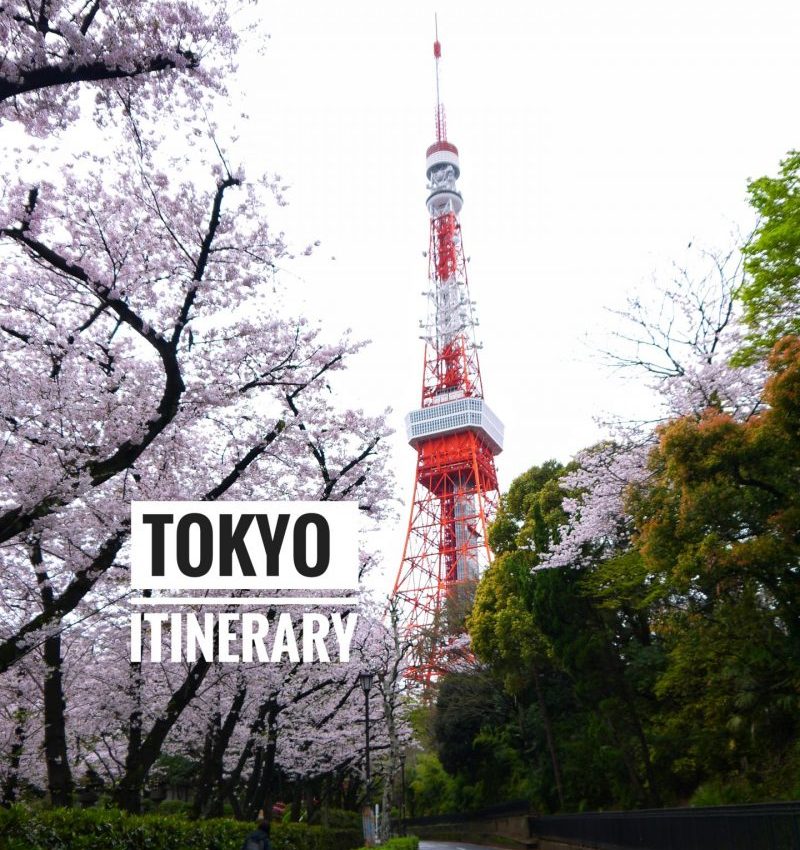
Tokyo Itinerary: Travel Guide Blog + Budget Planning
Last updated on June 13th, 2024
This Tokyo itinerary will show you how to spend 1, 2, 3, or 5 perfect days in Tokyo (including where to stay, what to eat, and how to explore all the interesting must-see attractions in Tokyo).
Tokyo, Japan’s capital, is the most populous metropolitan area and high-tech city in the world. As a massive love of Japanese culture, Tokyo has been one of the most wanted-to-visit cities on my budget list for many years. So you can imagine my delight when I finally had the chance! And ever since my first visit to Tokyo, I never ended my exploration of this amazing city and keep returning for its best sights and food.
For first-time visitors, deciding how to spend your days in Tokyo was a headache task. Planning a trip to Tokyo ain’t easy because there’s just SO MUCH to explore! But you don’t need to waste your precious Japan time finding the wrong itinerary. Based on my experience, I will help you make the most of your trip by giving my Tokyo ultimate guide about the best of Tokyo. Why waste your time as there is so much to discover? I’ve got all your first-time experiences with Tokyo covered.
My Tokyo travel blog will cover all the travel guides and tips to help you to plan your Tokyo itinerary. This itinerary is flexible and you can easily mix and match depending on how long you stay in Tokyo.
Table of Contents
Pre-Trip: Tokyo Travel Tips
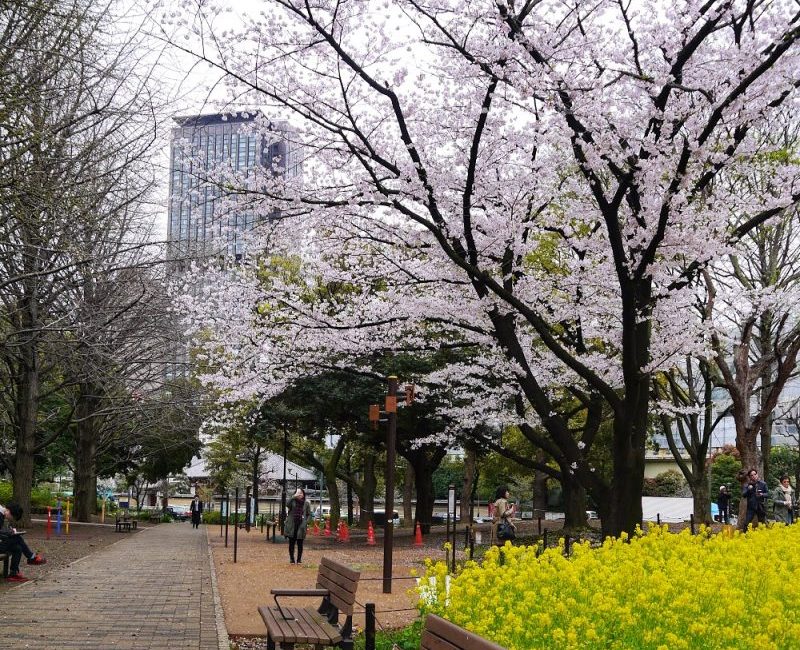
Best Time To Visit : Tokyo can be visited all year round and each season has its own beauty. The most popular time to visit Tokyo is during April (Sakura blossom season) and November (Fall foliage season). We visited Tokyo many times but can’t deny the best time to visit Tokyo is during the cherry blossom season when the whole of Japan is celebrating the sakura festival. It is always my best ever memory of visiting Japan.
Why visit Tokyo? For me, that would be so many reasons to visit Tokyo. It’s definitely true that visiting Tokyo is like stepping into the world of a new life and future trends. The combination of a lively neon-lit city, shopping paradise, Japanese rich culture, traditional historical sights, and mouthwatering Japanese food. GOSH! I probably will start looking for the next flight ticket to Tokyo.
Connected with the internet : It is very important for staying online to look for location, and navigation when traveling in Tokyo. Prepaid SIM Card is a great option for a solo traveler to Tokyo. But if you are traveling in a group, renting pocket wifi will be an ideal option where it is cheaper and can connect up to a few devices. Both SIM Card and Pocket Wifi can be reserved in advance and picked up once you arrive at the airport. Beware that you may run out of the pocket device or get at a higher price if you’re only looking for it at the last minute.
Getting To Tokyo
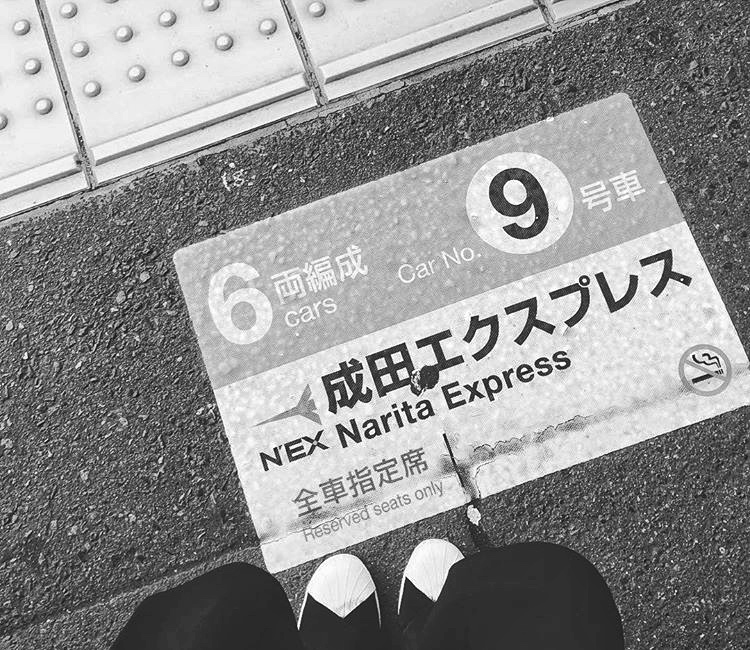
How To Get To Tokyo : Tokyo is easily accessed by thousand of Airline companies flying directly to this country. You also always monitor your flight ticket from Skyscanner and grab the cheapest flight ticket to Tokyo. Take note that Tokyo has two international airports; Haneda and Narita Airport.
- Haneda Airport : Closer to the city center compared with Narita Airport. Mostly served the domestic flight and low-cost carrier airlines. It takes about 30 minutes to the city center by the local train
- Narita Airport : Slightly away from town which required about 45-60 minutes of traveling time city center. The busiest airport and mostly international flights will be landed here.
Getting to Tokyo from Narita Airport is pretty easy and simple. Generally, there is a common three-way to get from the airport to Tokyo city,
- By Bus: Limousine Bus, Keisei Bus Tokyo Shuttle, and The Access Narita Bus. The cheapest and budget option.
- By Train : Kensei Skyliner vs Limited Express, Narita Express (N’EX) vs JR Rapid Service.
- By Private Transfer : Shuttle or taxi. An economical choice for family trips or large traveling parties with plenty of luggage.
Book via Klook with best price offer
We have documented how to get to Tokyo city from Narita Airport. Read more here: From Narita Airport To Tokyo: How To Decide Your Best Transport .

Getting Around in Tokyo
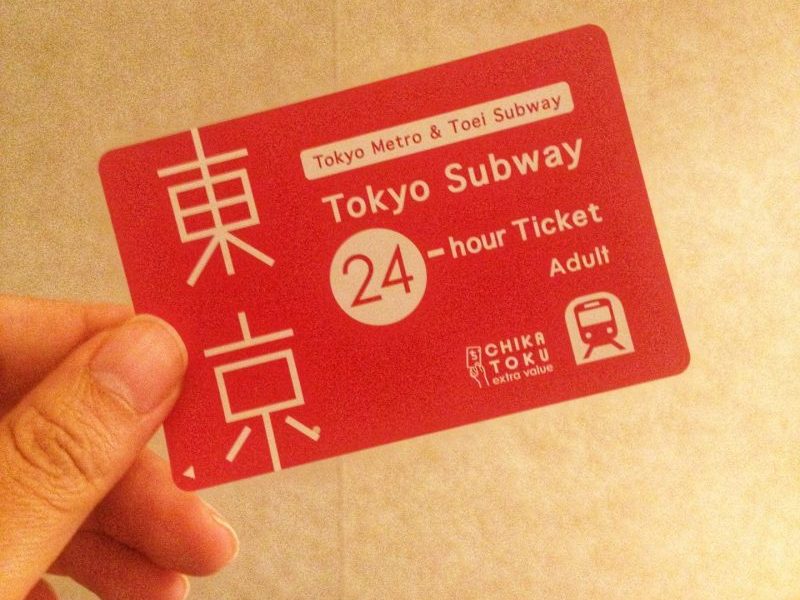
Tokyo has the best and most effective public transportation system in the world, making it very easy to get around in the city by train.
Get the Tokyo Subway Ticket (24, 48, or 72 Hours) for unlimited access on both the Tokyo Metro and Toei Subway lines within the validity period. It will be very useful when you are hopping around Tokyo city center without worrying about getting lost or going down the wrong subway station.
Buy Tokyo Subway Ticket (24, 48, or 72 Hours)
A great combination that traveling in Tokyo by using SUICA when taking a JR train line. This transport card allows you just tap in without buying a ticket whenever you go in and out of the station. It is accepted at any train and metro station, convenience stores, and even vending machines. Just reload the money and you are ready to go. SUICA can be used for up to 10 years and any other region in Japan.
Reserve You SUICA HERE
Tokyo Travel Tips : In my humble opinion, the Tokyo Subway Ticket is very useful for first-time visitors than the other IC cards because we tend to get lost in a new city. This card granted you unlimited use of the Tokyo Subway for 72 hours, so it doesn’t matter how many times you ended up exiting the wrong station!
Be ready for a transit app when getting around Tokyo. There are many useful Apps such as NAVITime, Hyperdia, YahooTransit, and Google Maps that provide train schedules and routes. I personally love using YahooTransit and Hyperdia as there are simple and easy to interact with.
If you are planning to travel around Japan, consider getting the JR Pass which is only available for foreigners. It provides unlimited use of the Japan Railway (JR) either in 7, 14, or 21 days to visit all over Japan. You can purchase the Japan Rail Pass , the official JR Pass vendor, and redeem it when landed in Tokyo.
Tokyo Travel Tips : Only activate JR Pass for long-distance train travel around Japan. JR pass might not be worth it if you are only visiting Tokyo city.
How Many Days Need in Tokyo
If you ask me how many days in Tokyo is enough for a first-time visitor? At least three days! We recommended at least allocated 3 days in Tokyo to cover most of the popular attractions in the city. There are so many new things and unique sides awaiting you to discover. If possible, try to squeeze in more days if you prefer for a laidback holiday at a slower pace.
Besides, you may also include one day or two days for side trips to explore the outskirts of Tokyo such as Hakone, Kawakuchiko, and Mt Fuji which make it a total of 5 days of Tokyo itinerary .
If time is limited and only just one day or two days in Tokyo , we suggest that you focus your time on what you want to do and see. Tokyo is a massive city and it is much bigger than what you might have expected. Start your Tokyo itinerary early in the morning and you can get through some of the attractions that you like the most.
Where To Stay in Tokyo
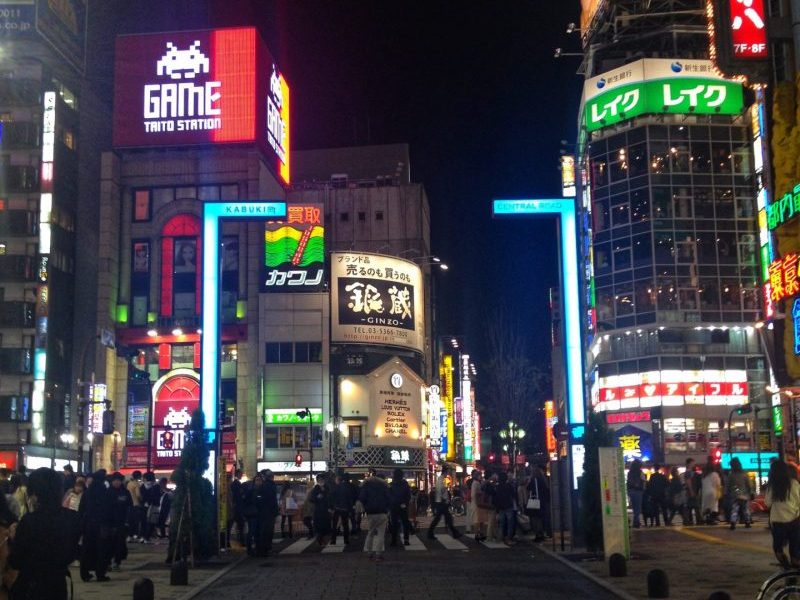
Deciding where to stay in Tokyo can be a headache task. But no worry as we also included some of the recommended places and hotels to stay in Tokyo. We recommended staying somewhere well-connected with the train and metro station. It will greatly help us get around Tokyo.
We love staying in Shinjuku as it is the transportation hub and the most lively neighbor to stay in Tokyo. Our best pick is Hotel Sunroute Plaza Shinjuku if you are looking for the best stay in Shinjuku. Everything is easily accessible and most importantly with a reasonable price tag.
Another great option is Ueno and Asakusa, a budget-friendly neighborhoods to stay in Tokyo. We stayed in the Hotel Sardonyx Ueno during one of our trips to Tokyo. It is cheaper, provides excellent service, and has a strategic location that is closes to Ueno station. There are plenty of excellent and cheap restaurants nearby where you can try on Japanese food.
For more information and the best pick on Tokyo Hotel, click here to read our ultimate guide on Where To Stay in Tokyo . Take note that rooms running fast for those good and cheap hotels in Tokyo. Make sure to book it in advance before it sold out!
Planning on Tokyo Itinerary
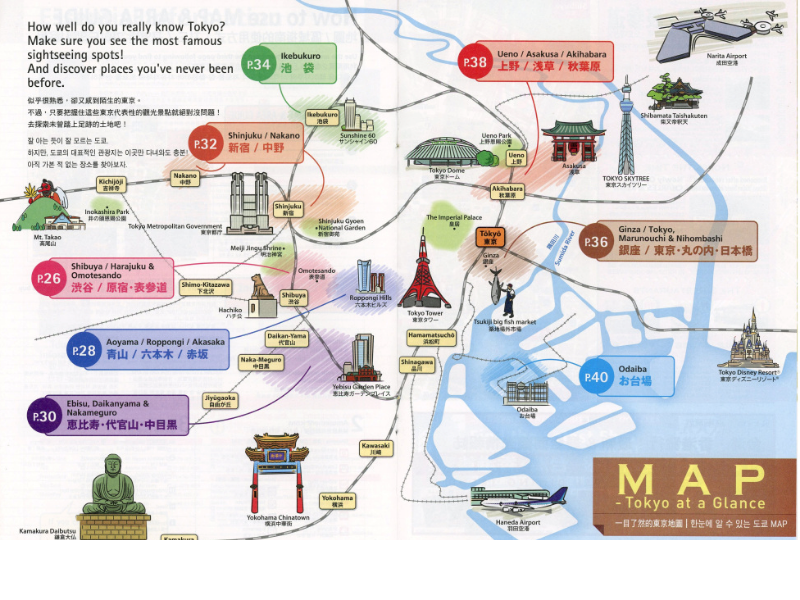
Tokyo is a massive city and the most populous metropolitan area in the world. Properly planning your time in Tokyo will take away a lot of stress and help you feel like a regular visitor.
There are so many things to do and see in Tokyo. While many visitors try to cram a ton of attractions into 24 hours or 48 hours. But it is best to stay in Tokyo for 4 to 5 full days to fully explore this amazing city. The extra time will help you see everything at a more laid-back pace for a wonderful trip without rushing too much.
Below are suggested itineraries for Tokyo that we’ve come up with after a few trips to Tokyo. This Tokyo itinerary is basically grouped by areas so that you don’t waste time traveling around. We hope our tips help you better divide your time in Tokyo so you can make the most of your visit.
Tokyo itinerary with best attractions covered :
- Day 1: Harajuku, Shibuya, and Roppongi
- Day 2: Ueno, Asakusa, Akihabara
- Day 3: Tsujiki Market/Toyosu Market, Tokyo Tower, and Odaiba
- Day 4 – 5: Day Tour outside Tokyo (Hakone or Kawaguchiko)
Are you ready to blow away by this modern city? Let’s start our Tokyo itinerary day-by-day below.
Day 1: Harajuku, Shibuya and Roppongi
For the first-time visitor, we recommended exploring central Tokyo to Harajuku, Shibuya, and Shinjuku or Roppongi. These areas are the best place to experience the true vibe of Tokyo.
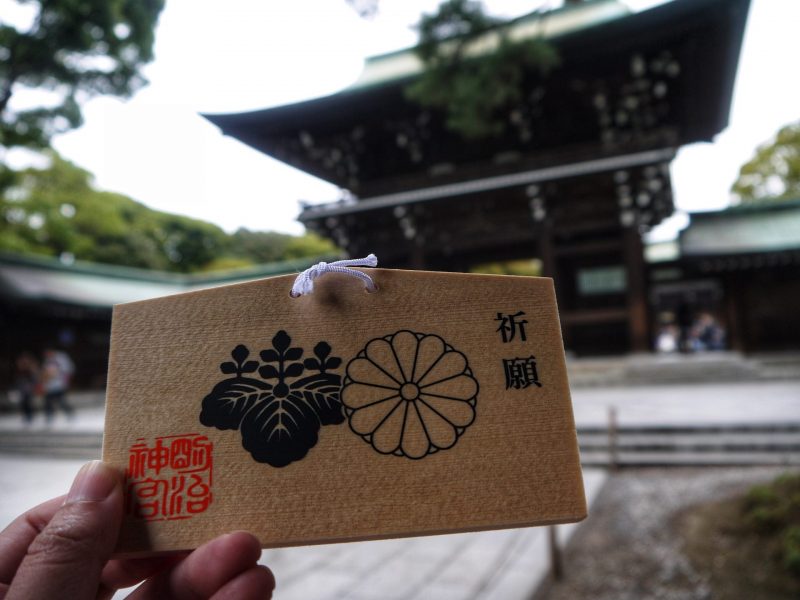
Start your day by visiting the Meiji Jingu Shrine to enjoy the serene tranquil environment in this largest shrine in Tokyo. The best time to visit Meiji Jingu Shrine is the early morning when you can spend some time in Yoyogi park with fresh air.
Have a relaxing stroll in Yoyogi Park and pass through the serene Torii gate before reaching Meiji Jingu Shrine. Pray for better health, good fortune, and success in studies in the main temple. You may see a traditional Shinto wedding held in Meiji Shrine if you are lucky!
- Getting there : Meiji-jingumae “Harajuku” Station (C03, F15), take exit #2. The south entrance is a 1-minute walk away from the station.
- Entrance Fee : Free!
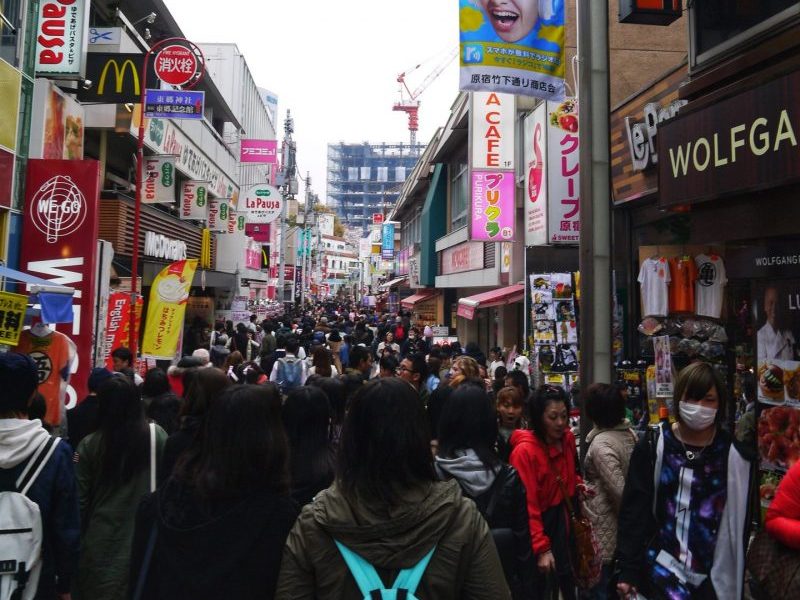
Next, walk to Takeshita street in Harajuku, the most visited place by young shoppers and teenagers. This pop and culture valley is just in front of JR Train station. Don’t forget to try some of the Harajuku must-eat local specialties such as crepes, Calbee, and some of the Japanese snacks in Takeshita street.
- Getting there : Meiji-jingumae “Harajuku” Station (C03, F15), take exit #5.
Walk down along Takeshita-Dori street, you’ll reach Omotesando street at the end of your walk for some high-end shopping. You can find all sorts of international brands such as LV, Dior, and Prada along Omotesando street. Alternatively, you can also go to Cat Street which is an ultra-modern street catering to younger generations.
Read More : A Guide For Meiji Shrine, Harajuku, Shibuya Itinerary
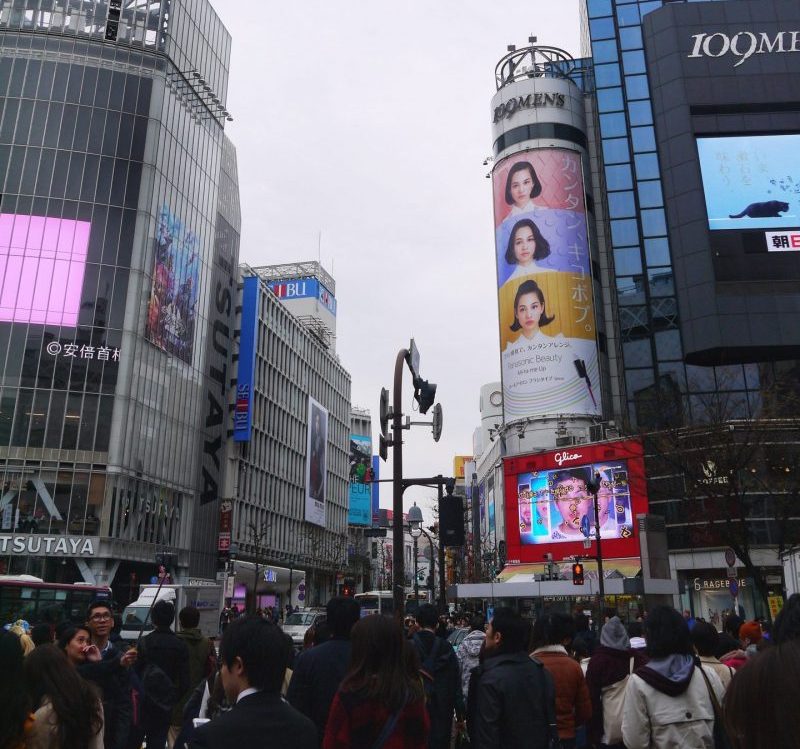
Continue your exploration of Shibuya and wander around. Check out the Hachiko Statue Outside Shibuya Station, the world’s busiest intersection in the world, “Shibuya Scramble Crossing” and do some shopping at Shibuya Gai.
When we only have a tight schedule for day one in Tokyo, we love to enjoy our meal somewhere most convenient for us. There are many best restaurants that provide a good variety of food in Shibuya. But we choose to have our break in the best spot to view the Shibuya crossing.
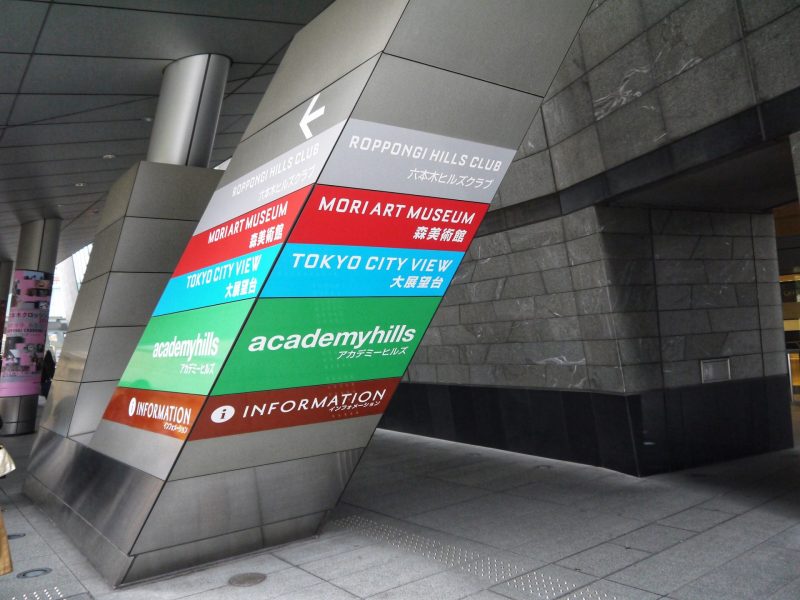
Finishing your Day 1 Tokyo itinerary by enjoying the night view of Tokyo city. There are a few places open to for an aerial view of the amazing city from above such as Tokyo Tower, Tokyo Skytree, Shinjuku government metropolitan building, and Roppongi Hills Observation Deck.
Among all, Shinjuku Government Metropolitan Building is a great option for the Tokyo night view for FREE! However, we opted for the Roppongi which gives us a better view of Tokyo city with Tokyo Tower. It is only a few metro stops away from Shibuya but make sure to give yourself enough time to get there.
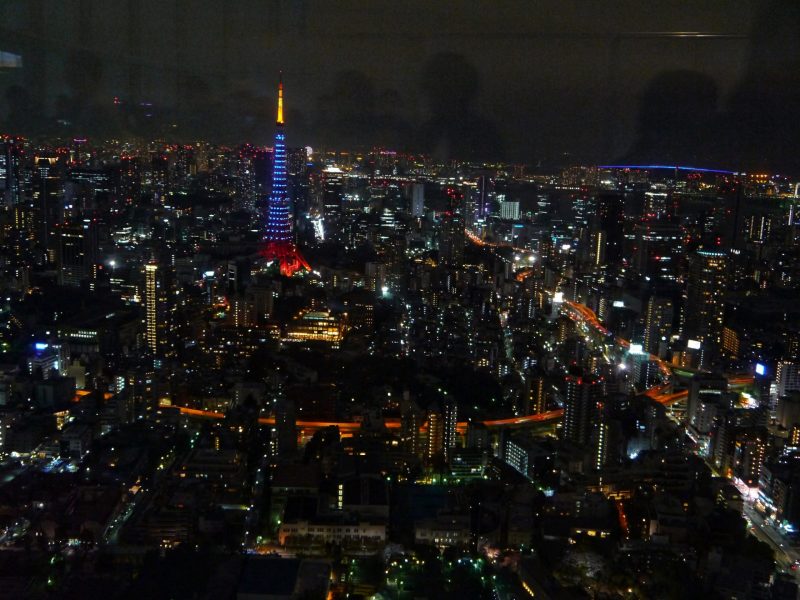
From Shibuya, we took a short metro ride to Roppongi to check out the best Tokyo city view at the Roppongi Hills Tokyo City View Observatory. The Roppongi Hills Observation Deck is located in the Mori Tower which provides a great choice for late evening sightseeing.
The panoramic Tokyo City can be viewed at its 52nd-floor indoor observation deck and the outdoor 270 meters high Sky Deck. A ticket is required to access this one of the tallest buildings in Tokyo and you can get fast access ticket from Klook at a cheaper price.
Click here for Roppongi Hills Observatory Tickets from Klook
At the end of the day, I got the metro back to my hostel in Ueno. This was a chilled location and fairly cheap as it’s slightly outside of the main tourist areas. The hostels in Japan are exceptionally clean and often with private, capsule-style beds. Of course, there are many Tokyo hotel options for couples as well.
Tokyo itinerary on Day 1 : Visit Meiji Jingu Shrine, Takeshita street in Harajuku, and spend time in Shibuya. Have the best night view in Tokyo at Roppongi.
Day 2: Asakusa, Ueno, Akihabara
On the first day, we suggest seeing the attractions in a central town. If you want to want to take extra time shopping and sightseeing, feel free to move extra time to Shibuya on day 2. While at the second time, we recommended exploring Northern Tokyo for its traditional and cultural attractions.
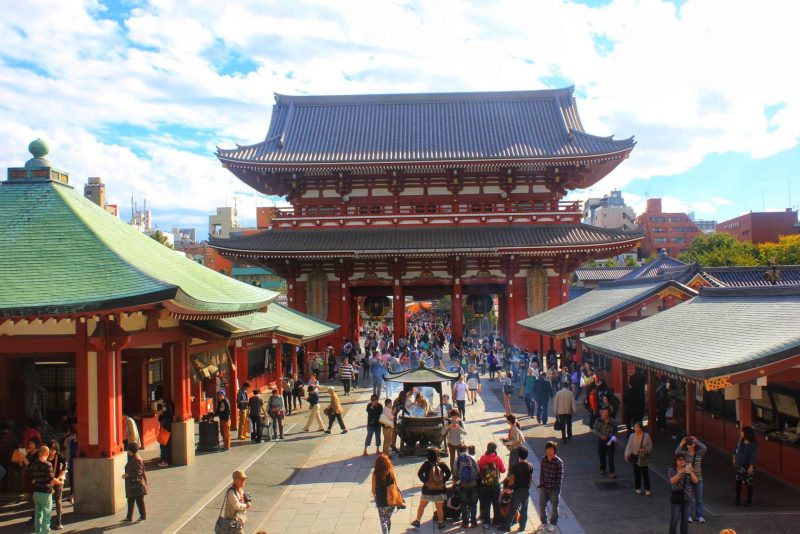
An excellent place to start your Day 2 in Tokyo itinerary is heading to Asakusa, Ueno, and Akihabara. All these places are located on the Northside of Tokyo and are best coupled together in your Tokyo itinerary.
Firstly, heading to Asakusa to see Tokyo’s oldest Buddhist temple, Sensoji temple. It is one of the most iconic buildings and heritage of Tokyo.
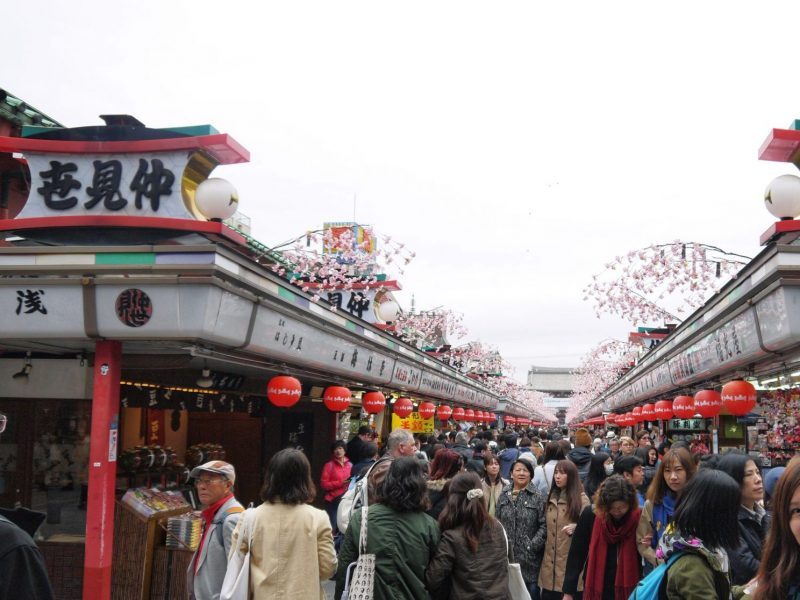
A visit to the Sensoji temple can feel the nostalgic atmosphere of the Edo period in Tokyo. The Kaminarimon, Nakamise Dori, and Sensoji Temple can easily spend your time in the morning. You can shop for traditional Japanese craft souvenirs in Nakamise Dori, try the Asakusa local snacks and explore the Sensoji temple.
- Getting there : From Asakusa station (G19), take exit 1 and then walk 5 minutes.
- Admission: Free
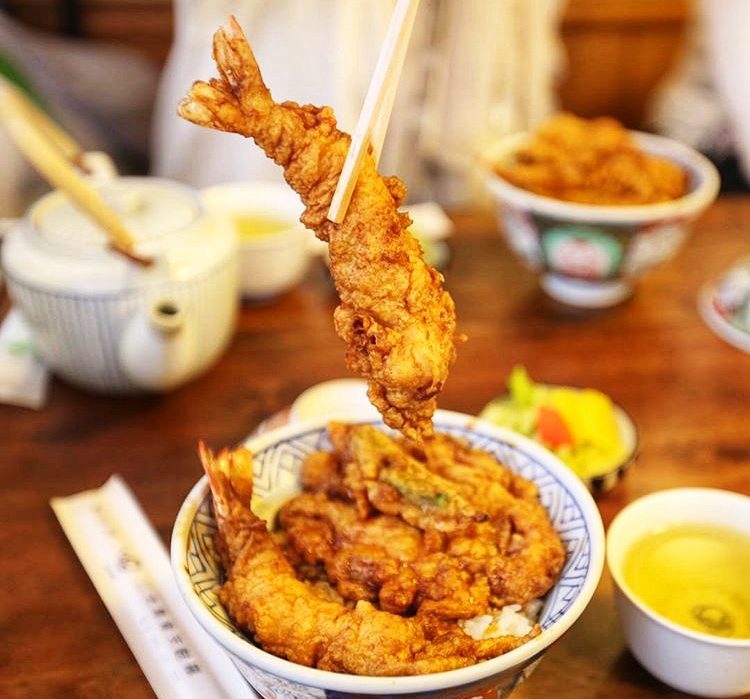
In the afternoon you’ll want to have your lunch and we recommended to try the Asakusa must-eat food, Tendon rice. We tasted the mouthwatering Tempura and Tendon dishes in Daikokuta Tempura and highly recommended them. The tempura served in Daikokuya is using soft batter and is flavored with a generous amount of sesame-based sauce. So, it is soggy compared with the traditional crispy tempura.
Asakusa Food Blog : Daikokuya Tempura: Asakusa Must Eat Food
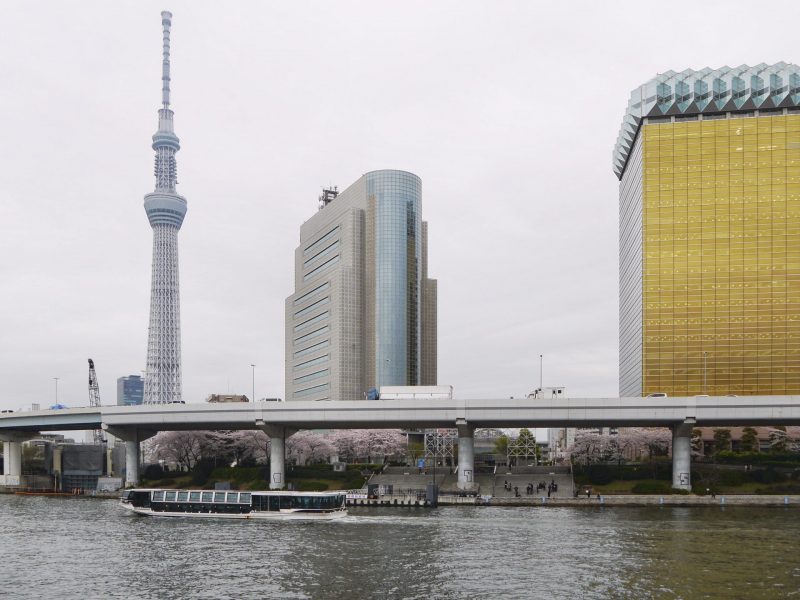
Next, take a short stroll to Sumida Park and see more on the Northern side of town. Sumida Park is a beautiful park lined with thousands of cherry trees along the Sumida River. Locals come here for a picnic, exercise, and jogging during normal times. But it is one of the popular spots for hanami viewing during the sakura season.
Get Discounted Tokyo Skytree Ticket
From Sumida Park, you can walk to Tokyo Skyree, another great place for the best aerial view of Tokyo. If you choose to get to Tokyo Skytree, you will get an excellent city view overlooking Tokyo.
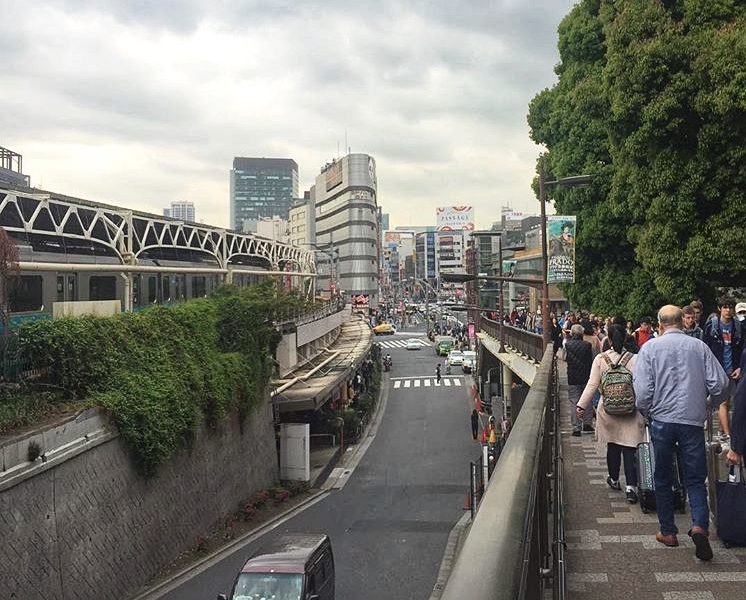
Next, take a short metro ride to Ueno Station and visit the Ueno park and Ameyoko street in Ueno. Whichever afternoon activity you choose, we recommend spending at least two to three hours in Ueno.
Getting there : Take the train to Ueno Station (G16, H17). For Ameyoko, take exit 5B and walk for about 1 min.
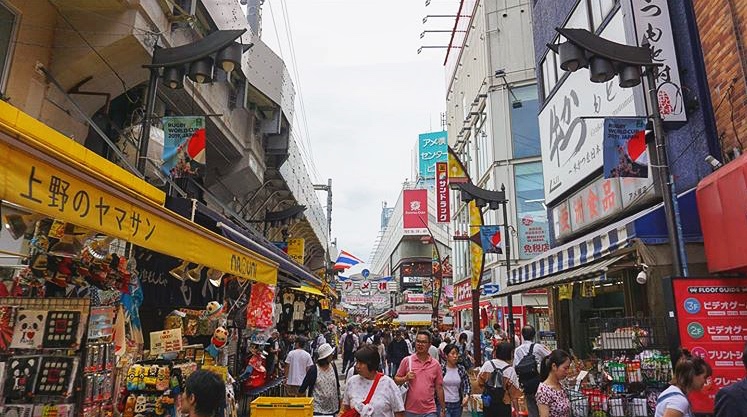
Ueno Park is a large public park in Tokyo and it has temples, shrines, museums, and even Tokyo’s oldest zoo inside the park. The park established in 1873 is very popular among locals. You can spend time wandering around the park or visiting the attractions inside the park.
While the Ameyoko street is a well-known shopping street with lots of cheaper stuff and food. Many locals and visitors love to come here to shopping. It is also the best place to get your souvenirs in Tokyo. Endless instagrammable Neon signs on this discount shopping street!
If you have more time, you can visit the legendary electric city Akihabara, a place that is famed for its electronic retailers, anime, cosplay, and video games. But we choose to spend more time in Ueno and have an amazing dinner before ending our day 2 Tokyo itinerary.
What else would you add to your Tokyo itinerary?
Tokyo itinerary on Day 2 : Spend time in Asakusa including Sensoji temple, Nakamise Dori, and taste the Asakusa must eat food, tendon rice. Afternoon head to Ueno and visit Ueno Park and Ameyoko. Have a wonderful Japanese cuisine dinner.
Day 3: Tsukiji Market/Toyosu Market, Tokyo Tower, Odaiba
If you love Japanese food, especially sushi, visiting the Tsujiki Fish Market in Tokyo is a MUST! It has the best sushi in Tokyo, freshly caught, and direct delivered from the fisherman. The Tsujiki Wholesale Market consists of an inner market that is known for its Tuna auction and fresh seafood market, and also an outer market with restaurants and shops lined along the narrow lane.
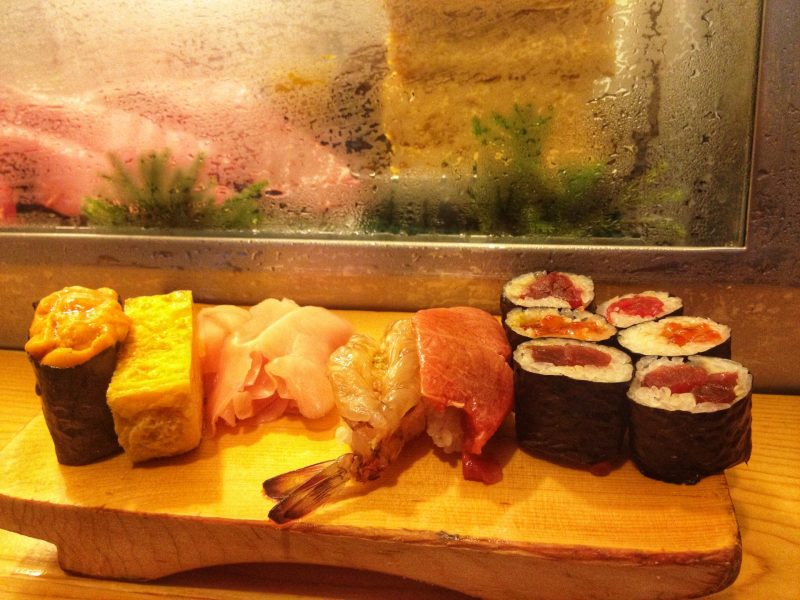
The two most popular sushi restaurants are Sushi Dai and Daiwa Sushi. Whenever we visited Tokyo, we sure will allocate time and return to the Tsukuji market for its sushi breakfast. However, take note that the inner market has moved to Toyosu Market in October 2018, which means most of the restaurants also move to Toyosu Market.
We love the omakase set from Daiwa Sushi. The chef will serve you whatever sushi they can make with the day’s ingredients. It was so fresh and delicious that it melted in my mouth.
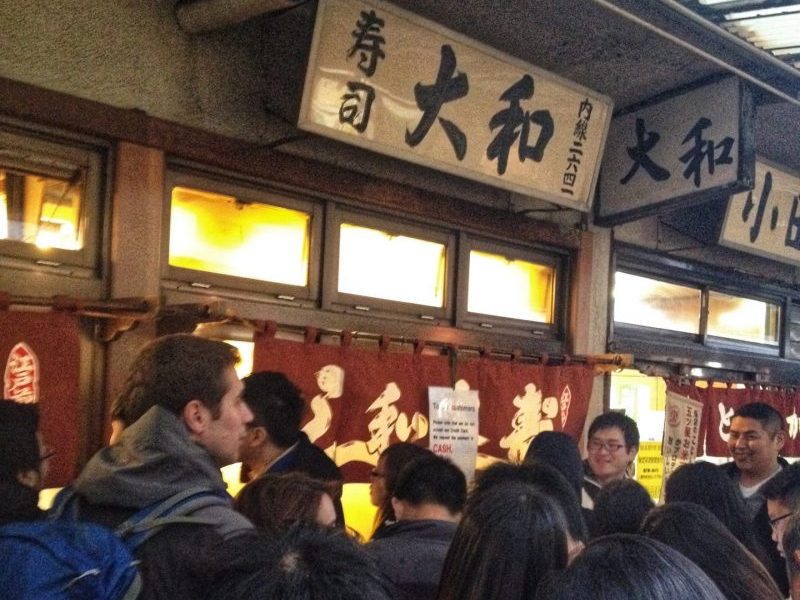
Take note that you’ll have to come early at the crack of dawn as the waiting lines are crazy for those popular restaurants. If you don’t make it to the queue then pick a random stall with the shortest queue. It is also another good option.
Tsukiji Market/Toyosu Market
- Admission fee: Free!
- Operating Hours: From 5 am to 5 pm. Closed on Sundays and public holidays.
- Note: Subway train starts operating a 5:20 am.
How To Get To Tsukiji Market : A short walk from either Tsukiji Shijo Station (Oedo Subway Line) or Tsukiji Station (Hibiya Subway Line).
How To Get To Toyosu Market : The nearest subway station is Toyosu Station (Tokyo Metro Yurakucho Line).
Tokyo Tower
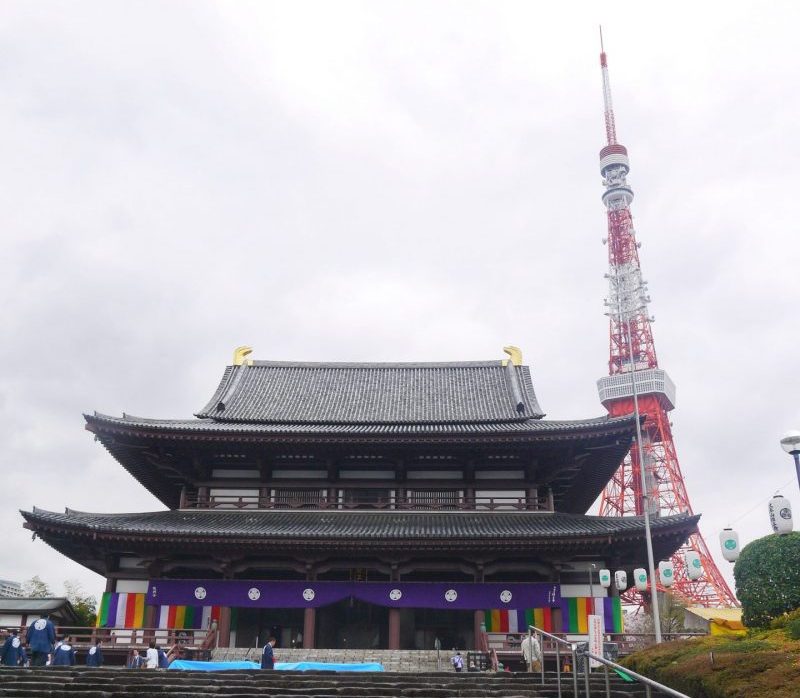
After your sushi breakfast, start your Tokyo adventure in other modern and energetic areas of Tokyo. Have a short walk to Ginza, the Tokyo version of New York`s Fifth Avenue for high-end shopping.
Alternatively, take a short metro ride to the Zojoji Temple, the head Buddhism temple in the Kanto region . You can also couple your Tokyo Tower visit with Zojoji Temple as both situated within walking distance. The Zojoji Temple is one of the best places to view the Tokyo Tower during the cherry blossom season.
From Zojoji Temple, we enjoyed a relaxing stroll to Tokyo Tower, the signature tower of Tokyo.
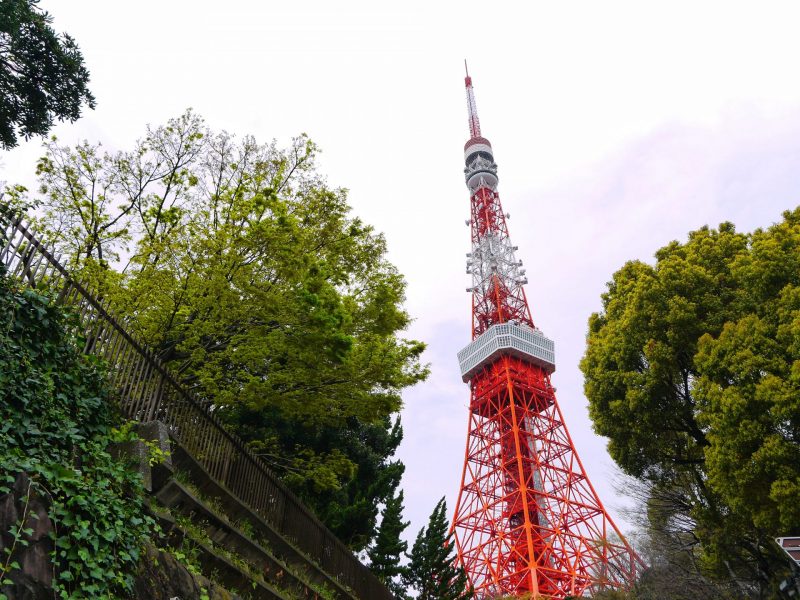
Build in 1958, Tokyo Tower was once the tallest building in Japan inspired by Eiffel Tower in Paris. It is now the second tallest building after the completion of the Tokyo Skytree. You can choose to visit the observatory deck of Tokyo Tower to enjoy the magnificent city view.
Get Discounted Tokyo Tower Ticket Here
Tokyo Travel Tip : Get your Tokyo Tower Admission Ticket from Klook. It is super easy to redeem and use and you can save a lot of queueing time.
Tokyo Tower ( Book Here )
- Admission Fee to the observation decks: ¥900 yen (Main Deck), ¥2800 (Main and Top Decks).
- Operating Hours: Main Deck (150m) 9:00-23:00 (Last admission 22:30), Top Deck Tour (150m and 250m) 9:00-22:45 (Last Tour 22:00-22:15)
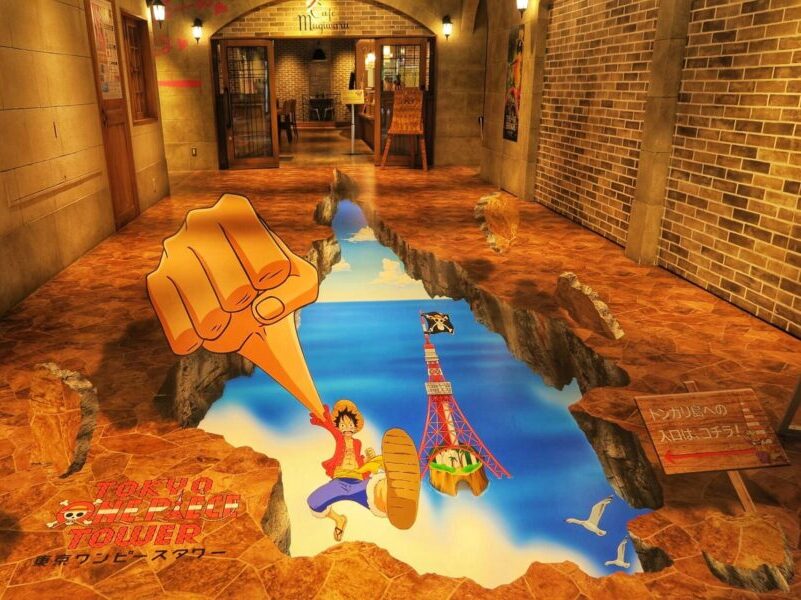
We chose to spend the afternoon time in Tokyo One Piece Tower. It is an exciting indoor amusement park inside the Tokyo Tower that features the most popular manga series in the world, ONE PIECE.
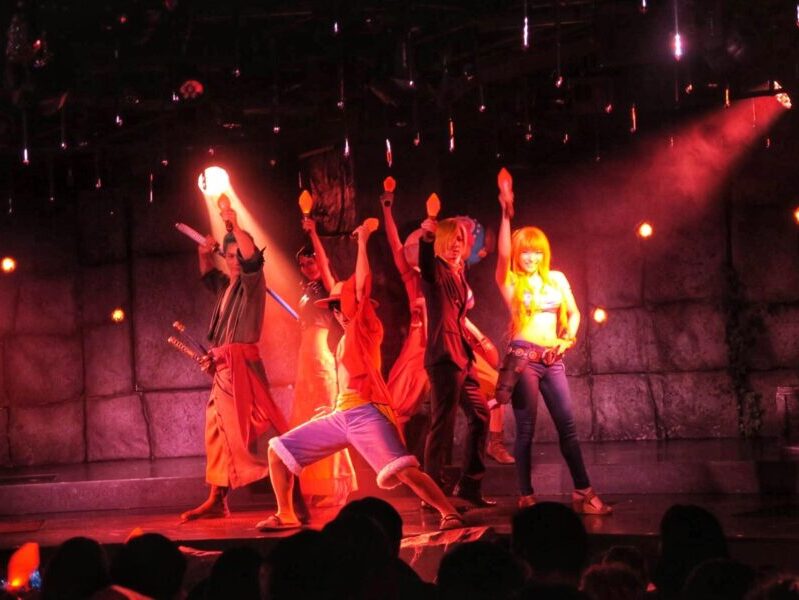
The attractions inside the Tokyo One Piece Tower include Nami’s Casino and Luffy’s Endless Adventures. Usopp’s Ball Shooting Game, Brook’s Horror House, Soul Edge of Zoro, and the live stage show. There are also games and interactive exhibitions to experience. A must-see for fans of One Piece!
How To Get To Tokyo Tower : Get to Onarimon Station (Toei Mita Line), Akabanebashi (Toei Oedo Line) by train.
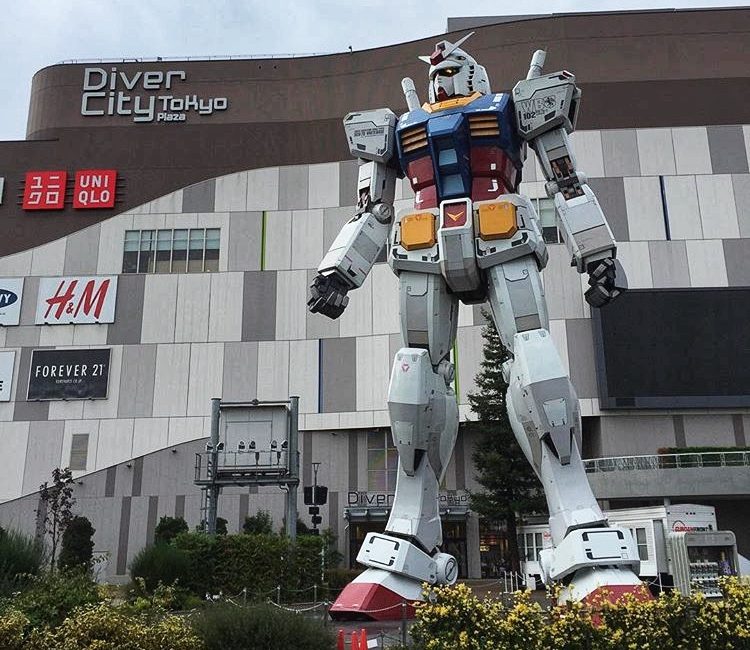
In the late afternoon, we took the train to Odaiba, a man-made island in Tokyo Bay. Original create to protect the city from marine attracts, and now become a great place for couples, families, kids, and also tourists.
There are various seaside activities and some the unique tourist activities to do in Odaiba:
- Relaxing stroll in promenades and enjoy the iconic view of the Rainbow Bridge, Odaiba Statue of Liberty. The view is particularly beautiful during nighttime.
- Shopping in the entertainment complex including DiverCity Tokyo Plaza and AquaCity. Take an iconic photo shot with Gundam.
- Odaiba Oedo Onsen Monogatari : A large onsen spa complex near Tokyo Bay featured both indoor and outdoor hot springs, a food court, and a fun arcade. Spend your time in Japan’s Edo period recreation and relaxing by soaking in an onsen bath. [Permanent Closed]
- TeamLab Planets : Digital museum that combined art and technology is one of Tokyo’s newer popular attractions. It offers immersive viewing and an Instagrammable art experience for visitors. Extremely popular and make sure to purchase your ticket early!
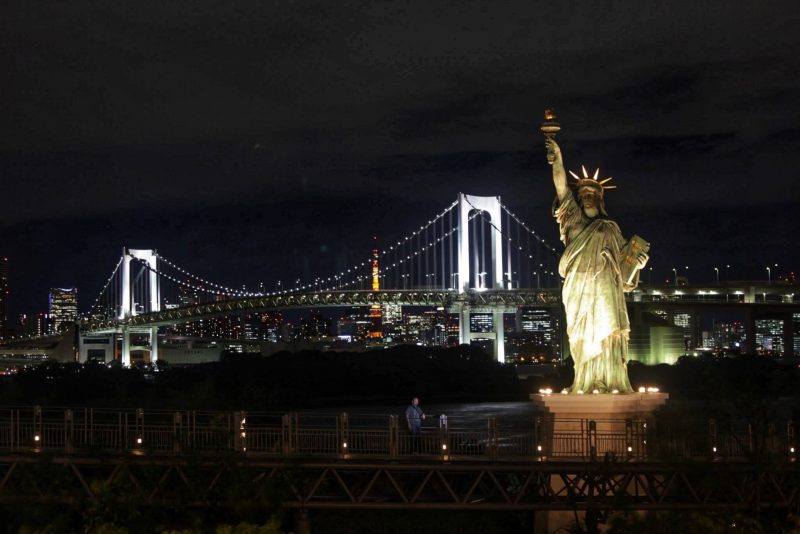
How To Get to Odaiba : The main transportation hub is Odaiba-Kaihinkoen Station. From Shinjuku Station to Shiodome Station (Toei Oedo Line) or from Tokyo Station to Shimbashi Station (JR Yamanote Line).
Day 4 and Day 5: Day Tour Outside Tokyo
For the first three days, you will be spending most of your time covering the attractions in the city area. On day 4 and day 5, you can then dive into the day trip options for one day to two days for this suggested itinerary for Tokyo.
There are a few day tours outside Tokyo that can be considered such as Hakone, Kawaguchi-ko, Kamakura and Enoshima. Here is some recommendation for you to consider on your Tokyo itinerary.
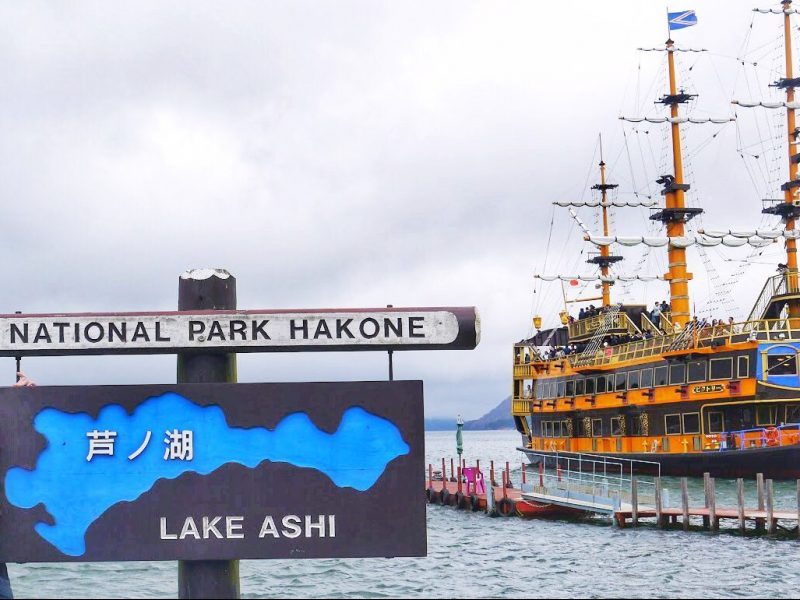
Day tours outside Tokyo, Hakone : Experience some of Tokyo’s beautiful nature and onsen paradise. Hakone is easily connected directly from Shinkuju station by train. Purchase a Hakone Free Pass as it saves you a lot of money by freely accessing all the seven modes of transportation in Hakone.
Reserve Hakone Free Pass and redeem it at Odakyu Sightseeing Service Center
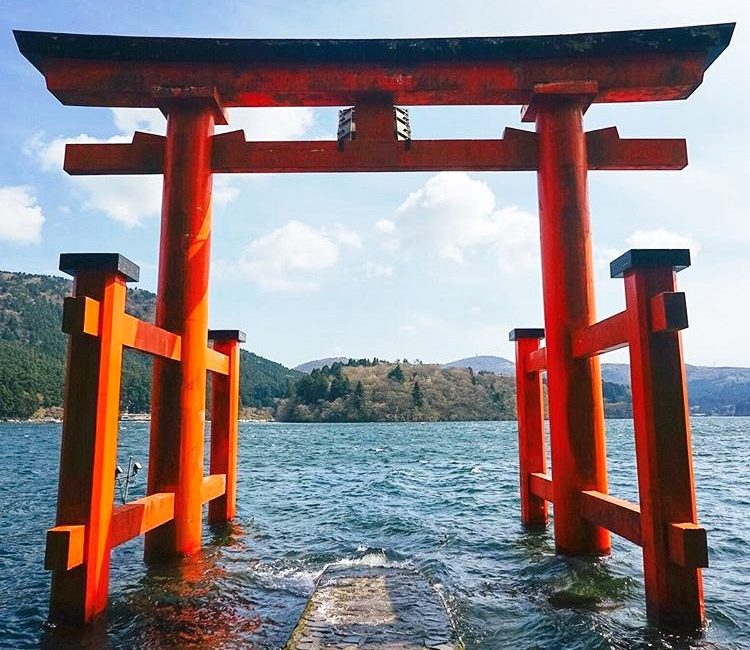
Spend your day time wandering around Hakone and its beautiful surrounding. Admire Mount Fuji, take the ropeway way to view the Owakudani Hell Valley (大涌谷) , or enjoy the boat cruise at Ashino-ko lake .
Don’t miss visiting Hakone’s biggest tourist attraction – the bright red floating Torii gate out in the sea.
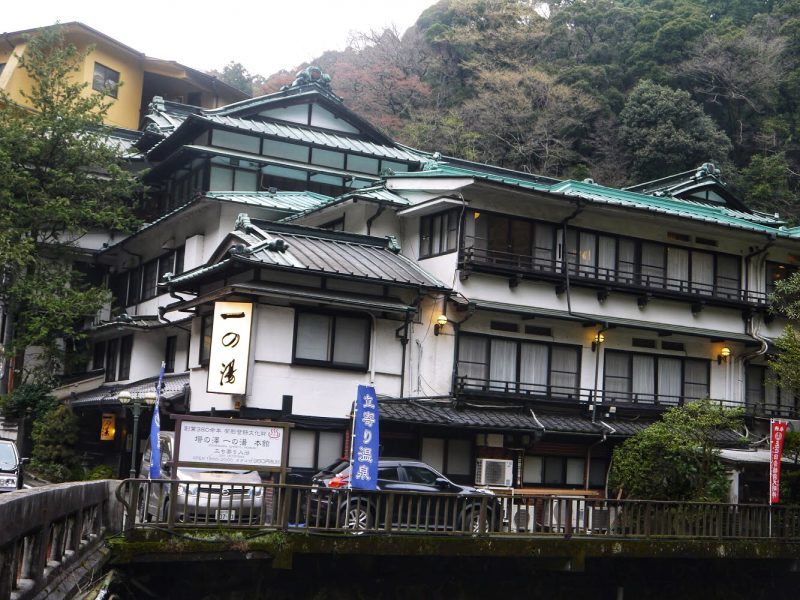
In the late evening, check in and stay one night in the traditional Japanese Ryokan. Hakone is very well-known for its hot spring baths (Onsen). Soaking in the natural hot spring bath, indulge in the kaiseki Japanese cuisine while enjoying the natural beauty of this national park.
More detail on planning your trip to Hakone :
- Hakone One Day itinerary with Hakone Free Pass
- Best Ryokan Stay in Hakone: Ichinoyu Honkan
Kawaguchi-ko
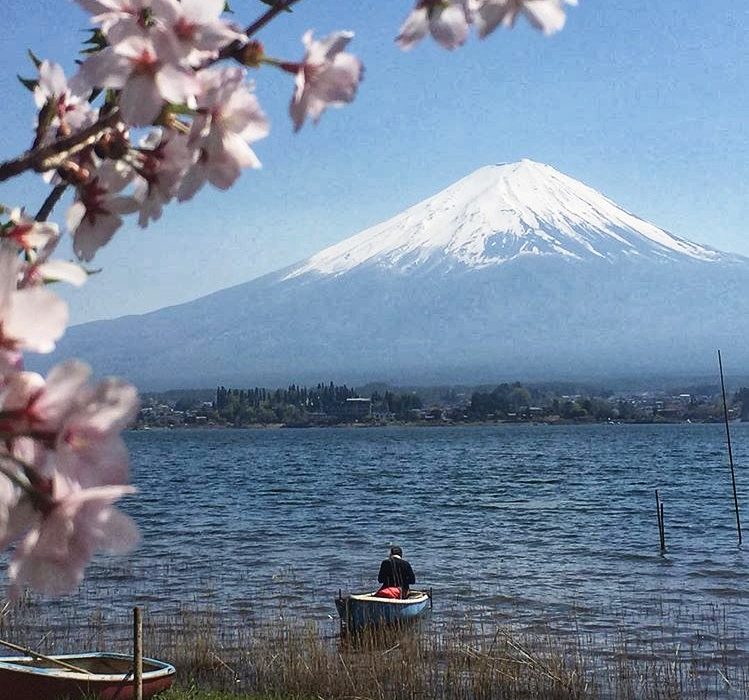
Day tours outside Tokyo, Kawaguchiko : The northern base of Mt Fuji mountain that famous with Fuji Five Lakes (Kawaguchiko, Saiko, Yamanakako, Shojiko, and Motosuko). Among all, Kawaguchiko is the most accessible and offers the most things to do.
Kawaguchiko is extremely popular for the Shibazakura festival in May. The breathtaking pink moss is blooming against the backdrop of Mt Fuji.
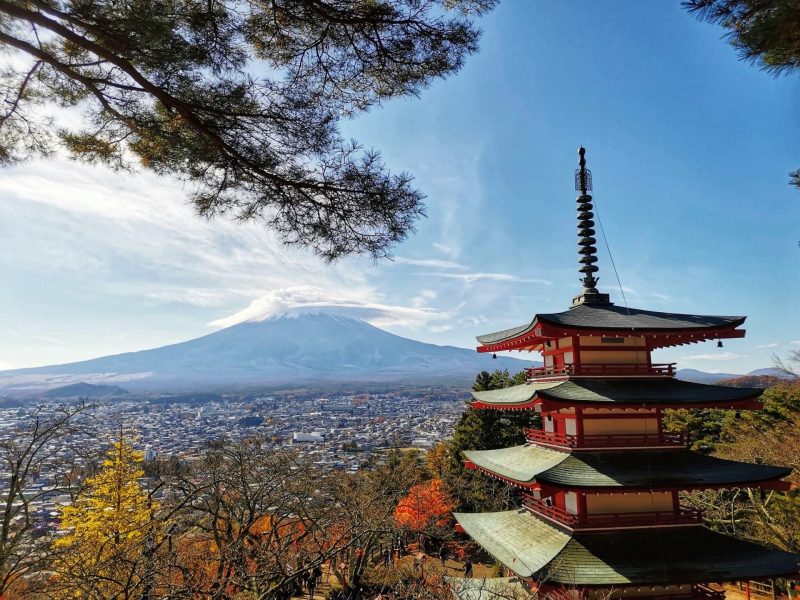
The Red Chureito Pagoda with Mount Fuji in the background is one of the popular attractions in the Fuji Five Lakes area.
Alternatively, take a close-up look at Mt Fuji and climb up Mt Fuji which opens from July to September each year. During this time, thousands of hikers from around the world will conquer this active volcano mountain.
Keep in mind that, all the attractions are popular among locals and travelers. Please plan your itinerary, where to stay, and transportation.
Day 4 and day 5 on Tokyo itinerary : Trip to Hakone (Option A) or Kawaguchiko (Option B). Spend nighttime in a traditional ryokan with a natural hot spring bath.
Kamakura and Enoshima
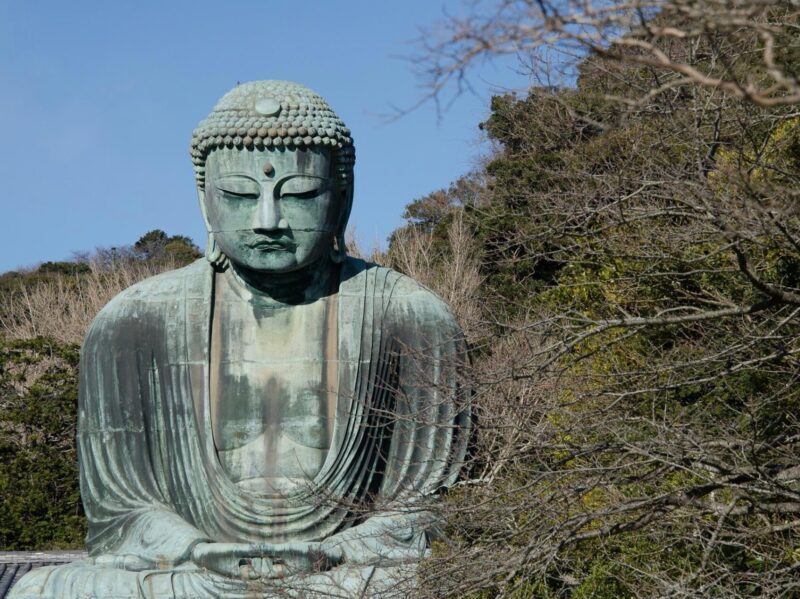
Located in the Kanagawa Prefecture, Kamakura (鎌倉) is a popular destination for a day trip from Tokyo. This place is often referred to as the “Kyoto of Eastern Japan.” The city is home to iconic Buddhist temples such as the Kotokuin with its Great Buddha statue, as well as Shinto shrines like Tsurugaoka Hachimangu.
You can also spend some time to visit the nearby Enoshima, a small island nearby Kamakura.
Follow our Kamakura day trip itinerary, which will help you cover the important attractions and enjoy the town’s beauty. Read More: Kamakura Itinerary: A Travel Guide Blog .
Have Some Extra Time in Tokyo?
If you’re even up for more fun with extra time to spend in Tokyo, be sure to check out our suggestion below. There are tons of places to enjoy Tokyo activities and can be freely included in your Tokyo itinerary. But you need to do a little research and plan to have the most enjoyable time possible.
Popular things to do to add to your Tokyo itinerary:
teamLab Borderless and teamLab Planets
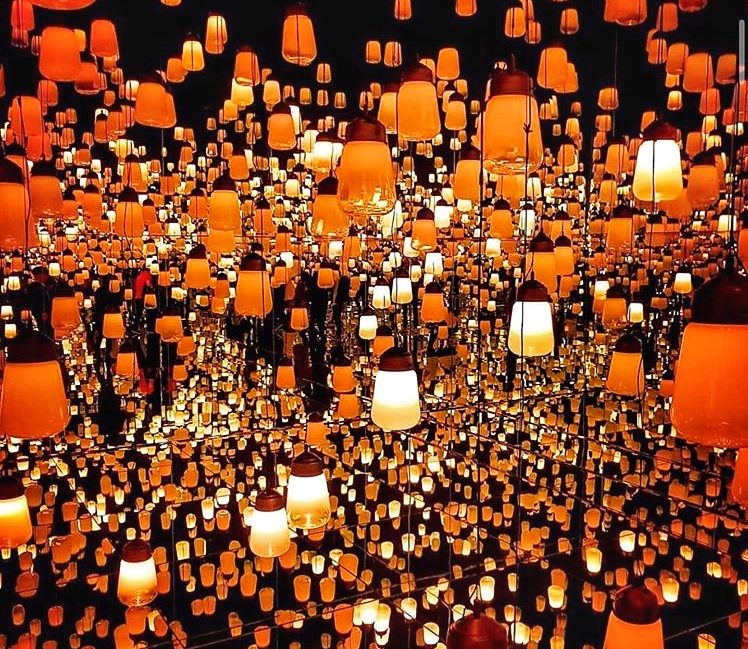
The amazing TeamLab Borderless and TeamLab Planets are gaining popularity in recent years. These two digital art museum is at the forefront of artistic expression and digital interactive art that tickle your senses. Although you might see a lot of photos before visiting, the actual experience brings a different kind of feeling to the senses. An absolute must for any contemporary art lover.
However, we suggest trying to avoid the weekend as there are so many people to enjoy the visual sensation. You may need to line up just to want to get in! To save time, we recommended purchasing your ticket in advance via Klook. You can just scan in the QR code and you’re ready to explore the amazing artistic world with light and music.
Expected duration : Three to four hours.
TeamLab Planets ( Get the Skipped the Line Ticket from Klook)
- Admission fee: ¥3,200
- Nearest Subway Station: Toyosu (Tokyo Metro Yurakucho Line)
- Nearest Subway Station: Aomi (Yurikamome Line), Tokyo Teleport (Rinkai Line)
Tokyo Disneyland and Disney Sea
Disneyland lover please don’t miss this! The Tokyo Disneyland resort comprises Tokyo Disneyland and Tokyo DisneySea is Japan’s most magical and nostalgia-inducing locations. Explore both parks, watch the shows and parades, and join Mickey Mouse and all the other prominent Disney characters.
Tokyo Disneyland is notoriously crowded all year round . Consider pre-booking to save time on queueing purchase ticket on-site. You can buy the Tokyo Disneyland ticket at a cheaper price from Klook. Just the QR code for easy access so you won’t have to queue to get tickets later.
Tokyo Disney Resort Passport (E-Ticket)
Expected duration : Whole Day!
How To Get To Disneyland Tokyo : The nearest station is JR Maihama Station (Keiyo Line).
Tokyo Travel Tips : If you only have limited time and only can choose between Tokyo Disneyland or Tokyo DisneySea, visit the Tokyo Disney Sea! In my opinion, DisneySEA in Tokyo is more unique than Disneyland.
Ghibli Museum, Mitaka
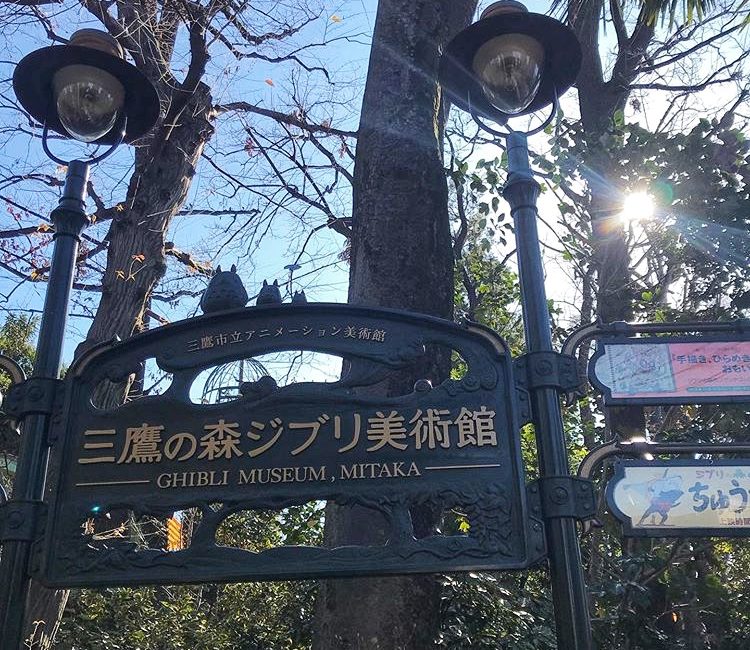
The Ghibli Museum is a unique and whimsical museum dedicated to the Japanese animation studio. Here you can gain insight into the history of the magical movies including Spirited Away, My Neighbor Totoro and all the amazing film from the Ghibli studio.
Due to its massive popularity and a limited number of visitors by day, it is very hard to get a ticket especially since they don’t sell tickets at the museum. You can book your advance ticket at Klook and pick it up once you landed at the airport. Take note you cannot specify your visiting time and only can accept the assigned time based on the day.
Expected duration : Two to three hours.
Ghibli Museum
- Admission Fee: ¥1000 for adult, ¥700 for ages 13-18, ¥400 for ages 7-12, ¥100 for ages 4-6, FREE for under 4 year old
- Nearest Station: Mitaka (JR Chuo Main Line)
- Reserve Ghibli Museum HERE !
Street Go-Karting Experience
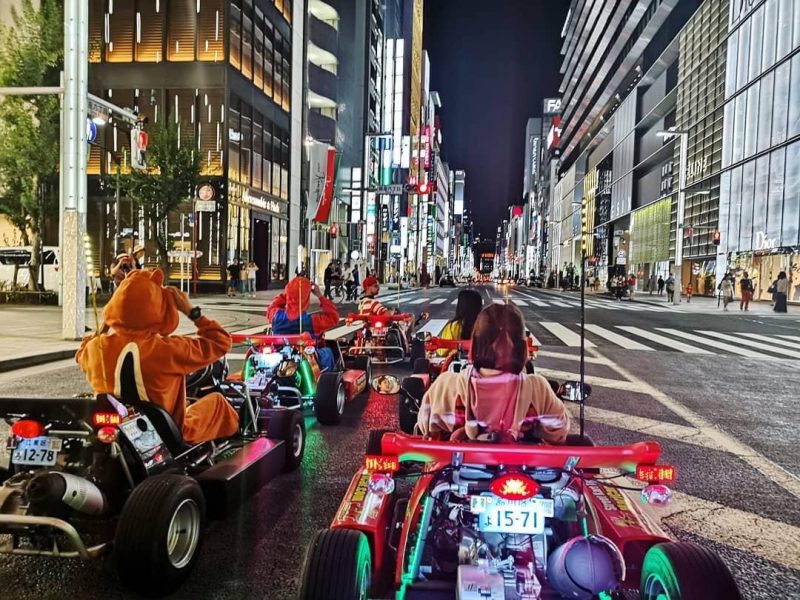
Probably one of the most memorable experiences during one of my Tokyo itineraries. The Street Go-karting experience was such an amazing experience and a highlight of my Tokyo trip!
Driving the streets by go-kart is one of the most thrilling ways to see Tokyo’s Otaku paradise. We recommended taking a 2-hour ride around Akihabara, Asasuka, Ueno, and Tokyo town in a cart with Mario or other costumes. Definitely, something that you have to experience when in Tokyo!
Street Go Karting Experience in Akihabara
- Location: Building Sasage B1F, 2-4-6 Sotokanda, Chiyoda-ku, Tokyo.
- Booking is a MUST! Reserve your Go-Kart Ride here
Robot Restaurants
If you want the Tokyo-only experience , head to the robot restaurant to enjoy the interaction with robots. This crazy 90-minute show will entertain you with high-tech laser displays, dances, and incredible high-energy robot shows.
Robot restaurant is definitely a cool place to witness Japan Nightlife. However, I suggest you lower your expectation of food and focus on the experience. You will see an array of dancers, robots, and dazzling special effects. If you aren’t comfortable with loud music and crazy lighting, I advise you to skip it. Else, people say that watching a show in a Robot restaurant is one of the must-do in Tokyo. You can reserve your ticket via Klook since they provide the cheapest piece.
Reserve your visit to Robot Restaurants HERE
Tokyo Travel Tips : The first show (4 PM) at a slightly cheaper price.
Overview: My 5 Days Tokyo Itinerary
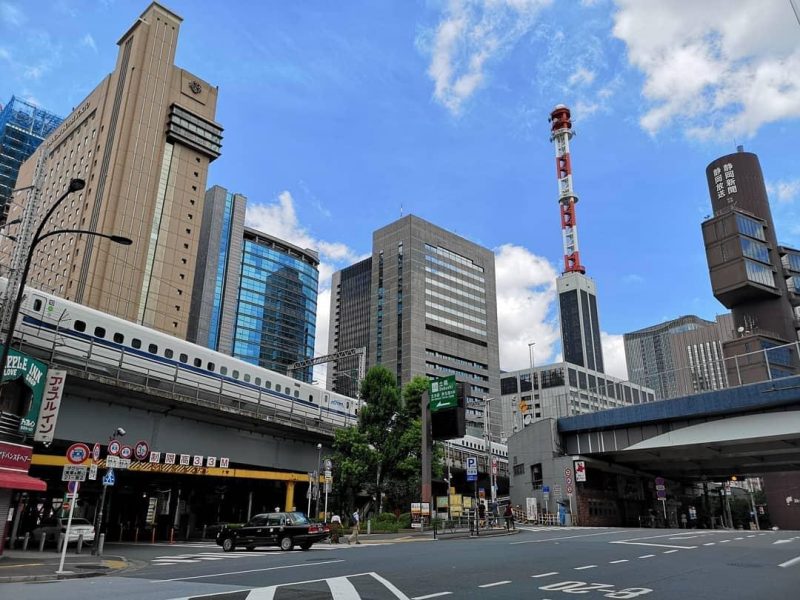
Last but not least, I hope this Tokyo itinerary has inspired you to spend a little more time in Japan’s most lively city. I absolutely love Tokyo and all the incredible experiences that I had here. The modern city and traditional cultural attraction, mouthwatering food, for sure there is something for everyone in this amazing city.
Here is some quick Tokyo travel guide when planning your itinerary:
How many days do I need in Tokyo? We recommended spending 3 to 5 days in Tokyo to fully explore this amazing city. 3 days in Tokyo city give you enough time to see this amazing lively city. Spend another 1 to 2 days to outskirt Tokyo such as Hakone, Mt Fuji, and Kawaguchi-ko.
How much Should I Budget For Food per day in Tokyo? The meal price can vary in Tokyo but the average cost of a meal in Tokyo is about ¥2,000 – ¥4,000. We plan for ¥5,000 – ¥7,000 on meals per day. You can still able found cheaper food (<¥1,000) and spend less money if budget is a concern.
How much money do I need per day in Tokyo? The total budget for accommodation, food, attractions ticket, and transport is average at about ¥20,000 per day in Tokyo.
How do you travel around Tokyo? Subways and trains are the best way to get around Tokyo. Just prepare a SUICA or Pasmo card to pay for your transport.
Is it worth getting a JR Pass in Tokyo? The JR pass could be worth it if you’re planning to travel for long-distance journeys such as from Tokyo to Osaka, Kyoto, Hiroshima, or Hokkaido, especially on a return trip. You don’t need JR Pass if only visiting Tokyo city.
Continue Read on
Last but not least, spending three days is absolutely the minimum amount of time to truly experience this city. While spending extra time to gain a better travel experience and discover the little hidden gem. If you’ve enjoyed this Tokyo itinerary, please make sure to include those amazing attractions on your trip. Enjoy your trip to Tokyo!
How To Plan your trip to Tokyo (Must read for first-time visitors) :
- A Guide For Meiji Shrine, Harajuku, Shibuya Itinerary
- Asakusa Ueno Itinerary: A Travel Tips Guide For Visitor
- Where To Stay in Tokyo? The Best Neighborhoods and Hotel
Tokyo Food Blog :
- Tokyo Food Guide: What and Where to Eat in Tokyo
- Mutekiya Ramen: Must Eat Tokyo Best Ramen
Ichiran Ramen Ueno: Best Ramen Shop in Ueno Tokyo
- Daikokuya Tempura: Asakusa Must Eat Food
- Chuka Soba Tomita Ramen: Tokyo Best Tsukemen
Tokyo Transportation Guide
- From Narita Airport To Tokyo: How To Decide Your Best Transport
Planning on an easy day trip from Tokyo to Hakone or Kamakura ? Check out our travel guide.
- Where To Stay in Hakone: Best Ryokan and Hotel Guide
- Kamakura Itinerary: A Travel Guide Blog
You Might Interested:
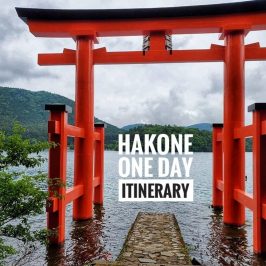
Hakone Itinerary: Our Travel Guide Blog & Budget Tips
Ultimate Hakone one day itinerary with Hakone Free Pass. This money saving pass greatly help...
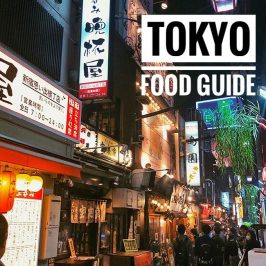
Tokyo Food Guide: What To Eat in Tokyo
Here is the Tokyo food guide for what and where to eat in Tokyo. A...
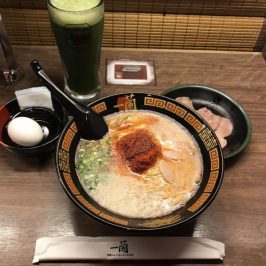
Looking for best ramen in Tokyo, Ichiran ramen is a must-try on Japan food. We...
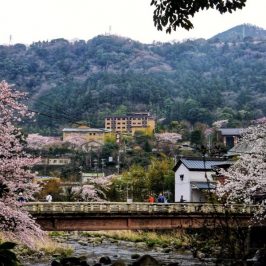
Best Ryokan Stay in Hakone: Ichinoyu Honkan Review
Last updated on June 13th, 2024 Looking for the best ryokan hotel stay in Hakone?...
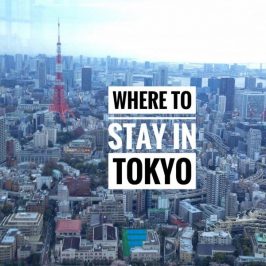
Where To Stay in Tokyo: Top 7 Best Areas with Hotel Pick
To help you choose where to stay in Tokyo, here's our guide to the best...
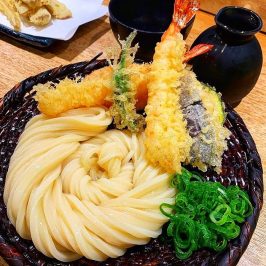
Udon Shin Tokyo: Delicious Freshly Handmade Udon
Last updated on June 13th, 2024 For food lovers who craving noodles dishes in the...

All the insider's travel tips in Korea
The Ultimate Guide to Osaka’s Iconic Street Food
Located in the Kansai region, Osaka offers a captivating blend of rich history, vibrant culture, and most importantly; a wide array of culinary delights, all at a somewhat slower pace compared to the hustle & bustle of Tokyo .
Osaka has long been revered as Japan’s culinary capital, earning the nickname “tenka no daidokoro” or “the nation’s kitchen” . This vibrant city’s food culture is deeply rooted in its identity as a port city, which fosters a diverse and innovative culinary scene. Street food plays a crucial role in Osaka’s culinary scene, embodying the city’s motto of “kuidaore” or “eat until you drop” . The city’s streets, particularly in areas like Dotonbori and Kuromon Ichiba, are filled with vendors serving up local specialties to tourists and natives alike.
In this blog, we’ve compiled our top must-try street food in Osaka.
- Okonomiyaki
- Kushikatsu
1. Takoyaki
View this post on Instagram A post shared by Jessica Rae Mayo (@happydementor)
Takoyaki is a quintessential Osaka street food. Originating in the 1930s, these golf ball-sized snacks are made by pouring a wheat flour-based batter into specially molded pans and filling them with diced octopus, green onions, and pickled ginger. Although traditionally topped with a sweet-savory sauce, mayonnaise, bonito flakes, and aonori seaweed, takoyaki has inspired numerous variations, including cheese, mentaiko, and even sweet flavors . For the best takoyaki in Osaka, we recommend trying Takoyaki Doraku Wanaka in Sennichimae, Kougaryu in Amerikamura, or Takoyaki Juhachiban in Dotonbori.
2. Okonomiyaki
View this post on Instagram A post shared by 名古屋グルメモンスター👾とももんげ (@tomomonge_nagoya)
Japan’s version of a savory pancake, Okonomiyaki gained nationwide popularity during the 1970 Osaka World Expo. The iconic Osaka version of the dish features a fluffy batter made with flour, eggs, dashi, and yamaimo (mountain yam), mixed with shredded cabbage and various ingredients like pork belly, seafood, or cheese . To try the best okonomiyaki in Osaka for yourself, visit the bustling Dotonbori district . Here, specialized restaurants serve this beloved dish, and many spots even allow customers to grill it at the table!
3. Kushikatsu
View this post on Instagram A post shared by 【太田黒の大阪グルメレポ】📍天満グルメ 心斎橋グルメ (@osaka.otaguro)
Kushikatsu is a beloved street food featuring skewered and deep-fried meat, seafood, or vegetables. This crispy delicacy originated in Osaka’s working-class neighborhoods during the 1920s. When eating kushikatsu, remember the golden rule: no double-dipping in the shared sauce! For the best kushikatsu experience, head to the Shinsekai district near Tsutenkaku Tower .
- Osaka Tsutenkaku Tower Observation Deck Admission Ticket
View this post on Instagram A post shared by Urban Dzindzinovic (@dzindzinovic)
Ikayaki is a grilled squid dish known for its smoky flavor and tender texture. Chefs usually grill the whole squid over charcoal, brushing it with soy sauce for a savory glaze. However, some vendors slice the squid before grilling, creating crispy edges. Other popular variations include stuffed ikayaki with cheese or vegetables. For the best ikayaki, visit Kuromon Ichiba Market in central Osaka where skilled vendors serve this delicacy fresh off the grill.
Check out these other Osaka activities:
- OSAKA SKY VISTA (Open Top Double-decker bus)
- Osaka Tombori River Cruise Ticket
- Osaka Koji Kinutani Tenku Art Museum Admission Ticket (Arriving Soon!)
- Kyoto & Nara 1 Day Tour from Osaka/Kyoto
We hope this guide has helped you uncover the street food in Osaka for your next visit to Japan! To discover even more of the best things to do in Japan, visit Trazy.com , Your Travel Shop for Asia !

Leave a Reply Cancel reply
Your email address will not be published. Required fields are marked *
This site uses Akismet to reduce spam. Learn how your comment data is processed .
- All about SIM Card
- All about WiFi
- Korea Travel Itineraries
- Getting Around Korea
- National Holidays
- Top 10 Things to Do
- Deoksugung Palace & Jeongdong Walking Tour
- Secret Garden & Bukchon Hanok Village Walking Tour
- Seoul K-drama Shooting Spots Walking Tour
- Namsan Park & N Seoul Tower Evening Hiking Tour
- Seoul City Wall & Ihwa Mural Village Walking Tour
- Seochon Village Walking Tour
- Seoul Hiking Tour: Inwangsan & Bugaksan
- Everland Guide
- Everland Ticket & Packages
- Lotte World Guide
- Discount Tickets
- Han River Cruise Guide
- Han River Cruise Ticket
- Hanbok Rental Service
- Hanbok Rental Guide
- Nami Island Guide
- Nami Island Tours
- The Garden of Morning Calm
- DMZ & JSA
- DMZ & JSA Tours
- Mt. Seoraksan
- Jeju Popular Attractions
- Busan Popular Attractions
- Rest of Korea
- Cherry Blossoms
- Spring Must-Dos
- Water Activities
- Summer Must-Dos
- Autumn Foliage
- Autumn Must-Dos
- Ski & Snowboard
- Winter Must-Dos
- Festivals & Events
- K-Pop & K-Drama
- K-Beauty Guide
- Visit Trazy.com
- General Tips
- Beauty, Hair & Skin Care Service
- Korea Shopping Guide
- Food & Restaurant Guide
- Cooking Class & Food Tours
- Survival Tips
Related Post
Shopping list: top 16 things to buy in tokyo, best day trips from osaka, the ultimate guide to exploring mount fuji, 4 best day trips from tokyo, the ultimate guide to transportation around tokyo, japan, osaka & kyoto 4-day itinerary | japan travel guide.
or with email
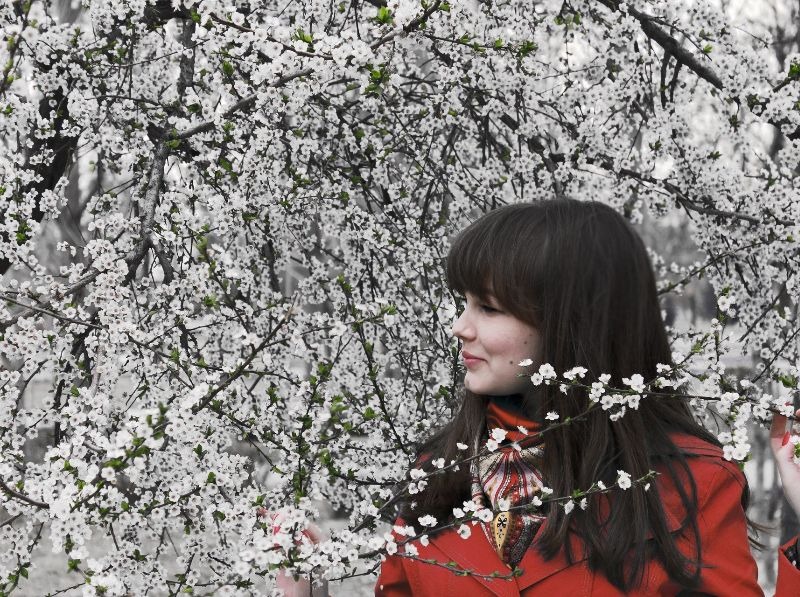
17 Japan Travel Budget Tips for Savvy Spenders
Updated January 10, 2022
If you’re all about budget travel, great news—your trip to Japan doesn’t have to break the bank. With these 17 Japan travel budget tips, you’ll be ready to take on new adventures without incurring crazy expenses. This essential guide includes everything from accommodations and transportation to food and attractions.
Transportation
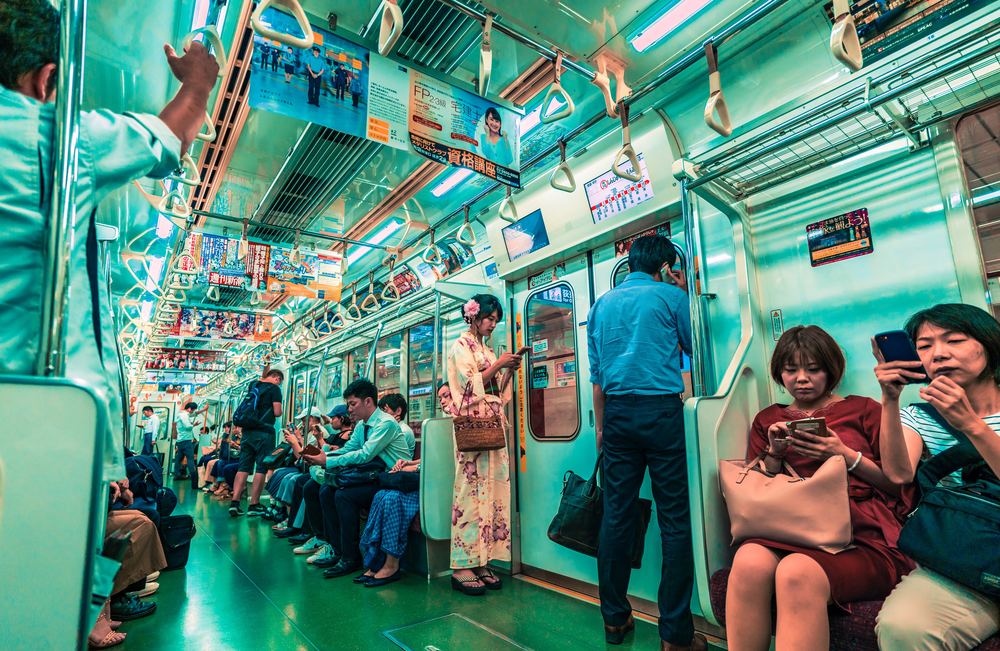
#1—Buy your plane tickets at least 2 months in advance
Finding inexpensive airfare to Japan can seem a little daunting, but the key is to purchase any plane tickets at least 60 days before you plan to leave. Locals in Japan tell us that ticket prices can rise $500 or more when you travel during major holidays, like Golden Week , Obon , Christmas, and New Year’s.
Local tip: If you don’t mind one- or two-stop flights, budget airlines like Cathay Pacific and Asiana Airlines usually offer flights to Japan that are several hundred dollars cheaper than those of major airlines.
#2—Pay for trains with a Japan Rail pass
Even if you’re only staying in Japan for a short time, getting a Japanese Rail (JR) pass is one of the wisest budget moves you can make. The JR pass is essentially a discounted train pass for tourists in Japan, covering train lines in six regions. Each region offers different passes for different numbers of days, starting as cheap as $21 for the day with JR Kansai or as much as $248 for two days with JR Hakone .
Local tip: JR passes must be purchased online prior to arriving in Japan. It can be confusing to figure out, but since the result is so rewarding (and budget-friendly). You can also use apps like Jorudan to sketch out your public transit plans.
#3—Know which type of subway pass works best
Our local trip planners in Japan tell us you definitely will need a subway pass when visiting Japan’s best cities, especially big metropolises like Tokyo and Kyoto. The type of subway pass you’ll need will vary by where you are, how long you’ll be there, and how much you’ll use it. For example, the Tokyo Metro offers 24-, 48-, and 72-hour passes for under 1,500 yen (around $15)—significantly cheaper than paying 170-310 yen per trip. As they design your custom itinerary, we can help you with what sort of pass to get—and how to use it.
#4—Use buses for short-distance travel
Since Japan is very safe, public buses are great ways to visit cities like Kyoto or Tokyo without spending beaucoup bucks on a taxi or Uber in Japan. Kyoto public buses charge a flat 230 yen fare within specific districts, and Tokyo public buses similarly charge a flat 210 fare per trip.
Overnight buses from companies like Willer Express are also available for cross-country trips, departing from two major hubs—the Yokohama City Air Terminal and the Shinjuku Expressway Bus Terminal. Overnight buses are known for their relatively low prices, averaging $90 for trips 10 hours and up.
Local tip: Overnight buses can add considerable travel time to your itinerary. You could also take more expensive domestic flights from Skymark , Peach Air , or Vanilla Air to cut down on travel time.
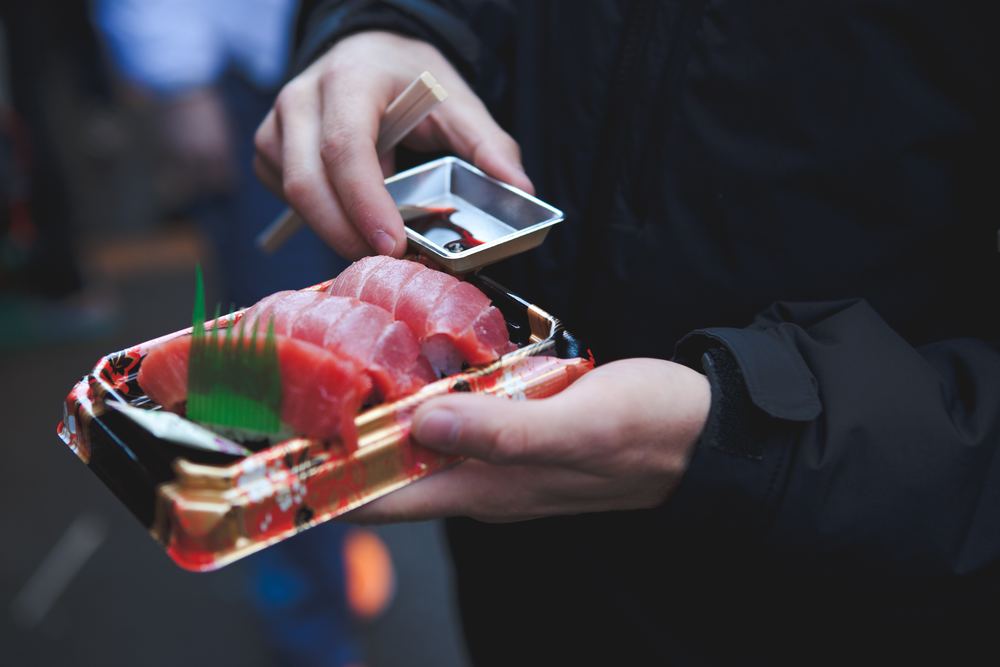
#5—Get cheap snacks at 100-yen shops
100-yen shops are like American dollar stores on steroids. Since 100 yen is roughly equivalent to $1, you can easily buy inexpensive but authentic Japanese food to supplement your meals throughout the day (or to count as meals themselves—no judgment here!). Just make sure to hang onto any pocket change—Japanese locals note that most 100-yen stores only accept cash.
#6—Go to 7-11 for meals under 500 yen (USD$5)
Japan’s 7-11s are to American 7-11s as a gourmet steak is to a rock. Seriously! Japan’s 7-11s take cheap, fresh food to another level, rolling out fresh sushi, bento (lunch) boxes, onigiri rice rolls, and pastries. Meals range from 120 yen to 600 yen, depending on how much food is included. Importantly, locals tell us that 7-11 is also the only conbini (convenience) store in Japan to accept foreign credit/debit cards.
Local tip: For other conbini stores that produce fantastic, cheap meals, Japanese locals suggest checking out stores like Lawson, FamilyMart, Circle K, and Ministop.
#7—Eat at conveyor-belt sushi restaurants
Conveyor-belt sushi (kaiten-zushi) restaurants prove that Japan has this whole fast food thing figured out. These futuristic restaurants are popular just about everywhere in Japan, especially since you pay by the plate, averaging only about 100-300 yen ($1-3) per dish. In terms of places to go in Japan, kaiten-zushi restaurants are a must-go for happy tastebuds and wallets.
#8—Fill up on street food
No matter which Japan destinations you choose, street food is a staple of diverse, delicious, and cheap travel. The key is to know where the locals eat—for example, locals tell us that tourists generally don’t know that you can get a fabulous monjayaki pancake for under $10 on Tsukishima Street in Tokyo. You can also get some mean takoyaki (octopus balls) for $8 in Osaka’s Kougaryu neighborhood and okonomiyaki (noodle crepes) for $4 in Hiroshima.
#9—Remember that some restaurants charge unusual fees
Since many Japanese customs differ from those in the U.S., it’s important to know what is expected in restaurants, especially since you’ll encounter unfamiliar fees. It’s true that there is no tipping in Japan; however, you may be charged 500-700 yen for otoshi , a table fee added when a server gives you a small, unordered appetizer. (Think free chips and salsa, but without the free.)
Accommodations
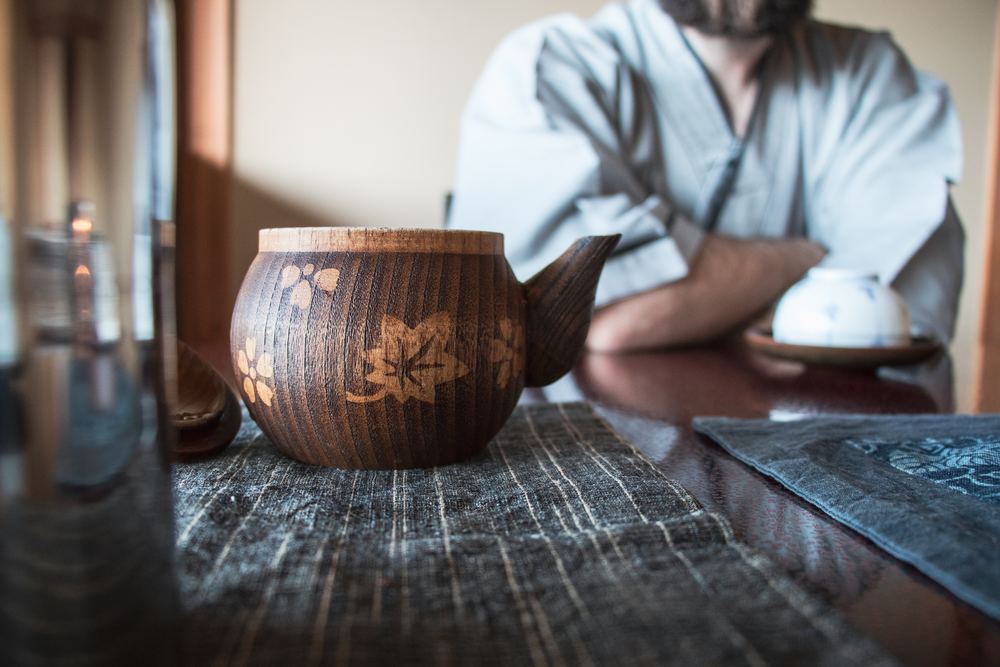
#10—Keep it minimalist at a capsule hotel
Capsule hotels are slightly bizarre but fun Japan accommodations for travelers on budgets. Guests sleep in their own futuristic pods, stacked on top of each other and containing a single bed, TV, and clock. Bathrooms, storage, and common rooms are shared, but it’s worth it for just $20-$40 per night.
#11—Spend the night at a Buddhist temple
If you want to travel in Japan in a different way, consider spending the night at a Buddhist temple. You can find shukubō , temple lodgings for pilgrims and adventurous travelers. Averaging USD$50-$90 per night, there are few shukubō in Japan, but they’re 100% worth the addition to your Japan itinerary.
Local tip: For other traditional Japanese lodgings, think about staying overnight at ryokans (traditional inns) and minshuku (family-owned B&Bs). Both cost USD$150-$250—a little pricier than shukubō but a unique way to enjoy Japanese culture.
#12—Rent an Airbnb
Airbnbs became legal in Japan in 2018, so you’re now good to book your Japan Airbnb anytime and anywhere. One-bedroom apartments average $40-$70 a night, with the price dependent on how long you stay, how many rooms you need, and what features you want (i.e., pool or balcony). Some Airbnbs in Japan also charge a $40-$50 cleaning fee.
Local tip: If you're staying in an Airbnb in Japan, bring a small gift for your host. Gifts are a big and important part of Japanese culture, and our local trip planners tell us that people really appreciate the gesture.
#13—Bed down at a hostel
Budget travelers in Japan often choose to stay in hostels, which average $30-$50 a night and are usually close to cool things to do in Japan. You’ll find different types of hostels depending on which city you’re in—for instance, Tokyo is known for its “love hotels” ($50-$100 rooms used for under-the-radar romance) and manga kissa (manga cafes where you can play video games and catch some Z’s).
Attractions
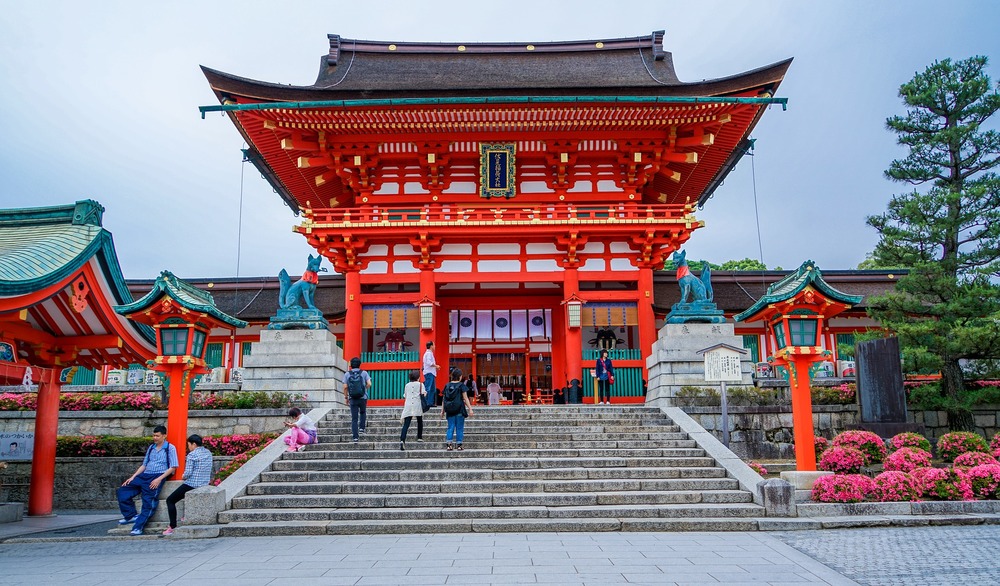
#14—Travel during Japan’s off-peak season
Save hundreds of dollars on airfare to Japan and accommodations by exploring Japan during the country’s off-peak season. Actually one of the best times to visit Japan, the off-peak season lasts from October to March (with the exception of Christmas and New Years). With fewer tourists vacationing and sightseeing, you’ll encounter much shorter lines and significantly lower prices.
We can help you find the best budget-friendly deals, especially during Japan’s major events like Golden Week and Obon .
#15—Take advantage of free activity passes
Japan’s free activity passes can be more aptly called comprehensive or all-inclusive. The passes sell for around $50 and cover a range of attractions in Japan’s coolest places to go, including Tokyo, Kyoto, and Osaka. For example, you can buy the Hakone Free Pass for around $60, which gives you 2-3 days worth of unlimited bus, ferry, and train rides, as well as discounted rates on the top things to do in Tokyo.
Local tip: Buy your free activity pass at a subway or train station within the city you want to explore.
#16—Know which attractions offer free entry
When it comes to budget travel in Japan, it pays to know which fun things to do have low entry fees or (even better) are totally free. For example, locals report that the Tokyo Metropolitan Government Building offers free 360 birds-eye views of Tokyo (and Mt. Fuji, on a sunny day). LonelyPlanet also recommends major landmarks like the Hiroshima Peace Park and Kyoto’s Imperial Palace , which are free to enter and have inexpensive tours.
#17—Design your own self-led tours
Since tours of Japan’s cities and landmarks average $80 per person, your travel bill will add up pretty quickly with the more tours you take. In this case, the best solution is to create your own self-led tours. Not only will you end up saving hundreds of dollars, but you’ll get to visit off-the-beaten-path places in Japan that few tourists ever see.
Leave a comment:

Select Account Type
Sign-up with
Almost there!
Find booking.
How should we contact you?
Thank you! We'll get back to you as soon as possible!
Click here to register and track your question!
If you would like to follow up with us:
+1 (855) 782-3006
Forgot your password?
Enter your email address below and we'll send you a reset link:

IMAGES
VIDEO
COMMENTS
Guided Tours Of Japan. We will provide tips on how to plan your own Japan 2 week itinerary, but I understand that Japan can be difficult to manage on your own. We have some recommendations for guided tours that included between 12 and 14 day itineraries. Intrepid Travel offers a 12 day Real Food Adventure In Japan.
Welcome to my RyuKoch Japanese food and Japan travel blog ! Here it's all about the fascinating world of Japanese culinary and travel tips for unforgettable experiences in Japan. Get inspired by traditional and trendy Japanese recipes as well as valuable tips for your next stay in the land of the rising sun.
Table of contents. Day 1: Traditional Snacks in Asakusa and Kitchen Utensils in Kappabashi. Day 2: Tsukiji Fish Market & Craft Beer in Yanaka. Day 3: Sushi Making Experience & Michelin-Starred Ramen. Day 4: Fancy Lunch in Ginza & Izakaya Hopping in Shinjuku. Day 5: Street Food in Sunamachi. Japan Wonder Travel Tours in Tokyo.
5 Secrets to Authentic Japanese Cooking! Sign up to receive our FREE email series on Japanese cooking tips, and join the JOC community of 140,000 people. Just One Cookbook is a Japanese food blog with 1000+ authentic home-style recipes. Learn the cuisine with easy step-by-step photo instructions and videos.
10. Okinawa. Lastly introduced here is Okinawa, a tropical island in Japan. Having a unique culture and history stemming all the way from the Ryukyu Kingdom period, Okinawa has also produced many unique gourmet foods. Since the Ryukyu Kingdom period, pork cuisine has been widely spread and developed in Okinawa.
BY BUS: You can travel from KIX to Kyoto station by limousine bus as well. They operate on a 24-hr schedule so this may be the better option if you're arriving at off-hours. The journey takes about 100 minutes. You can refer to the Kansai Airport transportation website for a timetable.
Finally, the highlight of our meals in Kyoto. While in Arashiyama (嵐山), we made a reservation at Nishiki restaurant (京嵐山 錦), which served kaiseki ryori. In Kyoto, kaiseki ryori can range anywhere from USD$50 to USD$300 per person. We selected a restaurant that offers a variety of set courses from 7,000 to 12,500 yen (as of July 2023).
Common tsukemono you might receive with a Japanese meal includes pickled cabbage, kimchi, or daikon radish. Sometimes with bright colors and crunchy textures, tsukemono always make for a nice accompaniment to any meal by adding a freshness and cleansing element. 34. Udon.
Tonkatsu. Tonkatsu is a classic Japanese dish that's all about comfort and flavour. It's a breaded, deep-fried pork cutlet, served with shredded cabbage, rice, miso and a tangy sauce. The name "tonkatsu" comes from "ton", meaning pig, and "katsu", short for "katsuretsu", the Japanese word for cutlet.
Oyster/ Hiroshima. Hiroshima boasts the largest production of oysters and it is oyster paradise! You can get grilled oysters or raw oysters on the street stalls or you can dine in at the restaurant and enjoy flavorful oysters to your heart's content. Where to eat: Ekohiiki. Open 11.30am - 2pm, 5pm - 11pm.
According to our food tour guide, Golden Gai is a favorite hangout among Tokyo's creatives like artists, photographers, film directors, and writers. Like Omoide Yokocho, it's teeming with character and a great place to get a drink. Check out Get Your Guide for a list of tours that take you to Golden Gai. 2.
Here is our Japan Food Guide covers everything from the best, traditional, and must-try Japanese dishes to navigating Japan's best restaurant scene. ... Japan Itinerary Blog: Perfect Travel Route for 7, 10, 15 Days. August 10, 2021. Here we give you travel tips for Japan, together with a perfect Japan itinerary for... Emily August 10, 2021 ...
One of the most popular snacks to eat in Japan is Onigiri. Onigiri are rice balls formed into triangular or round shapes and wrapped in seaweed (nori). Some are filled with fish (tuna, salmon, mackerel, shrimp, etc), chicken, pork, vegetables, egg and fried food, like tempura and tonkatsu.
6. Tonkatsu. Tonkatsu is a popular Japanese dish based on western pork cutlets, where a thick slice of pork is dipped in a flour and beaten egg batter, coated in breadcrumbs and fried in oil. There are both sirloin and fillet tonkatsu, with the fillet tonlatsu being more expensive.
Whether you're planning to visit Japan's Golden Route (Tokyo - Kyoto - Osaka - Hiroshima) or wander off the beaten path, my Japan travel guides cover all the bases. Create your own Japan travel story by exploring lesser-known cities, enjoying cultural experiences and discovering hidden gems to enrich your trip. Golden Route. Off the ...
Days 15 & 16: Hiroshima. Day 17: Train to Hokkaido. The train to Hokkaido, Japan's northernmost island home to volcanoes and rugged landscapes, takes 15-16 hours by train. There are sleeper cars available, but you'll have to pay a surcharge (around 9,500 JPY) for a bed.
Or, why not visit Kuromon Market with its seafood-laden food stalls. Taste the beauty of Japan on a culinary adventure and get a deeper insight into the nation's culture. A Japan food tour is a must-do travel experience and one you'll never forget! Image: Sushi!!! / 鮨 by Toshihiro Gamo, used under CC BY-NC 2.0 DEED / Edited from original
Eat your way around an old Post Town on the Tokaido Trail during a Fabulous Fuji City Local Food Tour →. Gotemba. Learn how to find your zen, more about local culture and delicious local food on a Gotemba Local Hidden Gems Tour →. Kamakura. Make your way south to coastal Kamakura, one of Japan's ancient capitals.
This 2 weeks in Japan itinerary will cover: How to explore Japan on your own with confidence; Complete 2 Weeks in Japan itinerary, day-by day guide including costs, things to do, where to stay, where to eat & getting around for:. DAYS 1-5: Tokyo (including day trip to Mt Fuji) DAYS 6-10: Kyoto DAYS 10-12: Hiroshima (including day trip to Miyajima) DAYS 12-14: Osaka (including day trip to Nara)
Of course, traditional cuisine such as sushi, ramen, sukiyaki, tempura, and Japanese sweets are a "must try" while visiting. Drinks in Japan range from a variety of flavorful soft drinks, teas, canned coffee, soy drinks, to Japanese draft beer, sake (Japanese rice wine), and Japanese whiskey. All Blogs. Travel. Culture.
Add eggs, dashi and salt and whisk in the bowl. Put the oil into the pan. Put 2/3 of 1 egg and when the small bubbles appear, poke the bubble to release the air. When the egg half cooked, roll the egg to the side. Add the oil and then add little 1 egg again, and roll the egg to the side and repeat the process.
10 Events and Things to Do in Japan in July 2024. The temperature in Japan is rising, and so is the fun! July is a beautiful time to experience local culture and exciting activities or explore pristine nature. There are festivals, sporting events, and plenty of places to escape. Make sure you're keeping cool, and let's explore 10 events and ...
Pre-Trip: Tokyo Travel Tips. How Many Days Need in Tokyo. Where To Stay in Tokyo. Planning on Tokyo Itinerary. Day 1: Harajuku, Shibuya and Roppongi. Day 2: Asakusa, Ueno, Akihabara. Day 3: Tsukiji Market/Toyosu Market, Tokyo Tower, Odaiba. Day 4 and Day 5: Day Tour Outside Tokyo. Kamakura and Enoshima.
Japan's version of a savory pancake, Okonomiyaki gained nationwide popularity during the 1970 Osaka World Expo. The iconic Osaka version of the dish features a fluffy batter made with flour, eggs, dashi, and yamaimo (mountain yam), mixed with shredded cabbage and various ingredients like pork belly, seafood, or cheese.
Updated January 10, 2022If you're all about budget travel, great news—your trip to Japan doesn't have to break the bank. With these 17 Japan travel budget tips, you'll be ready to take on new adventures without incurring crazy expenses. This essential guide includes everything from accommodations and transportation to food and attractions.TransportationTrain in Tokyo | Jezael Melgoza ...
The Pokemon café is, without a doubt, one of Japan's most popular themed cafés, requiring reservations that can be made 31 days beforehand. Kids will love the Snorlax's Tummy Filling Naptime lunch plate, or the crowd-favourite Pikachu plate. For young kids, there are also special children's menu items.
Japan travel news. Our rail pass calculator is now handling regional passes. ... Temples Shrines Castles Onsen Food and Drink Manga and Anime Gardens Hiking Shopping Flowers. Plan a Trip. Before You Go Itineraries Tours Learn Transportation Accommodation Living in Japan. Blogs. 3.11 Recovery Reports Chotto Zeitaku Japan Wild Japan Among the ...
There will also be a food area where visitors can taste the best homemade food selected from all over Japan and the pride of the creators. This event is a great opportunity to fully enjoy the appeal of handmade products and Japan's creative culture and shop sustainably. Official Website: Handmade in Japan Festival Summer 2024 (Only in Japanese)
Bergmann, CC BY-SA 3.0, via Wikimedia Commons By far one of the most famous festivals in Japan is the Gion Festival which has been held by the Yasaka Shrine in Kyoto since the 9th century. Its inception was caused by an epidemic at that time when people wanted to put the gods in a better mood.
Flights generally open for booking about a year ahead of time, and the airfare will change often between then and takeoff. Although you can book just a couple of weeks before the departure date in ...